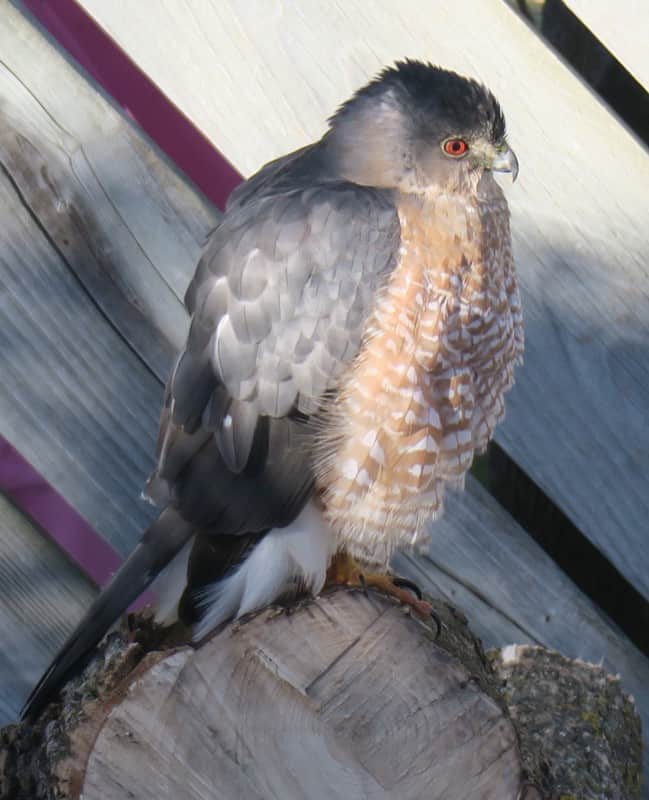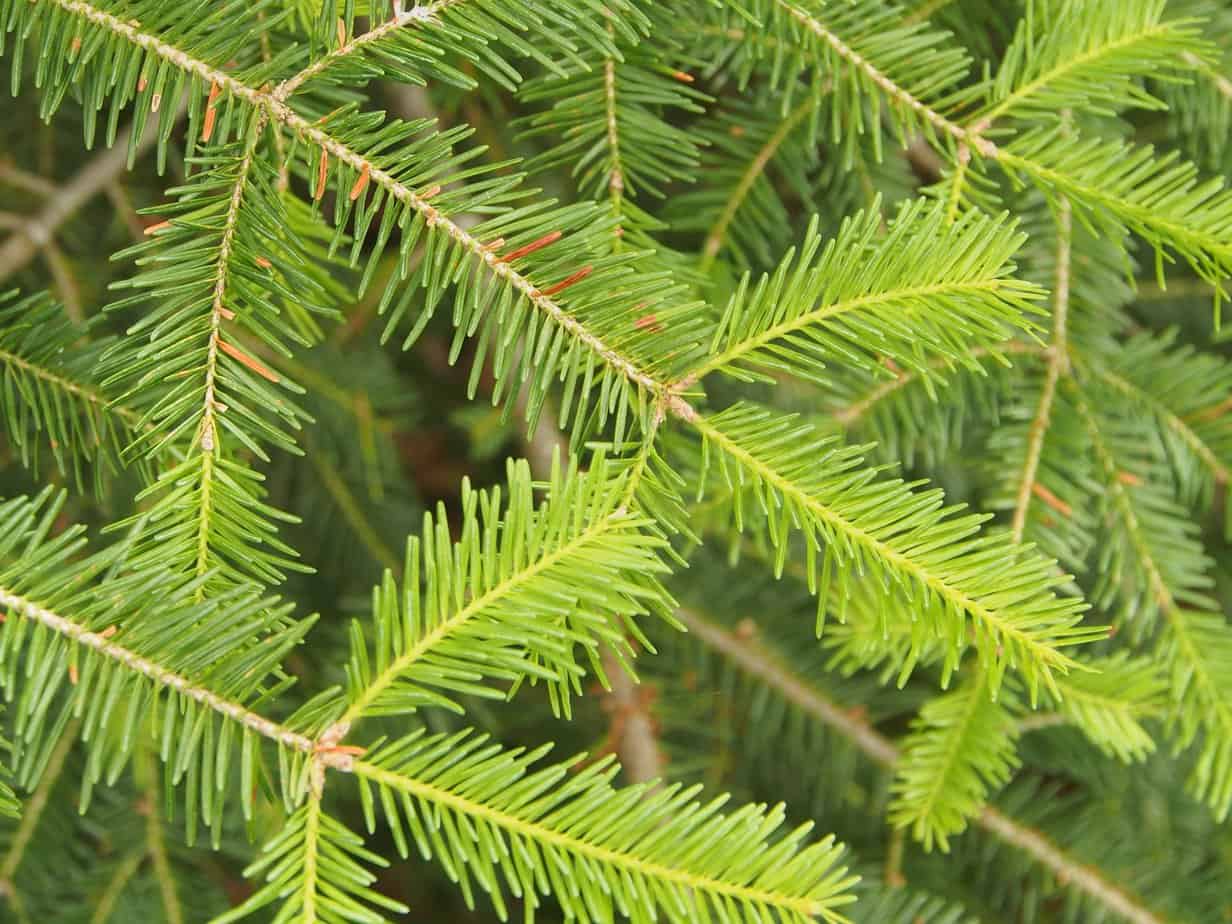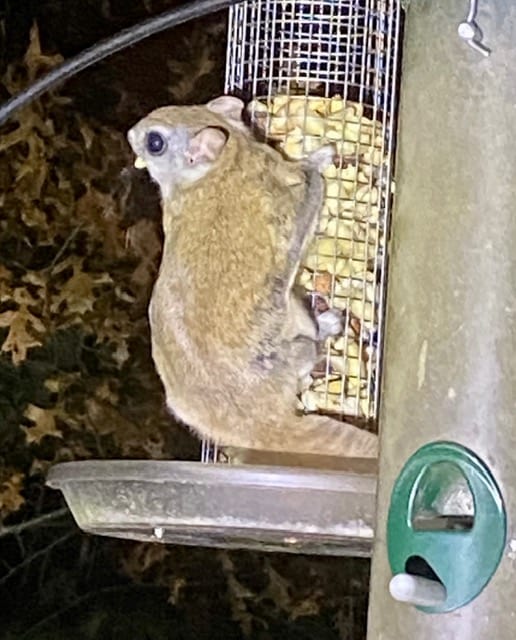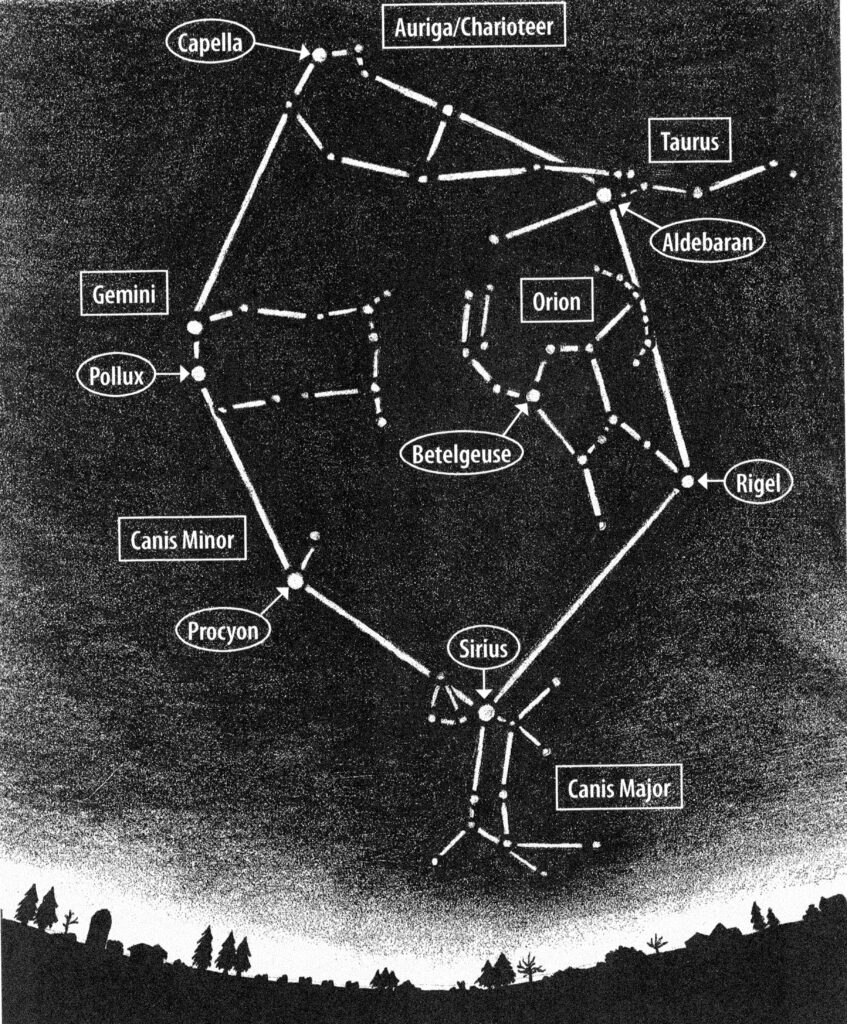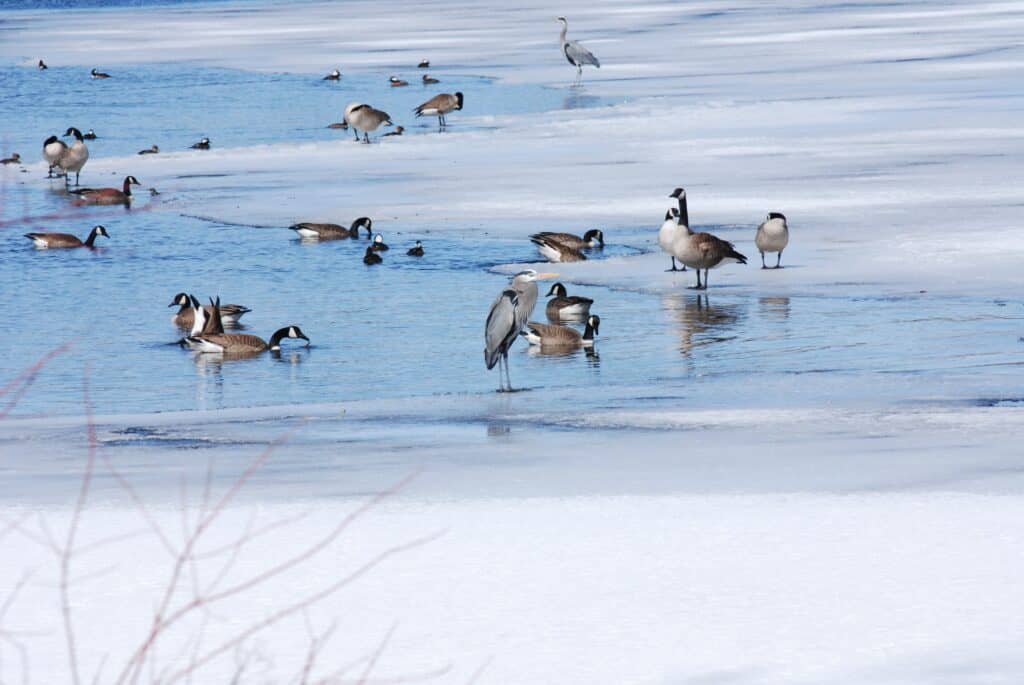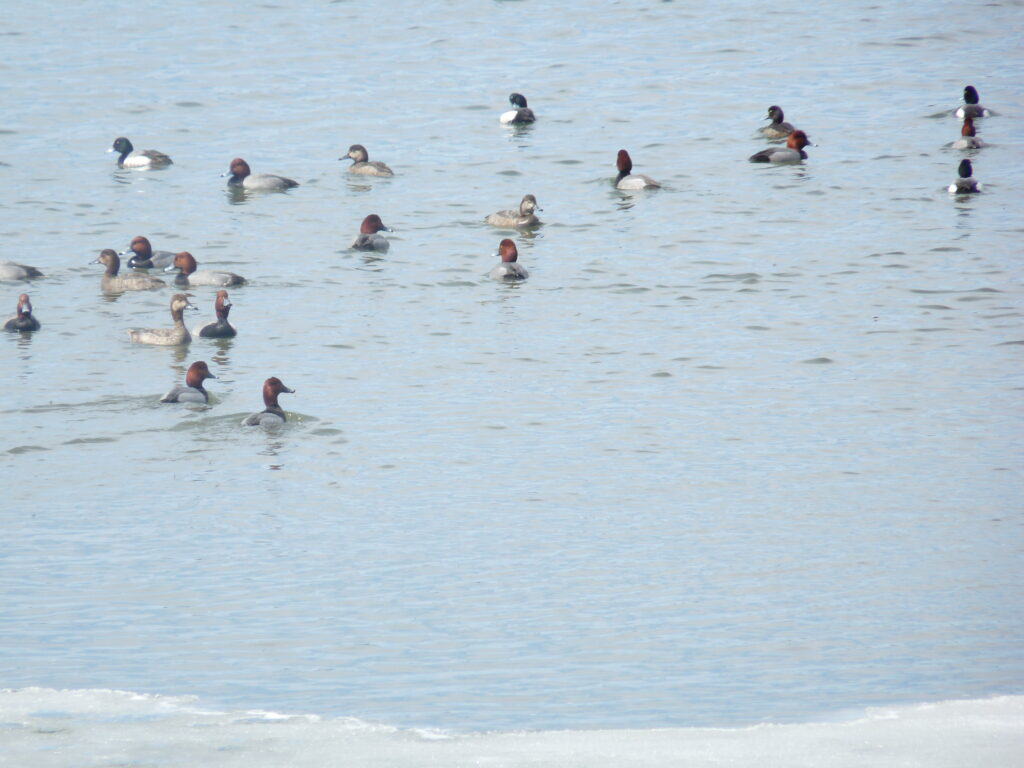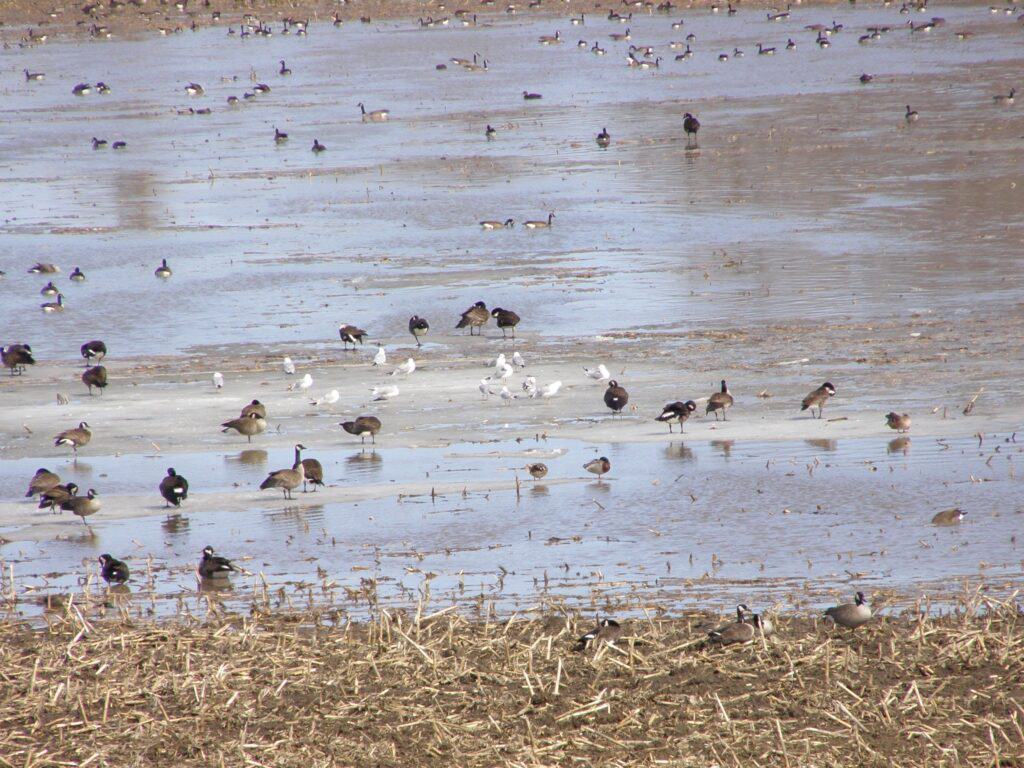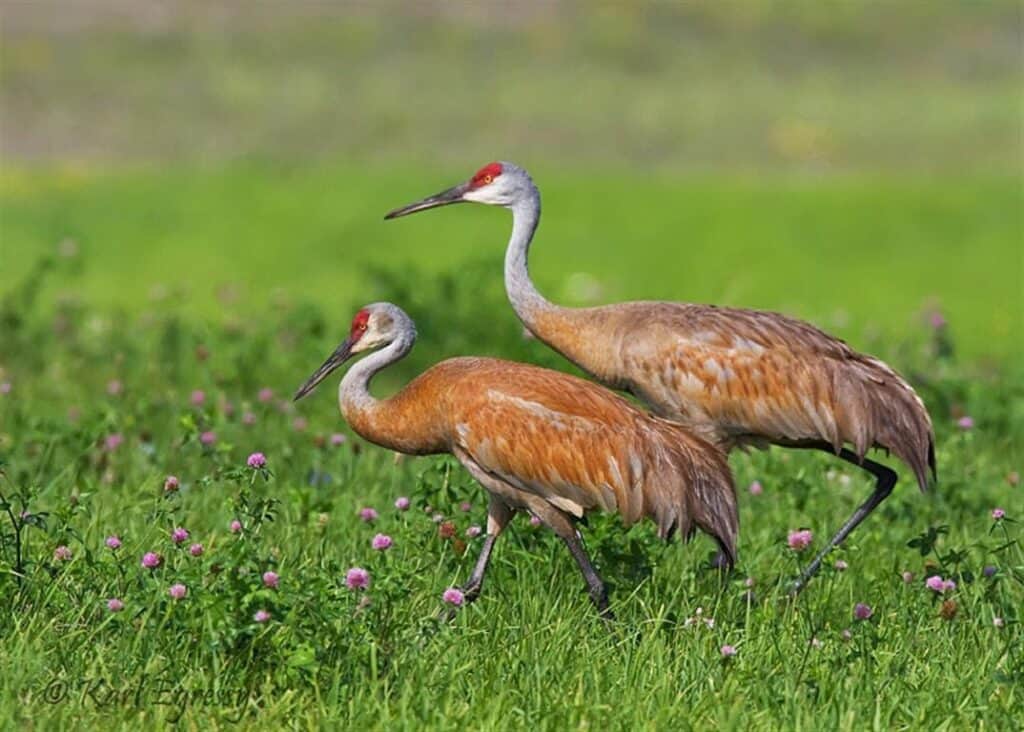For each of the months of the year, you will find a sample of typical nature events in the Kawarthas to watch for. Although many of the dates are only an approximation, the order of events generally remains the same, especially in spring. Some events occur over the entire month, while others are more restricted in time. Many are dependent on the vagaries of the weather and our changing climate.
For a more exhaustive list broken down by group (e.g., birds, mammals, plants), please refer to my books “Nature’s Year in the Kawathas” (2002) and “Nature’s Year in Central and Eastern Ontario” (2012).
Jan | Feb | Mar | Apr | May | Jun | Jul | Aug | Sep | Oct | Nov | Dec
January – Silence and Survival
“Whose woods these are I think I know.
His house is in the village though;
He will not see me stopping here
To watch his woods fill up with snow.”
– Robert Frost, Stopping by Woods on a Snowy Evening
Seen or unseen, awake or sleeping, life is still all around us, even in January. It just takes a little more work to see and appreciate. More than any other month, we marvel at how each species in its own unique way has adapted to surviving winter. To the curious and attentive observer, there is wonder in the countless strategies used by plants and animals to withstand, this, the cruellest of times.
__1 — In the first week of January, sunrise is later than at any other time of the year. In fact, the sun doesn’t peak over the horizon until 7:49 a.m. Compare this to June 20 when the sun rises at 5:29!
__2 — In our woodlots, mixed flocks of foraging chickadees, nuthatches and woodpeckers bring life to the seemingly empty winter landscape. These birds are very receptive to pishing and the chickadees, in particular, can usually be coaxed to come in quite close.
__3 — The numbers of some winter birds fluctuate widely from year to year. These species are referred to as winter “irruptives,” and the years in which they are particularly common are called “flight years.” Last winter was an excellent flight year for pine siskins. The only winter irruptive present this year in good numbers is the bohemian waxwing.
__4 — Watch for ruffed grouse at dawn and dusk along tree-lined country roads. They often appear in silhouette as they feed on the buds of trees such as the trembling aspen.
__5 — Even during the winter, woodpeckers defend feeding territories through a combination of drumming and calling. The loud “wuk-wuk-wuk” cackle of the pileated woodpecker can sometimes be heard on winter mornings.
__6 — Bald eagles can often be seen on Lake Katchewanooka, in the area of Petroglyphs Provincial Park and along the Otonabee River. They also turn up quite regularly around Little Lake.
__7 — Watch for small numbers of common goldeneyes, common mergansers, and black ducks all winter long on the Otonabee River between Rice Lake and Lakefield. Some birds can usually be seen at Young’s Point, as well.
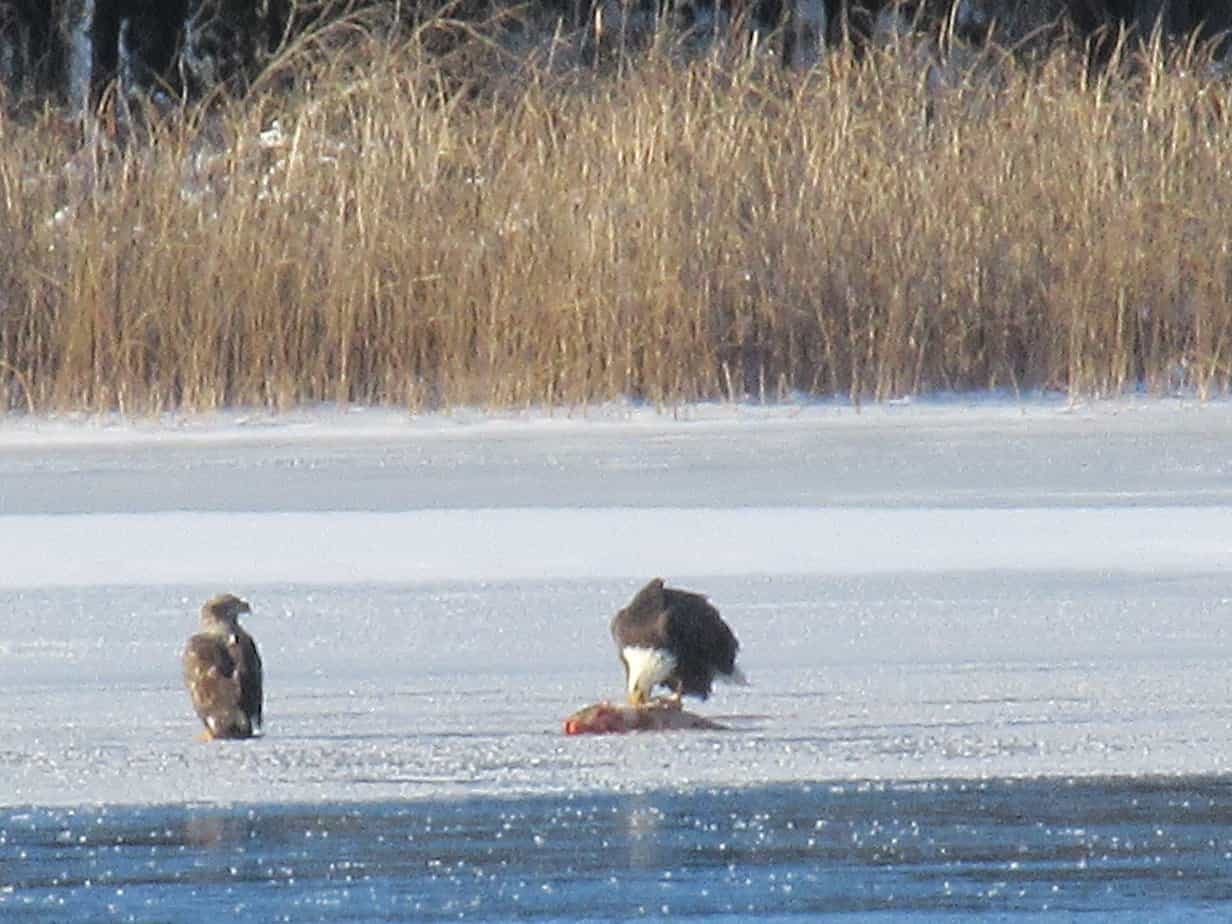
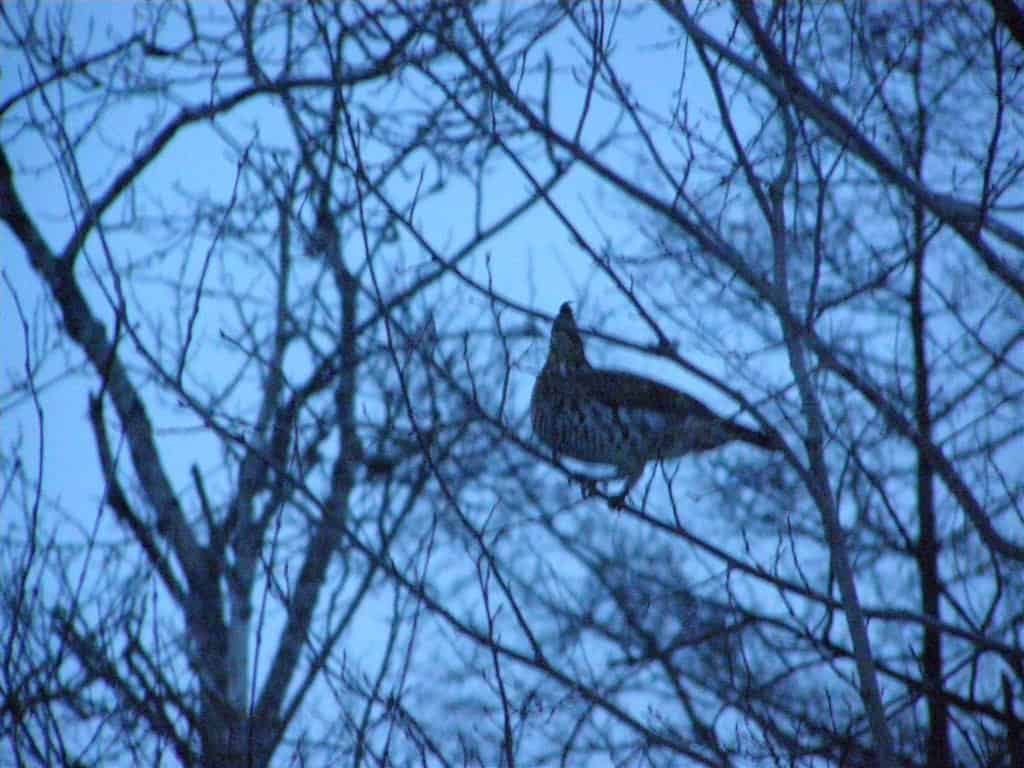
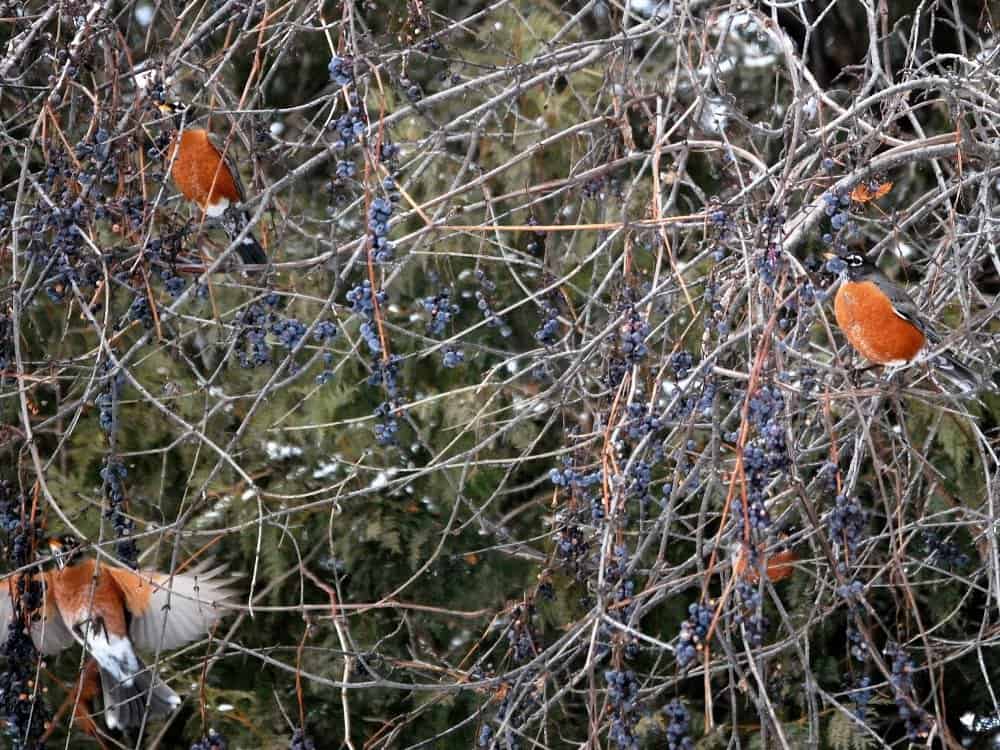
__8 — Small flocks of American robins overwinter in Peterborough every year. They love to gorge themselves on wild grapes as well as the fruit of crab-apple trees and European buckthorn.
__9 — If you’re driving through open farm country, keep an eye open for huge, swirling flocks of snow buntings. It is not uncommon to see hundreds of these white birds in a single flock.
__10 – Beavers are mating this month and next. To tell whether a lodge is active, look for a dark hole at the top where the snow has been melted away by the body warmth of the occupants inside.
__11 — White-tailed deer shed their antlers sometime between late-December and early March. Antlers are temporary projections of bone which are grown and therefore discarded each year. Although a buck’s antlers are used primarily for sparring with opponents during the fall rut, they also serve to dig in early snows in search of food.
__12 — As snow deepens, white-tailed deer move into “deer yards.” These are often cedar swamps which offer easily-accessible food as well as shelter from storms and deep snow. The largest deer yard in our area is the Peterborough Crown Game Reserve, located just north of Stoney Lake.
__13 — Coyotes are quite vocal during their January to March mating season. The young are born 60-63 days later, usually in a ground den. Unlike the wolf or domestic dog, coyotes run with their tail pointing down.
__14 — Mice, shrews, voles and moles remain active all winter long, as they make a living in the sub-nivean space between the earth and snow. A couple of feet of snow can make a remarkable temperature difference: -20 C above the snow and 0 C beneath!
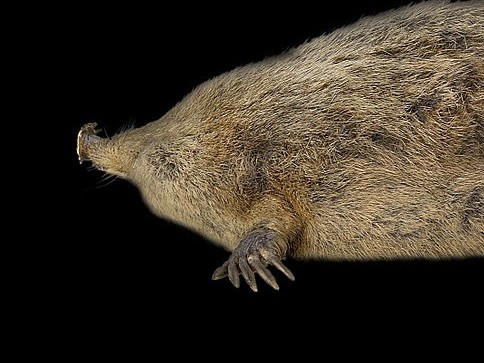
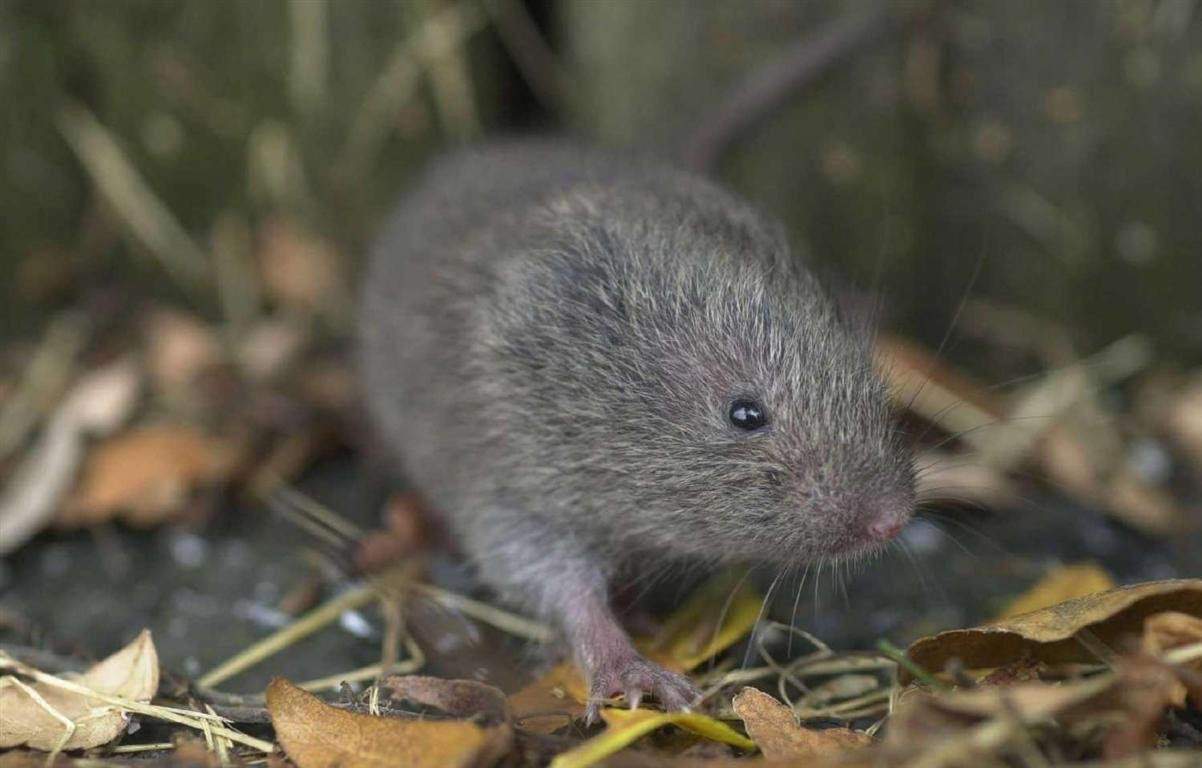
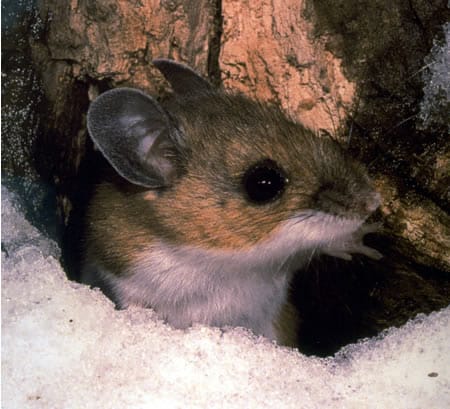
__15 — Watch for over-wintering raptors such as red-tailed hawks and American kestrels.
__16 — Bass lie dormant under logs, weeds or rocks until the light and warmth of spring restore their energy and appetite. Small-mouth bass virtually starve themselves over the winter. This is one reason why so few bass are ever caught by anglers at this time of year.
__17 — Porcupines often take up residence in a large eastern hemlock, tamarack or pine and will spend the winter munching away on the inner bark of the branches. Because of their short legs, porcupines must avoid expending too much energy travelling through deep snow from one tree to another.
__18 — Red squirrels use tunnels under the snow that often lead to food stashes. During very cold weather, the squirrels remain in these tunnels.
__19 — With a little searching, it is possible to find moths and butterflies overwintering in all four stages of the life cycle. The mourning cloak butterfly overwinters as an adult, the Isabella moth as a larva (the well-known woolly bear caterpillar), the tiger swallowtail butterfly as a pupa (chrysalis), and the eastern tent caterpillar moth as an egg.
__20 — Honeybees are the only insects to maintain an elevated body temperature all winter. They accomplish this by clustering together in a thick ball within the hive, vibrating their wings to provide heat and eating stored honey to provide the necessary energy.
__21 — Under the frozen surface of ponds, countless immature insects – larvae and nymphs – remain active. These include fierce, carnivorous dragonfly nymphs and the ingenious larvae of the caddisfly. The latter use bits of plants and gravel to construct cases around their bodies, seemingly for protection.
__22 — Occasionally, barred owls show up in rural and suburban backyards and prey on careless feeder birds or on mice that attracted by night to fallen seeds under the feeder. This round-headed, hornless owl often stays for days at a time and can be quite tame.
__23 — A walk through a snow-covered field or along a roadside will afford you a close look at the skeletons of asters and goldenrods. Watch for a ball-like gall growing on the goldenrod stem. It contains the tiny, white larva of the goldenrod gall fly.
__24 — The cones of red and white pine drop to the ground all winter long. The seeds, however, were already released in the fall.
__25 —Because their characteristics are different for each species, quick and accurate tree identification can be made on this basis of the twigs and buds alone. It can be fun and instructive to make yourself a winter twig collection and to note how the buds are different in size, shape, colour, and arrangement on the twig. Some species, like maple and ash, have buds that are arranged opposite each other on the twigs, but the majority of trees have buds that are staggered alternately. Oak and birch are good examples of the latter.
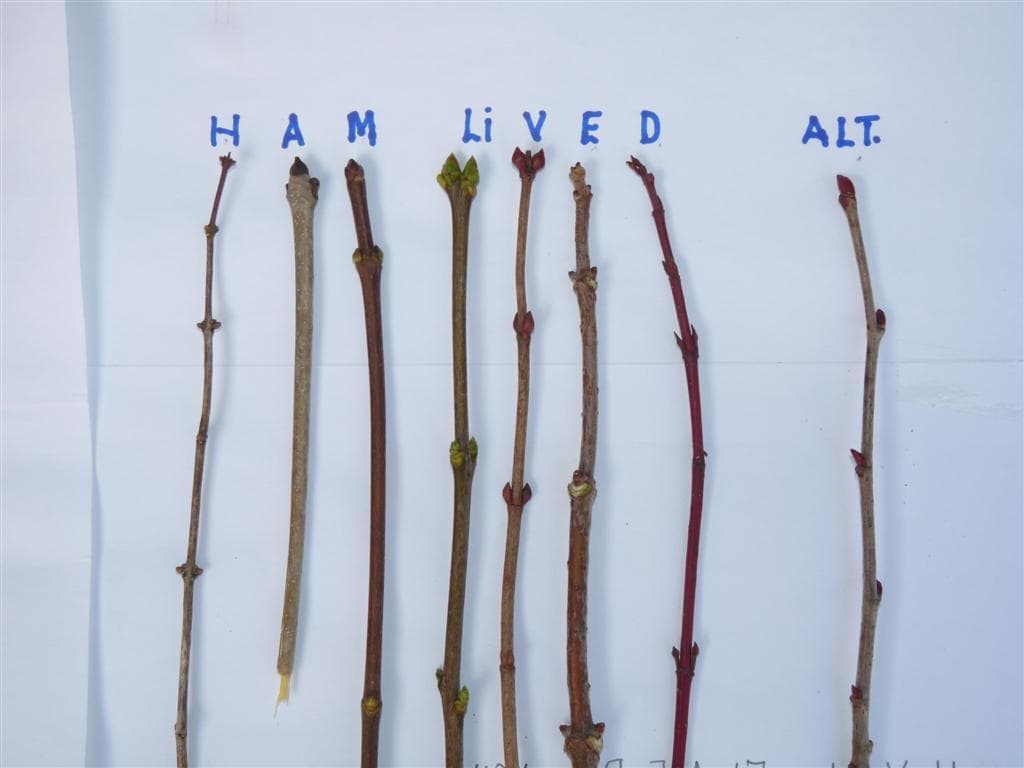
__26 — The Winter Six and their assortment of bright stars light up January evenings. Look for the constellations Orion, Taurus, Gemini, Auriga, Canis Major and Canis Minor.
__27 – With mating season starting, red foxes become more active. It’s quite common to spot their straight-lined trails, even in suburban backyards. Watch especially for foxes hunting for mice and voles at dusk or dawn.
__28 — In January, black bears give birth to cubs no larger than chipmunks. Generally, two cubs are born, although there are sometimes as many as four or five. The amount of food available in the fall is critical in determining the number of young in the litter, or even if the sow will give birth at all. The cubs will stay with their mother for 16 to 17 months.
__29 — We start to become aware of the lengthening days. Most of the daylight is gained in the afternoon, since the sun now sets more than 30 minutes later than a month ago.
__30 — If you’re up late this month, watch for the full moon. The early-winter moon rides higher in the sky than at any other season and passes nearly overhead at midnight. Coupled with the reflective quality of snow, moonlit winter nights shine with an unforgettable brilliance. The Ojibway called the moon of January the Spirit Moon.
__31 — Although it’s happening too slow for most of us to notice, winter’s forces are gradually reshaping the landscape as water freezes in narrow seams of rock, expands and breaks the rock into smaller fragments.
February – Gateway to the Year
“If we had no winter, the spring would not be so pleasant.” – Anne Bradstreet
With February, comes Groundhog Day and some tongue-in-cheek speculation on what the rest of the winter has in store for us. Although almost no one takes the weather-forecasting myth about groundhogs seriously, some people still believe that the behaviour or physical changes in some plants and animals can alert us weeks or even months ahead of time about the weather of the coming season. In other words, that it will be early or late, abnormally warm or cold, or wet or dry. There is absolutely no proof that this occurs, however. What we see happening with plants and animals reflects changes that are genetically-controlled (e.g., a snowshoe hare turning white in the fall) or a result of past weather conditions (e.g., a drought causing trees to shed their leaves early). Still, we should remember that, compared to humans, some animals are definitely able to make better use of their five senses to detect changes in the environment that accompany weather phenomena that are about to occur. As an example, some birds can sense a drop in barometric pressure and therefore instinctively seek cover before a rainstorm. No long-term weather prediction ability has ever been demonstrated, however, be it a woolly bear caterpillar or a groundhog!
__ 1 – We begin the month with about 9 ¾ hours of daylight and end with 11, a gain of about 75 minutes. The lengthening days are most notable in the afternoon.
__ 2 – Groundhog Day, February 2, marks the mid-point of winter. However, our groundhogs won’t see their shadow – or light of day, for that matter – until mid-March at the earliest. Groundhogs are still comfortably curled up in a ball inside their winter burrow in a state of deep hibernation. Compared to summer, their heartbeat has dropped from 100 beats per minute to only 15, and their body temperature has plummeted from 35 C to only 6 C!
__ 3 – Although rather tentative at first, bird song returns in February as pair bonds are established or renewed. Black-capped chickadees, northern cardinals, white-breasted nuthatches, and house finches are several of the birds that usually start singing this month.
__ 4 – Average February snowfall in Peterborough is about 31 cm. The average daily maximum temperature is -2.2 C and average daily minimum is -11.8.
__ 5 – If you’re looking for a mid-winter weekend get-away or just a day trip, why not consider Algonquin Park. It’s only about a two and a half hour drive from Peterborough via Bancroft, Maynooth, and Whitney. There is a good selection of finches present most winters including pine siskins, common redpolls, evening grosbeaks, pine grosbeaks, and both red and white-winged crossbills. Many of these birds can be seen right on the pavement, eating grit from sanding operations. Canada jays can easily be seen (and hand-fed!) along the Spruce Bog Trail and Opeongo Road. Remember to bring some peanuts or sunflower seeds with you. Both of these areas also have boreal chickadees. Learn its nasal call, however, since boreals are quite shy. Be sure to drop in at the visitors centre, too, to check out the birds coming to the feeders. These usually include large numbers of evening grosbeaks. Although the visitors centre is only fully open on weekends, the doors are left unlocked during the week to allow access to the washrooms and to the observation deck where the feeders are located. The nearby town of Whitney is also worth checking out for birds.
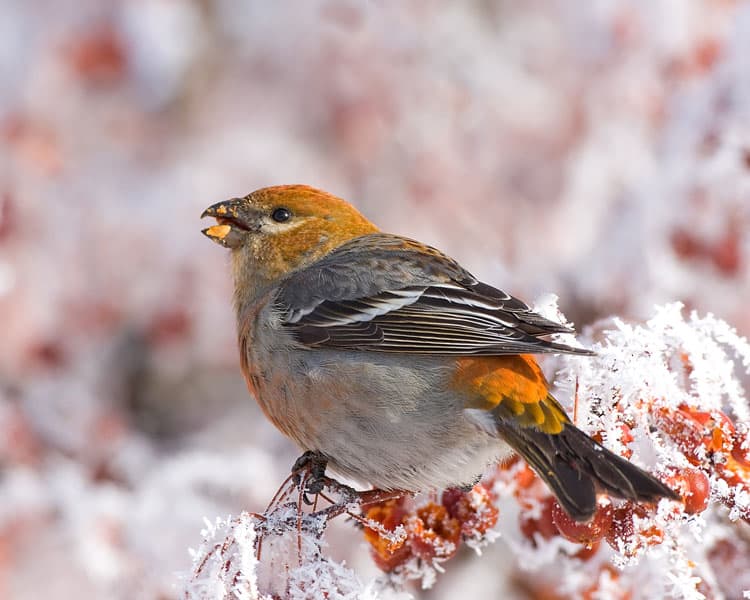
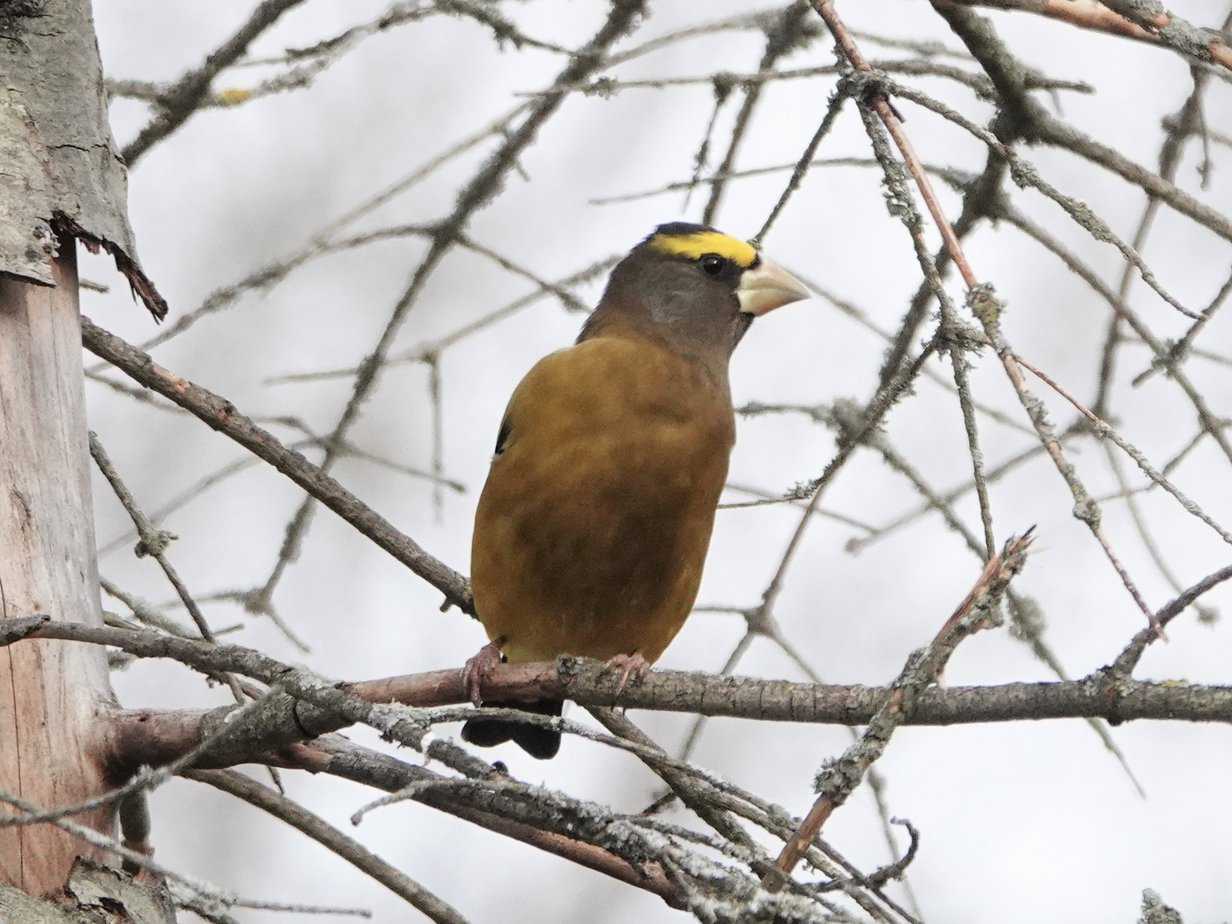
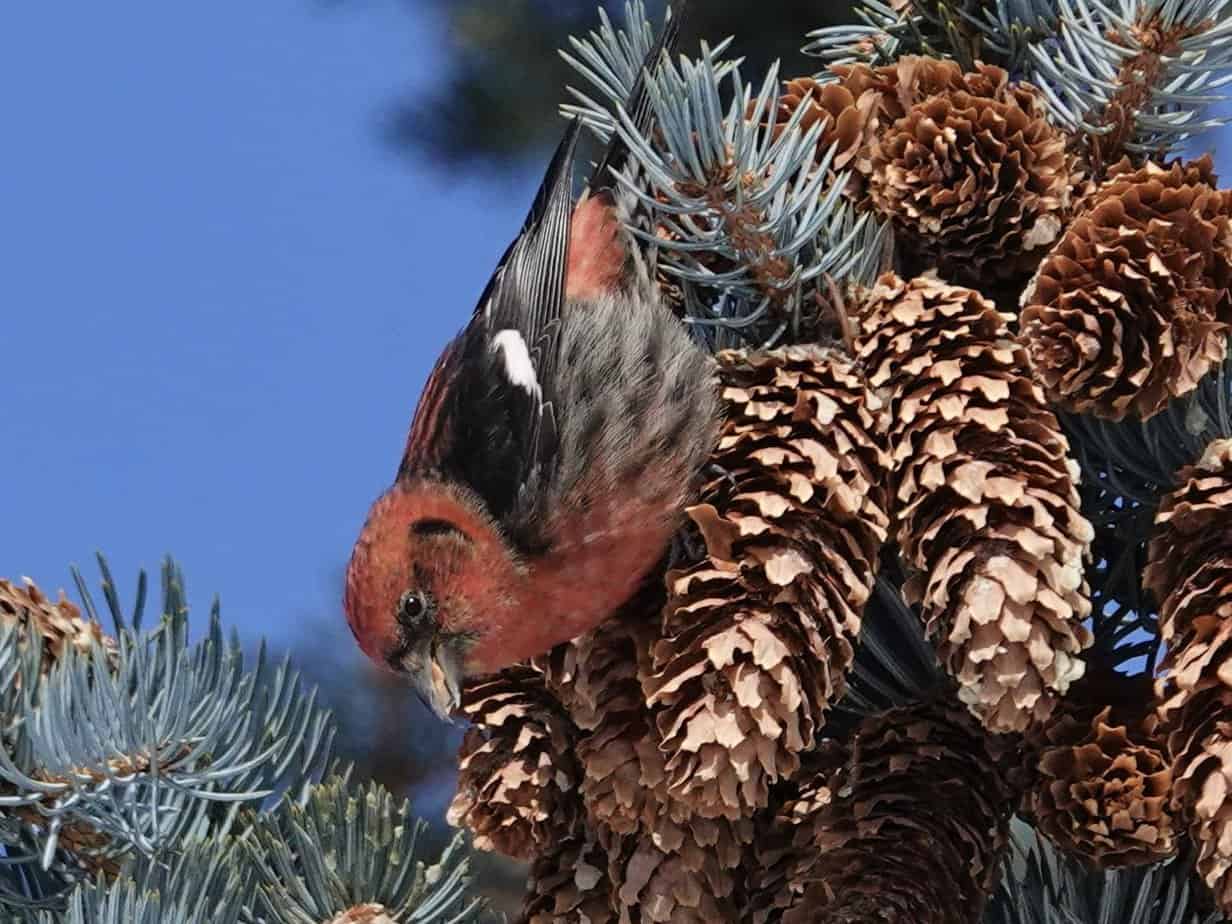
__ 6 – Gray squirrels mate in January or February and can often be seen streaming by in treetop chases as a group of males chases a half-terrorized female. Some amazing acrobatics are usually part of the show.
__ 7 – Watch for river otters in winter around areas of flowing water such as streams and rivers. Their trough-like, “snowslide” trails are sometimes seen on embankments or even flat ground.
__ 8 – Being very social animals, northern flying squirrels sometimes join up in single-sex groups for warmth during the winter. They will often choose a tree cavity.
__ 9 – Horned larks return. They are traditionally the first migrant arrivals of the year and mark the coming of “pre-spring.”
__ 10 – The grey, brittle remains of last summer’s roadside wildflowers add interest to a winter walk. Watch especially for the cup-like “bird’s nest” of Queen Anne’s lace.
__ 11 – Wolves mate between now through early April. Only the alpha male and female in the pack will reproduce, however.
__ 12 – On mild, sunny days, check the snow around the base of large trees for snow fleas. What looks like spilled pepper may begin to jump around right before your eyes!
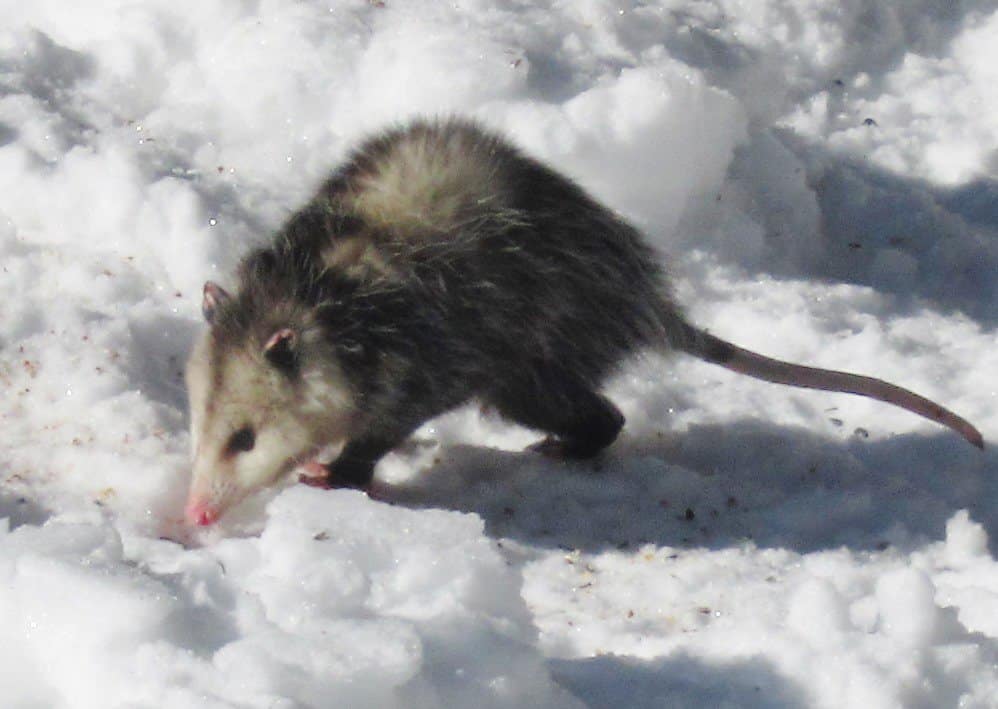
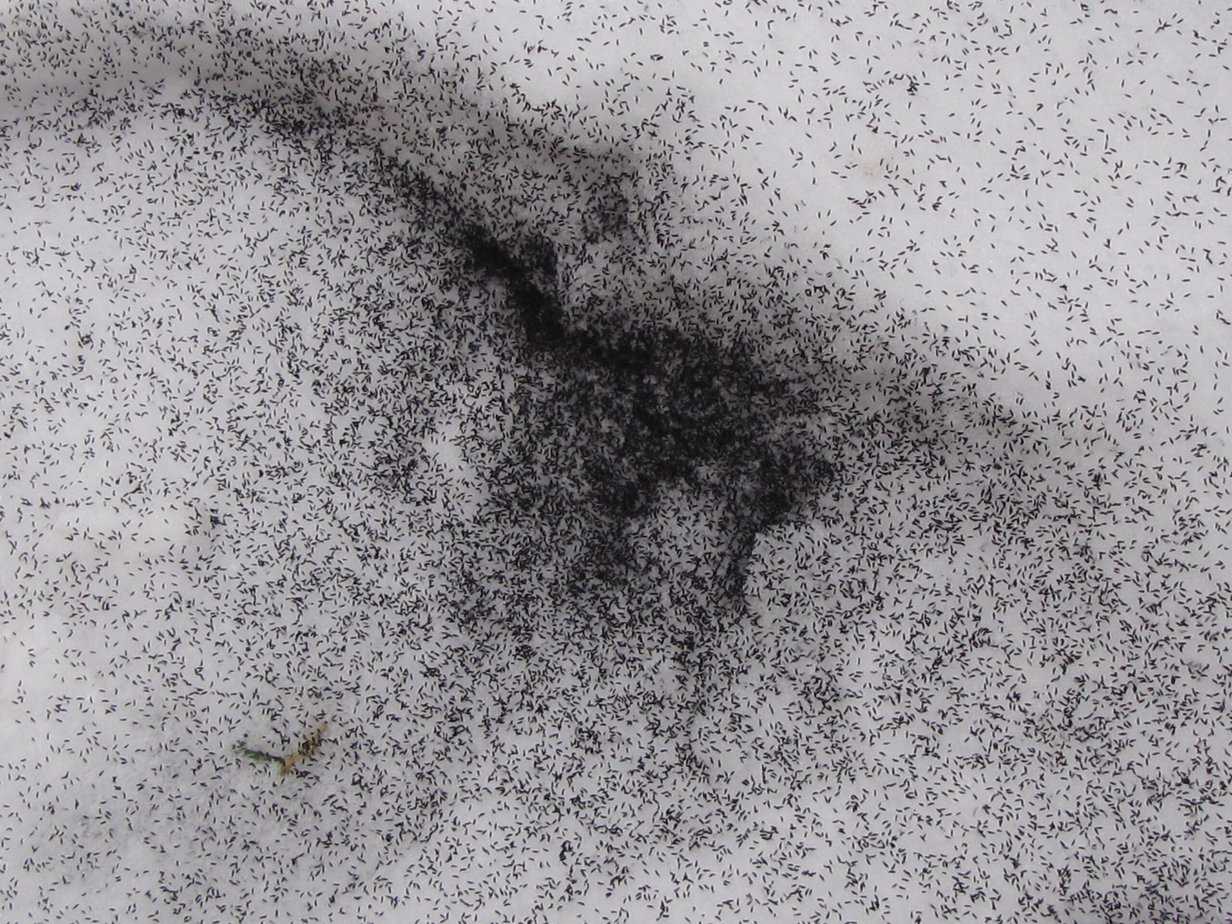
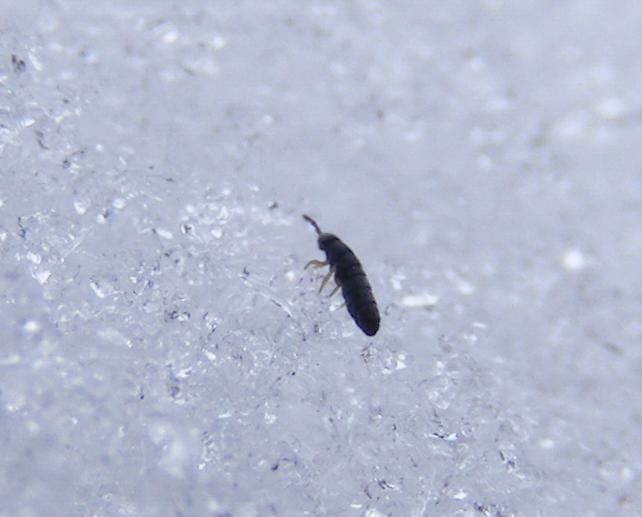
__ 13 – The Virginia opossum, a marsupial that is native to the southeastern U.S., is extending its range northward into parts of the Kawarthas, probably as a result of factors such as climate change and the resulting milder winters. These mostly nocturnal animals are sometimes attracted to bird feeders in winter where they eat spilled seed.
__ 14 – It somehow seems fitting that the period around Valentine’s Day often coincides with the return of birdsong and avian love. The chickadee’s three-note whistle is often represented as a Valentines-appropriate “Hi Sweetie.”
__ 15 – The Otonabee River sometimes floods, even in mid-winter. Cold weather conditions super-cool (reduce the temperature to below 0 C) turbulent water as it rushes downstream and over dams, thereby creating frazil ice. This type of ice is characterized by loose, needle-shaped ice crystals which resemble slush. Frazil ice has the ability to “stick” to the upstream side of objects in the water and grow in size as more ice gets deposited. This can create ice jams which impede the flow of the river and cause flooding.
__ 16 – Lake trout eggs hatch in February but the fry remain in the substrate for about six weeks and survive on energy stored in their yolk sac. They swim up from the shoal where they hatched in late March and early April and must actively feed or starve to death. Food is usually abundant at that time. However, climate change may cause an increase in water temperature which would result in the eggs hatching earlier. The fry may then become active in mid-winter when there is no food available and consequently starve to death.
__ 17 – The Great Backyard Bird Count (GBBC) takes place in mid-February over four days (Friday through Monday). The GBBC engages bird watchers of all levels of expertise to create a real-time snapshot of the whereabouts and relative abundance of North American birds in mid-winter. Anyone can participate. Go to https://www.birdcount.org/ for details.
__ 18 – True spiders may also emerge from the leaf litter and head out onto the snow pack on mild winter days. These are spider species that overwinter as adults and do not build webs to catch prey.
__ 19 – Our sense of smell can be useful in winter tree identification. Break a twig or crush a bud of yellow birch and a wintergreen or peppermint smell is released. An equally pleasant but much stronger smell comes from the large, terminal buds of the balsam poplar. They give off a familiar spicy fragrance that immediately evokes the smell of a damp, late May morning.
__ 20 – Winter is on the ebb. The sun is rising and setting further and further north with each passing day. This makes for longer days.
__ 21 – Crow numbers increase as returning migrants bolster the ranks of those birds that never left. Watch for long, scattered flocks often flying at high altitudes.
__ 22 – This is courtship time for ravens. Males begin their aerial nuptial displays, diving and twisting like corkscrews over Canadian Shield country. Pairs of ravens will also soar together. There has been a dramatic expansion of the raven’s range south of the Canadian Shield in recent years. They are often seen right over Peterborough.
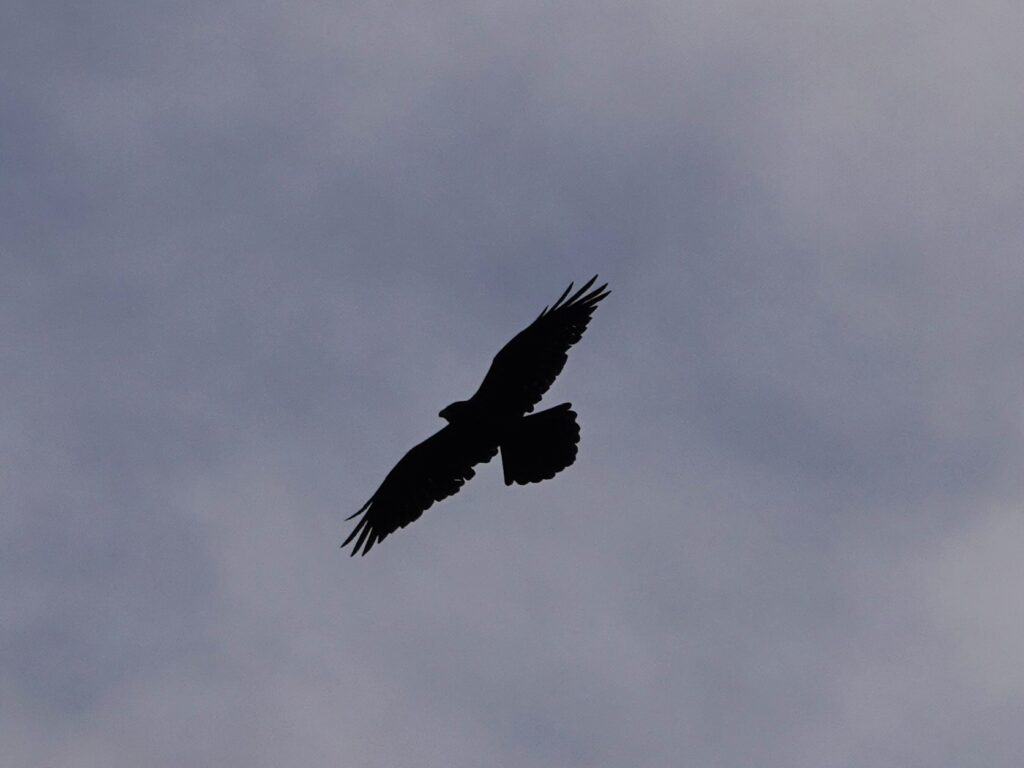
__ 23 – “Giant” Canada geese that have wintered along the Great Lakes and southwards into the northern and mid-United States begin arriving back in the Kawarthas. Other species such as the cackling goose (formerly thought to be a sub-species of the Canada goose) sometimes mix in with these flocks, too.
__ 24 – Abnormally warm weather conditions in the last week of February will bring in robins as well as blackbirds and waterfowl.
__ 25 – The male common goldeneye puts on quite a show of courtship behaviour in late winter. He thrusts his head forward and then moves it back towards his rump with his bill pointing straight up in the air, at which time he utters a squeaky call.
__ 26 – February is often a particularly good time to see “sun dogs.” They consist of two short rainbow arcs forming on either side of the sun and creating a halo of light.
__ 27 – Leo, the constellation of spring, holds sway over the early northwestern morning sky as we head for work.
__ 28 – Sunset does not occur until 6:00 p.m., and evening twilight will carry on until 6:30. The day is already about an hour longer than at the beginning of the month!
__ 29 – Spring has sprung for overwintering monarch butterflies in the mountains of Mexico. Now that the lengthening days have triggered the final development of their reproductive systems, male monarchs are zealously courting the females.
March – Waiting for Spring-to-Be
March comes, a kind of interregnum, winter’s sovereignty relaxing, spring not yet in control. – Hal Borland
Like many of our months, March derived its name from a Roman god. In this case it was Mars, the god of war. For the Romans, however, it was not the third, but rather the first month of the year. This made sense because March is a time of warm spring weather in the Mediterranean and therefore a logical point to begin the year . This was also the start of the military campaign season, hence the name’s connection with war.
In the natural world, March is a time when winter’s grip finally begins to loosen. Large numbers of migrants return, bird song greets us as we step outside in the morning, the buds of several tree species begin to open, and the longer days and warmer sun rekindle our spirits.
__ 1‑ Open sections of local lakes and rivers will be host to thousands of northward-bound ducks later this month. Little Lake, Lake Katchewanooka, Gannon Narrows, Herkimer Point on Rice Lake, and the Otonabee River offer good viewing opportunities.
__ 2‑ Red squirrels become aggressive towards their own kind as the mating season begins. Listen for the squirrels’ scolding “cherr” call as feuding over territory becomes common. Several males at a time can sometimes be seen chasing a half-terrorized female through the forest canopy.
__ 3‑ With earlier sunrises, later sunsets, and the sun’s higher path through the sky, we enjoy longer and usually warmer days. A good measure of winter’s waning can also be seen in the circles of bare ground around tree trunks. Although sunlight reflects off snow, it is absorbed by dark tree bark and gently radiated back to the surrounding snow. Snow melt then occurs around the base of the tree.
__ 4‑ House sparrows are already laying claim to nest boxes. The male house sparrow will often perch on the box and call repeatedly in order to show ownership and to attract a female.
__ 5‑ This is mating season for the barred owl. Famous for their wide range of vocalizations, these highly vocal birds scream, hiss, hoot, and cackle the March and April nights away. Listen especially for a resounding “hoo, hoo, too‑HOO; hoo, hoo, too‑HOO, ooo. ” The easy to remember mnemonic is “Who, cooks, for‑you? Who, cooks, for‑you, all?”
__ 6‑ After several months of respite from house flies, these pesky critters often reappear on windows in March. They are adults that have “slept” through the winter in a type of hibernation called diapause. Fly eggs that were laid in the fall may also be present, but they won’t hatch until later in the spring.
__ 7‑ Male raccoons lose interest in sleeping as breeding seasons begins. Watch for the meandering tracks of males in the snow and mud as they search out receptive females. They may also visit your yard in search of food. They are known to enjoy bird seed!
__ 8‑ Consider a trip to Presqu’ile Provincial Park to see migrating waterfowl. The park is located near Brighton, about an hour’s drive south of Peterborough. Up to 10,000 birds of as many as 25 different species are usually present in the waters off the park. You can expect to see large numbers of canvasbacks, long-tailed ducks, redheads, ring‑necked ducks and, especially, greater scaups.
__ 9 – Bird song is now very noticeable. Listen especially for the cardinal and house finch. The latter sings a high-pitched, disjointed, warbled song, often from the top of a tall conifer.
__ 10‑ The furry catkins of pussy willows are a time‑honoured sign of spring. Catkins are actually clusters of tiny flowers densely covered with silky white hairs when immature. Catkin is a Dutch word meaning “little kitten.”
__ 11‑ Red-tailed hawks are making their way back from wintering grounds in the United States. Watch for pairs of these birds soaring together over their woodlot territories.
__ 12‑ This is an excellent time of the year to listen for owls. In the southern Kawarthas, great horned and screech owls can be heard, while the northern Kawarthas is home to the barred owl. Northern saw-whet owls are also a possibility.
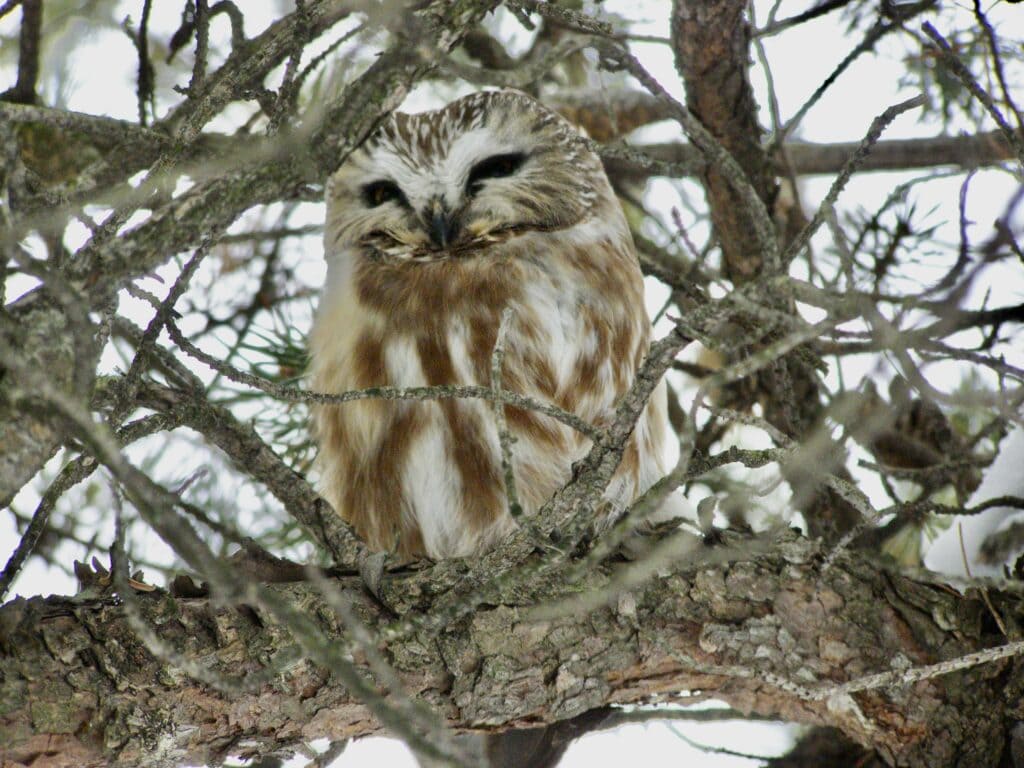
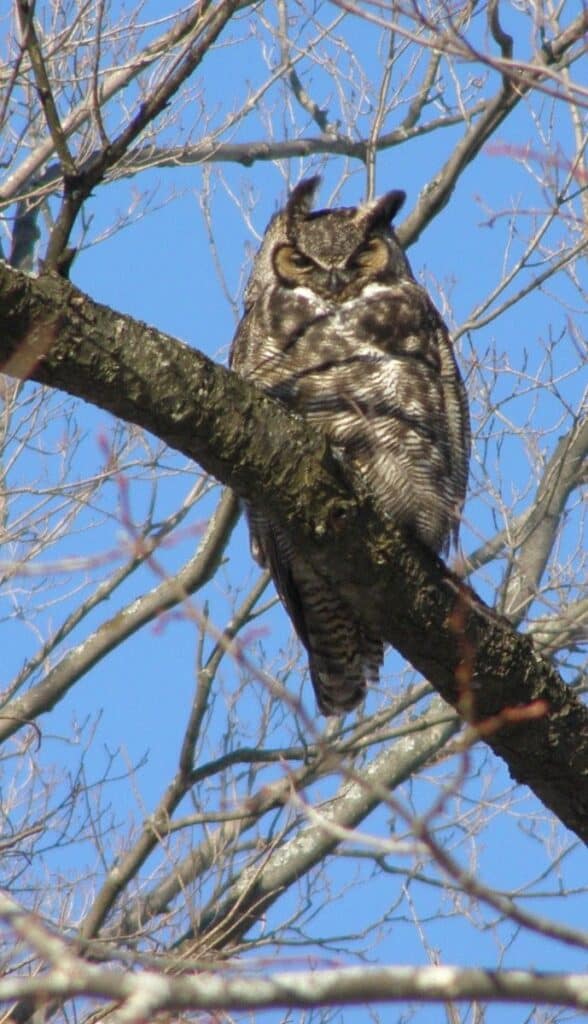
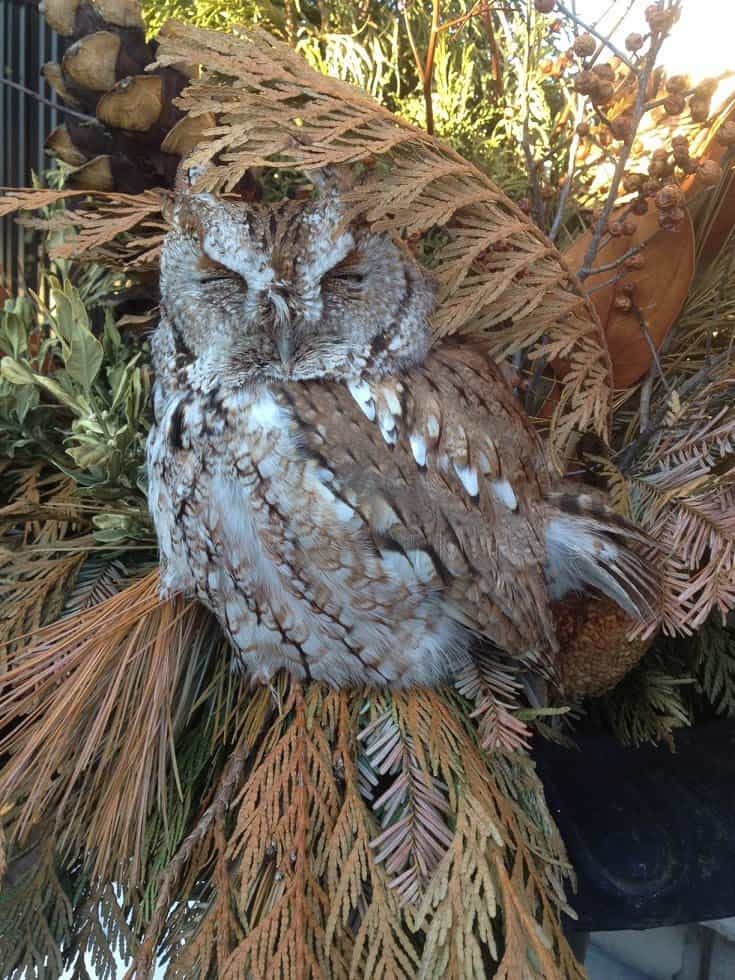
__ 13‑ Chipmunks reappear in our yards. Although we haven’t seen them since last November, they were not sleeping all the time. Because chipmunks don’t have enough body fat to keep themselves alive for many months, they need to arise occasionally during winter to snack from underground food caches and to go to the bathroom.
__ 14‑ This is one time of year when dandelions are actually a welcome sight. Even though there may still be lots of snow on the lawn, snow-melt usually occurs along the bottom of southward facing walls. Here, the first green grass appears and, often, the first dandelions bloom as well. Even though we battle this alien species later in the season, right now it’s a much-appreciated sign of spring.
__ 15‑ The buds of a number of trees look different this month as they swell and stand out clearly against the blue spring sky. The buds of red maple, silver maple, and trembling aspen ( a cousin of the pussy willow) are among the most noticeable.
__ 16 ‑ Sugar maple trees are tapped around the middle of March. Daytime temperatures above 5C combined with nights below freezing create the best conditions for a good sap run.
__ 17‑ Today is St. Patrick’s Day. This Irish saint is said to have ridden Ireland of snakes. It’s unfortunate that Western tradition see these reptiles as creatures of ill-repute. Many Ontario species are extremely rare or even threatened with extinction. On St. Patrick’s Day, Ontario’s snakes are still down below the frost line in hibernaculae such as crevices, wells, and rodent burrows.
__ 18 ‑ The first songbirds have usually returned by mid‑month. In the city, the most commonly seen species are robins and grackles. Grackles are those foot-long, glossy-purple blackbirds that make a loud “chack” call as they fly around your neighbourhood in small groups. They can be easily separated from starlings by their long, wedge-shaped tail.
__ 19‑ Flocks of red-winged blackbirds are now returning to the still-frozen wetlands of the Kawarthas. These early arrivals typically perch in the highest branches of trees and are easy to see. Some flocks venture into the city and may even turn up at feeders.
__ 20‑ Depending on the year, the vernal equinox (first day of spring) takes place March 19, 20, or 21. For the next six months, we enjoy days that are longer than nights. Both the moon and sun rise due east and set due west today.
__ 21‑ Starting at about 7:30 p.m., watch the eastern horizon for Arcturus, the brightest star of summer, and the harbinger of spring. To find this beautiful star, follow the arc of the Big Dipper’s handle to the next brightest star. Mariners used to say: “Arc to Arcturus.”
__ 22 – On a warm day in late March, you may get a glimpse of a mourning cloak butterfly taking its first flight since last fall. These purple-black and yellow butterflies will often feed on sap dripping from maple trees in spring. The mourning cloak overwinters in the adult stage of the life cycle.
__ 23‑ A meltwater pond often forms in the corn field just south of Mather’s Corners and east of Hiawatha Line on County Road 2 near Rice Lake. The pond welcomes a variety of ducks such as mallards, northern pintails, American wigeon, blue‑winged teal, black ducks and wood ducks. Tundra swans turn up on occasion as well. A spotting scope is necessary to see the birds well.
__ 24‑ If the weather becomes particularly warm, you may see the odd honey bee on a crocus or snowdrop in your garden. Honeybees are one of the few insects that remain active all winter.
__ 25‑ The signature constellation of spring is Leo. Ruling over the southeastern sky in the evening, it is one of the few constellations that actually looks like its namesake.
__ 26 – By late March, killdeers appear on pastures and other open areas with short grass. They get their name from their “kill-dee” call.
__ 27 ‑ Sandhill cranes return to the Kawarthas and can sometimes be heard calling at dawn and dusk. This species has seen a steady increase in numbers in recent years.
__ 28 ‑ Wild leek leaves poking through patches of late‑March snow are often the first sign of new herbaceous plant growth. Leeks do not flower, however, until early summer.
__ 29 ‑ Coyotes give birth to three to seven pups in late March or April.
__ 30 ‑ The weasel’s coat may be already turning from white back to brown. The change is caused by hormones that are released as a result of the lengthening hours of daylight.
__ 31‑ Small flocks of tree swallows, the first true insect eaters to return to the Kawarthas, can sometimes be seen flying low over the Otonabee River and Little Lake in the last few days of March.
April – Frog Song and Sky Dancers
Every spring is the only spring – a perpetual astonishment. – Ellis Peters
April’s identity comes down to one thing – SONG. Be it the courtship hammering of yellow-bellied sapsuckers or the chorus of robins, cardinals, and mourning doves that awaken you at 6 am, April is very much a month of the sounds of birds advertising their presence to potential mates. Ruffed grouse drum intermittently all day long as northward-bound geese call like barking dogs from high overhead. When evening comes, the nasal “beent” of the woodcock is joined by the incessant calling of spring peepers, wood frogs, and leopard frogs. Learning nature’s myriad sounds greatly enhances one’s enjoyment of the changing seasons.
__ 1 ‑ Local wetlands will soon awaken to the calls of chorus frogs and spring peepers. The former sounds like someone running a thumb over the teeth of a comb, while the latter sings a short, loud “peep” which is repeated once a second.
__ 2 ‑ Migrating waterfowl continue to migrate through the Kawarthas. Check out Little Lake, the Otonabee River, Lake Katchewanooka, Rice Lake and Buckhorn Lake for species such as ring-necked ducks, buffleheads, mergansers, scaup, and goldeneye.
__ 3 – Silver maples, a common city tree, will be putting on quite a show. Dense clusters of flowers in tinges of red, yellow and green festoon the twigs. The winged samaras (keys) will appear in June.
__ 4 ‑ If you want to see salamanders, wait for a mild, rainy night in early to mid-April when the first frogs are calling. Drive slowly along back roads that pass through low woodlands with nearby swampy areas or flooded ditches. Be careful, however, so as not to run over any of these beautiful amphibians crossing the road. You should be able to see both the spotted and blue‑spotted salamanders making their way to breeding ponds.
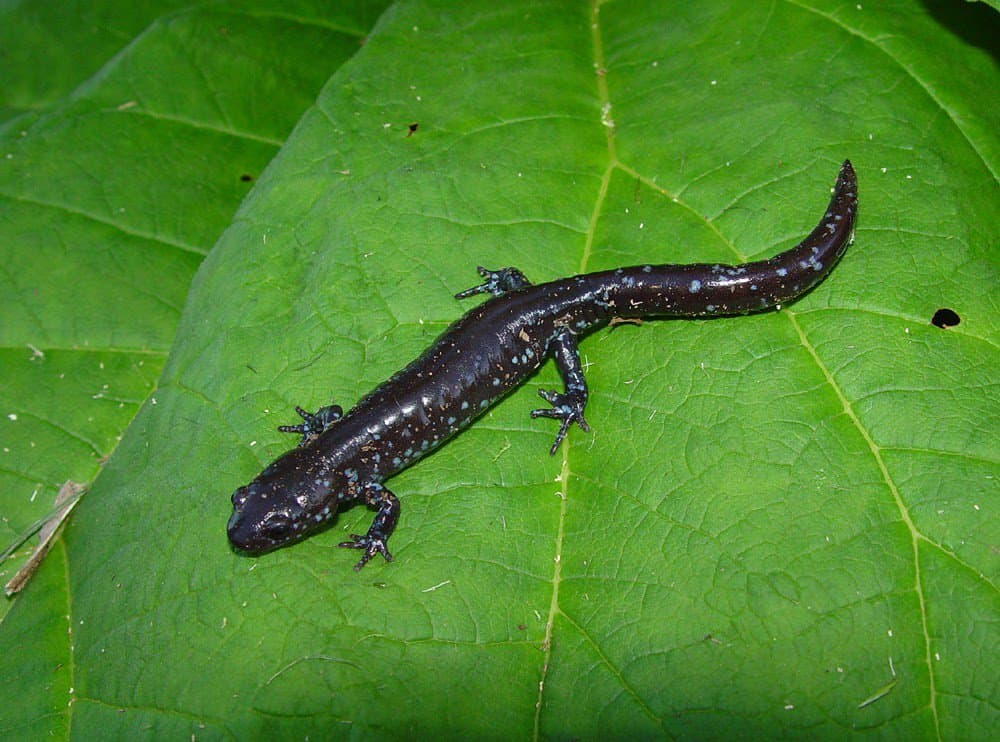
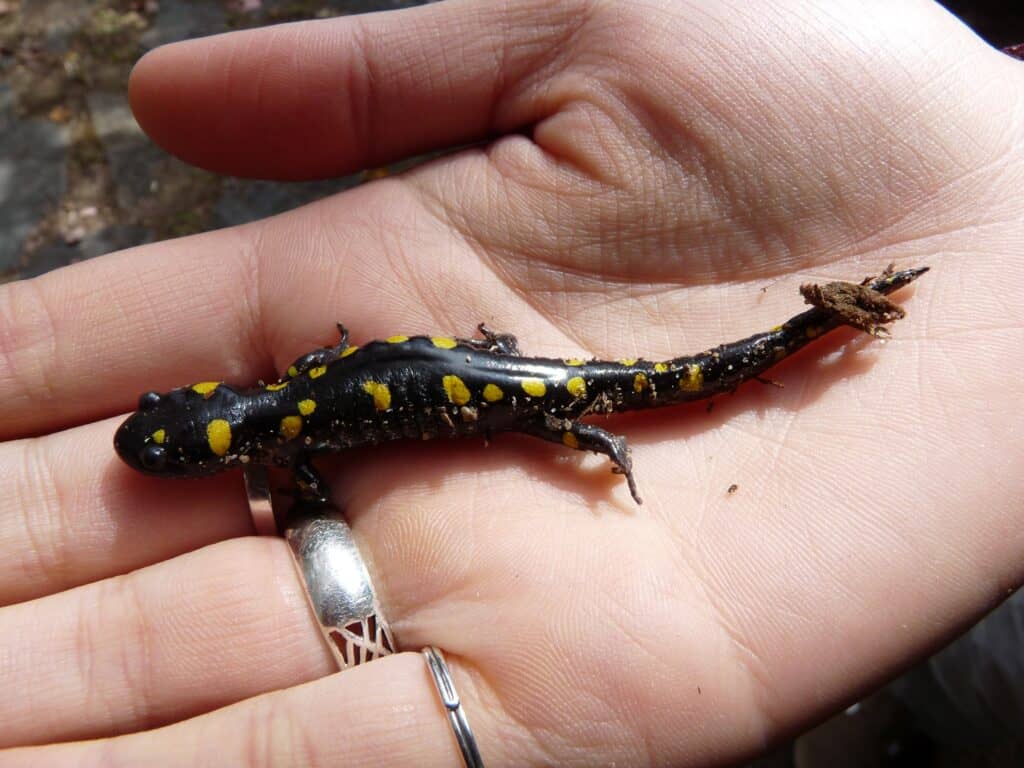
__ 5 ‑ Watch for the yellow, dandelion-like flowers of coltsfoot growing along roadsides. Later in the month, the white, fluffy seed heads also resemble those of dandelions. Coltsfoot initially produce only flowers; the leaves won’t appear until later in the spring.
__ 6 ‑ Don’t be too surprised if a half‑crazed robin or cardinal starts pecking at or flying up against one of your windows at this time of year. Being very territorial birds, they instinctively attack other individuals of the same species – in this case, their reflection! Both male and females are known to do this. The banging can start at dawn and last until dusk – for weeks on end! The simplest solution to this problem is to tape a piece of cardboard over the section of the outside of the window where the bird is pecking.
__ 7 ‑ In the evening, look for the beautiful yellow-orange star, Arcturus, in the eastern sky. This time-honoured harbinger of spring is the second brightest star visible from northern latitudes. Arcturus is believed to be one of the first stars named by ancient observers. Its name is translated as “Guardian of the Bear”, a reference to nearby Ursa Major.
__ 8 ‑ After their late-winter mating season, cottontail rabbits are giving birth. The young, naked and blind, are usually found in a fur-lined depression under a shrub. They grow so fast that they are ready to live on their own after only a month.
__ 9 ‑ Now is a good time to learn the songs of early spring birds like the chickadee, robin, cardinal, mourning dove, grackle, starling, house finch, and song sparrow. I find the best way to remember each song is to use a mnemonic or memory aid. For example, the American robin seems to say: “cheer‑up, cheer‑a‑lee, cheer‑ee‑o”.
__ 10 ‑ Close to 30 species of local birds are already nesting this month. Among these is the American robin. The female (the one with the dull orange breast) selects the nest site and does most of the nest building. Robins have two and even three clutches of eggs each year. The same nest is sometimes used for multiple clutches. The male actively defends the territory around the nest through all clutches. You can often see him aggressively pursuing another male that has intruded onto the territory.
__ 11‑ Up until the early 2000s, there were usually several days in mid-April when tens of thousands of migrating tree swallows could be seen flying over the Otonabee River and adjacent roads and fields. Now we’re lucky to see more than several hundred. Some biologists believe that the decline in swallows is related to a decline in the number of flying insects as a result of pesticide use.
__ 12 ‑ April sees the return of our only migratory woodpecker – the yellow-bellied sapsucker. It loves to hammer on resonant surfaces such as street signs to advertise ownership of territory. Butterflies, as well as other bird species, feed at the shallow holes the sapsucker makes in trees in order to get sap. For this reason, it is considered a “keystone” species, namely a species that has a larger impact on its community or ecosystem than would be expected from its relatively small numbers.
__ 13 ‑ Along shorelines and the edges of wetlands, alder trees are now producing male catkins that grow into long, hanging, caterpillar-like structures that shed puffs of bright yellow pollen when touched.
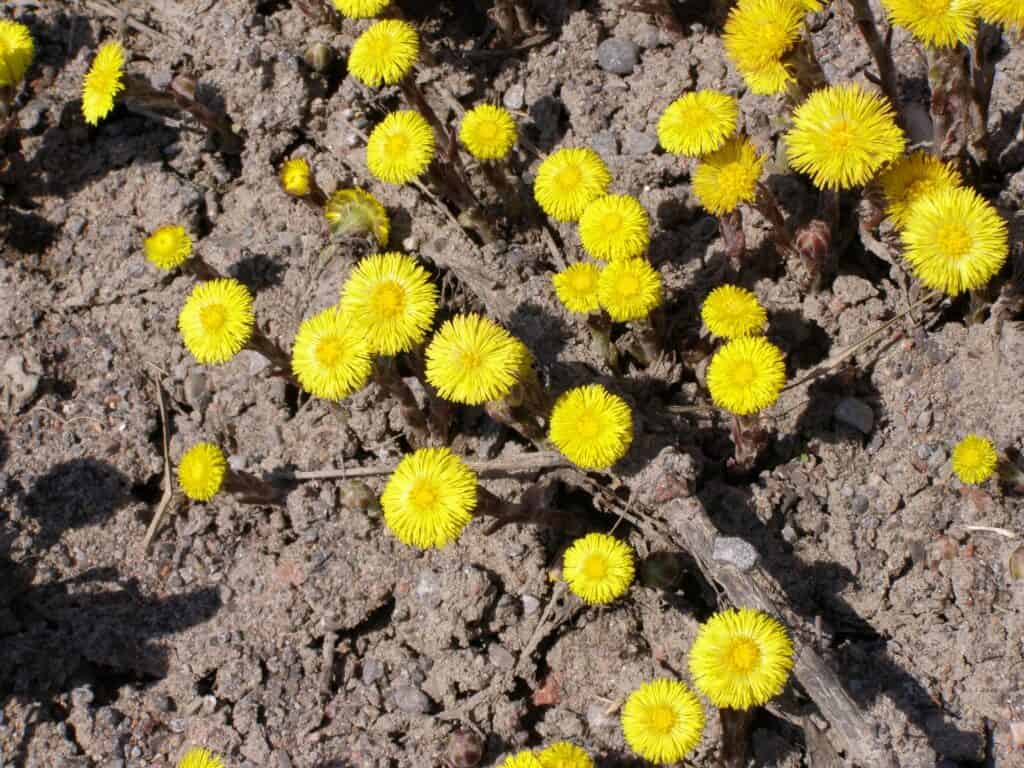
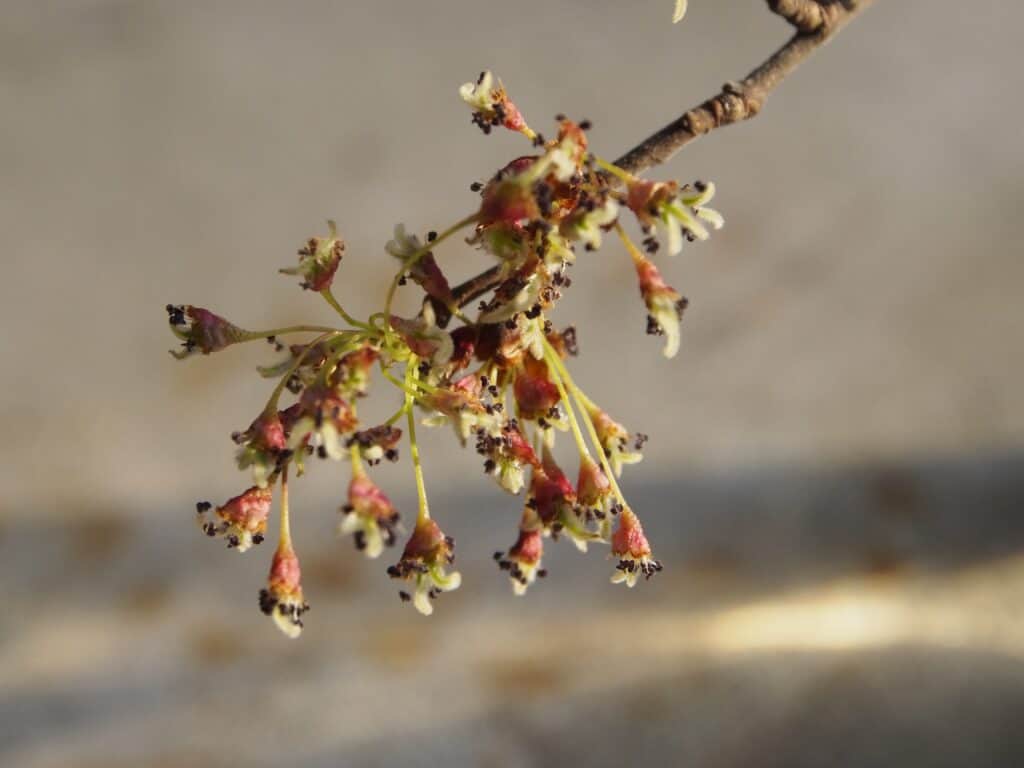
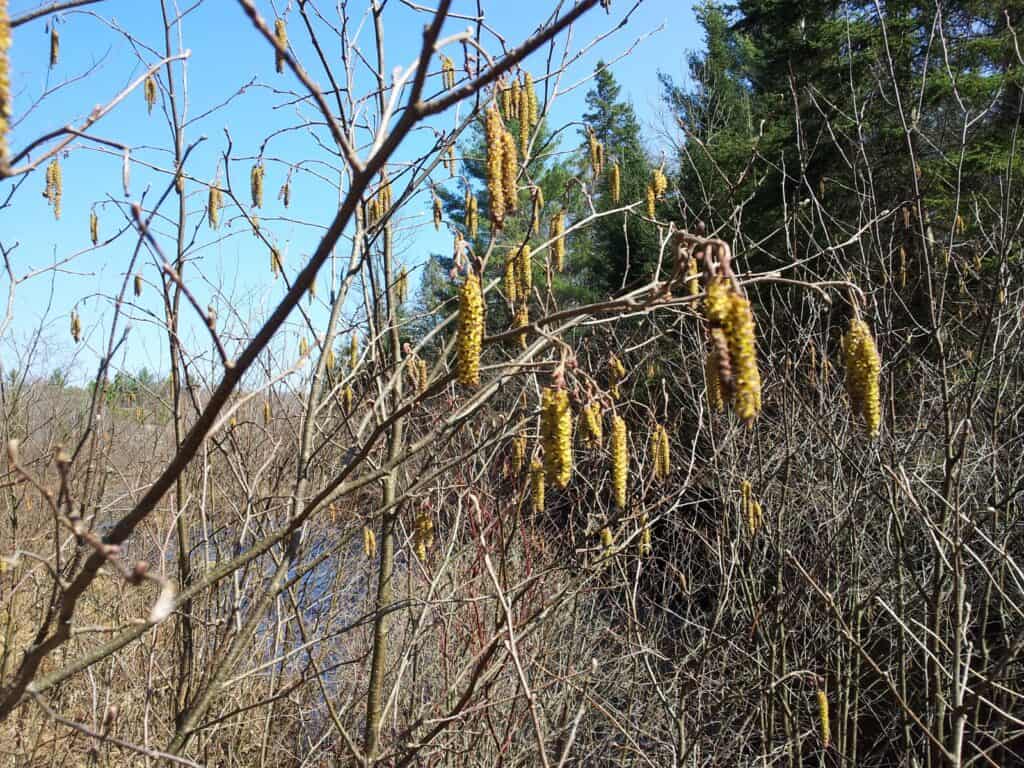
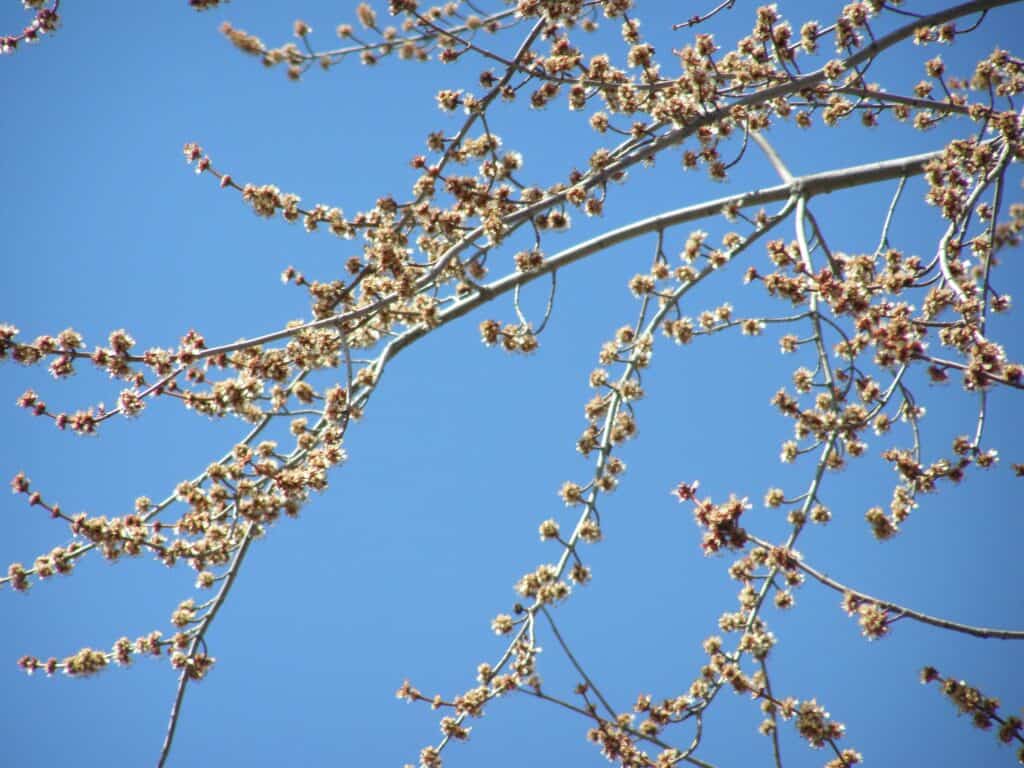
__ 14 ‑ Eastern bluebirds are nesting now. Thanks to the success of well-designed bluebird boxes, this species is once again relatively common. Weather is now the biggest factor influencing bluebird population fluctuations, especially cold, wet springs which cause nest failures.
__ 15 ‑ April is a very busy time for feeders. Northward‑bound tree sparrows and dark‑eyed juncos move through the Kawarthas in large numbers. Listen for male juncos singing their even, musical trill. The song is quite similar to that of the chipping sparrow.
__ 16 ‑ When water temperatures reach 7 C, walleye begin to spawn. Along with white suckers, they can sometimes be seen spawning at night at Lock 19 in Peterborough or below the pedestrian bridge in Young=s Point. Take along a strong‑beamed flashlight.
__ 17 ‑ Hepatica are usually the first woodland wildflowers to bloom in the spring. The flowers can be pink, white or bluish in colour. Look for them on south-facing forest hillsides or right at the base of a large tree. The name hepatica comes from the fact that the three-lobed leaves reminded early naturalists (who were often also physicians) of the lobes of the human liver.
__ 18 ‑ The courtship flight of the American woodcock provides nightly entertainment in damp, open field habitats such as some of the fields near the Peterborough Airport. Listen for their nasal “peent” call which begins when it’s almost dark. When the male launches itself into the air, listen for the twittering of the wings in flight.
__ 19 ‑ On average, most local lakes are ice‑free by this date. This year, however, the ice has already gone out on most lakes.
__ 20 ‑The ruby-crowned kinglet is a common but little-known April migrant. Smaller than a chickadee, this hyper-active gray bird has a distinctive white eye ring and a long, boisterous call that would seem to come from a much larger bird.
_21 ‑ White‑throated sparrows are passing through and are easily attracted to feeders if you put seed on the ground. They’re also a great entree into the world of birdsong, since the wavering whistle of their “Oh-sweet-Canada–Canada-Canada” song is one of the easiest to learn.
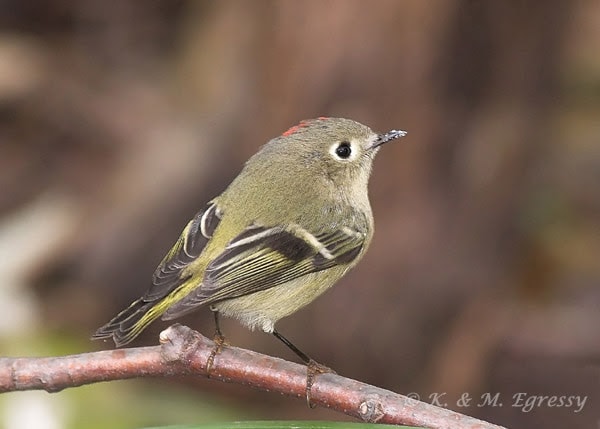
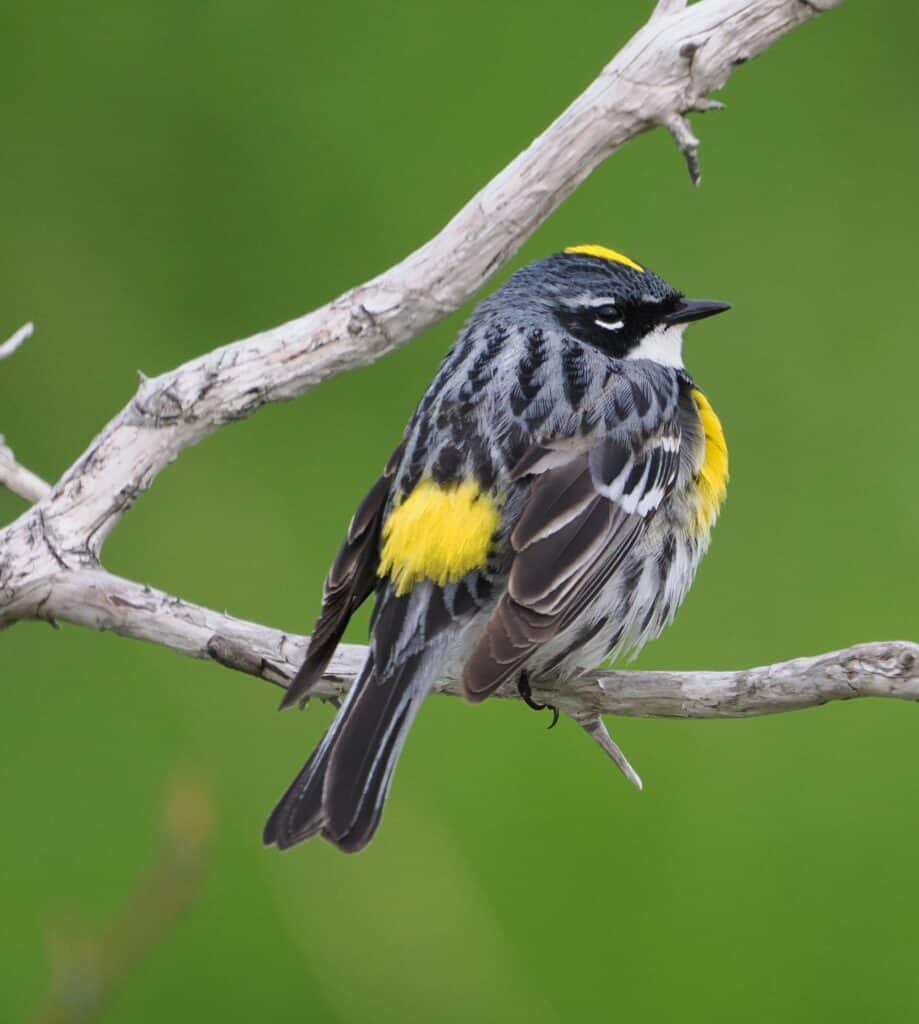
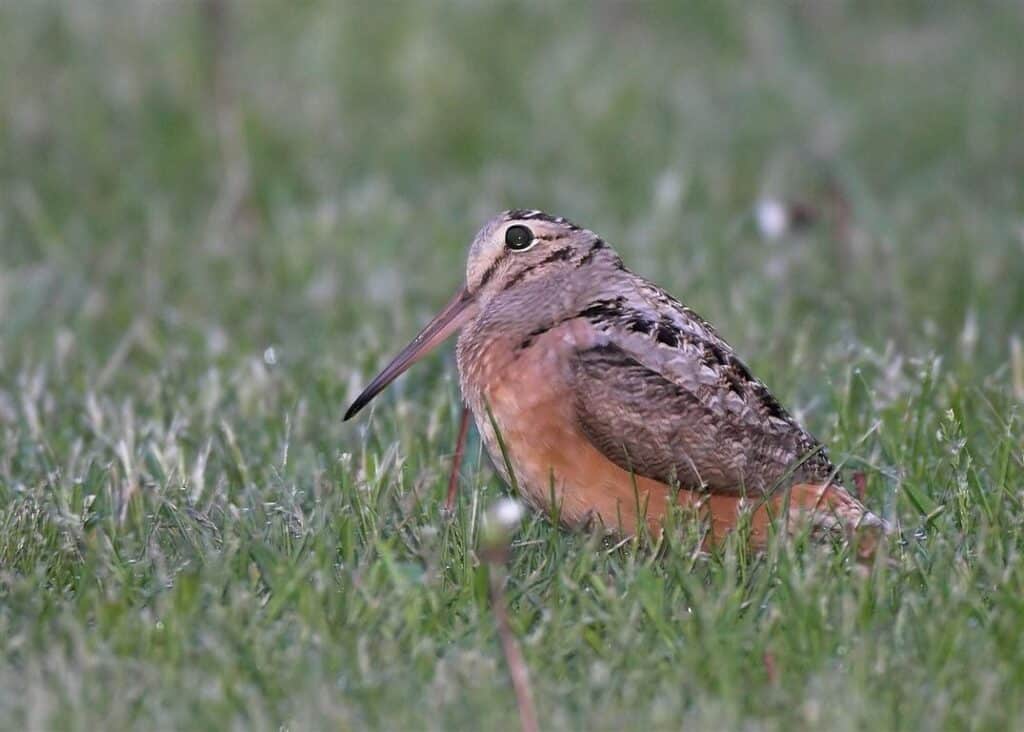
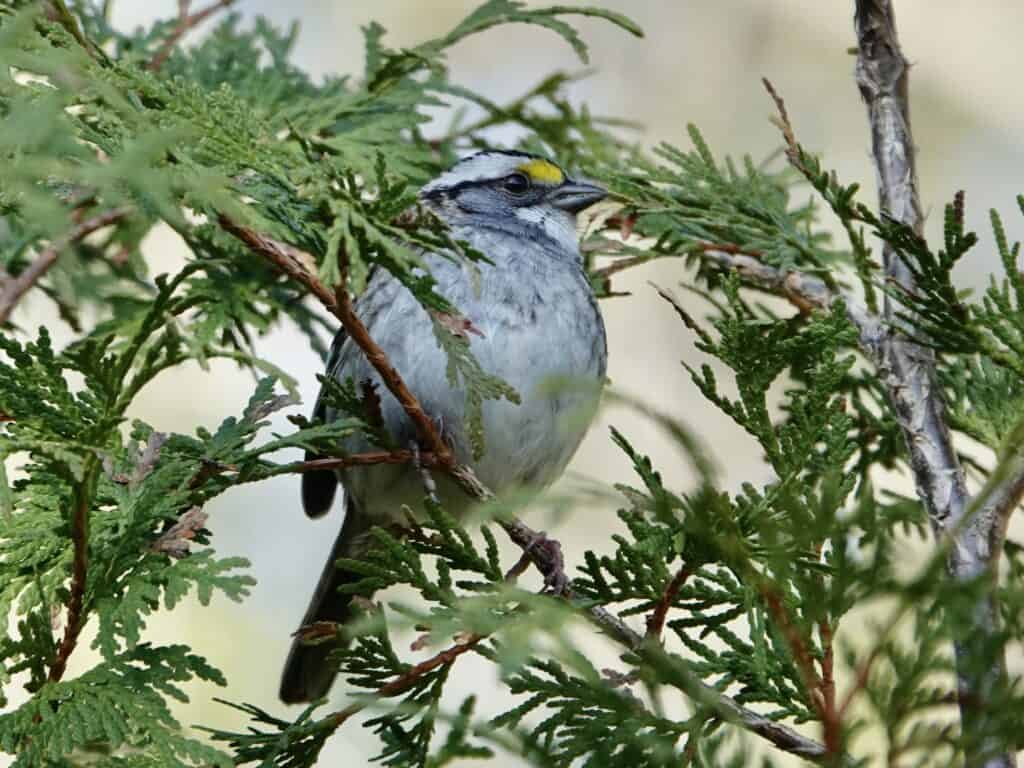
__ 22 ‑Elm trees are now in flower and look like they are covered with myriad brown raindrops. The small, wind‑pollinated flowers are clustered in tassels.
__ 23 ‑ Otonabee Conservation and the Otonabee Conservation Foundation invite community volunteers most years for their Annual Jackson Creek Clean Up. For information call 705-745-5791.
__ 24 ‑ The muffled drumming of the ruffed grouse is one of the most characteristic sounds of April. The birds drum to advertise territorial claims and to attract a female. After mating, the male has nothing more to do with reproduction; the female raises the young alone.
__ 25 ‑ Bloodroot joins the wildflower parade about now. Eight large white petals make it stand out, as do the large, deeply cut leaves. The juice from the root was used as a body paint and dye by Native Americans.
__ 26 – After a winter in the southern United States, yellow-rumped warblers return to the Kawarthas. The male is quite stunning in his blue-gray back feathers, black breast and yellow patches on the rump, sides and crown. These birds usually show up in flocks in spring. Listen for a loud “check” call note.
__ 27‑ Watch for early butterflies such as the mourning cloak, eastern comma and, by month’s end, the dainty spring azure. It is all blue.
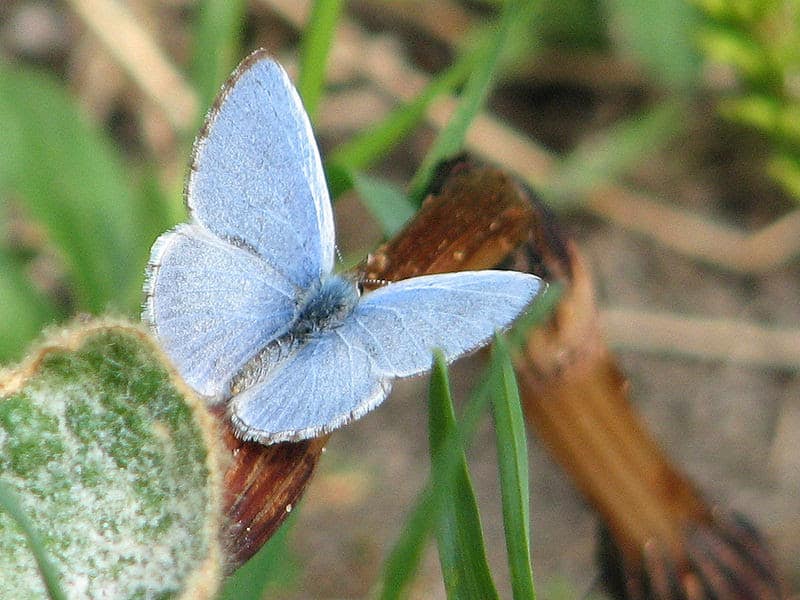
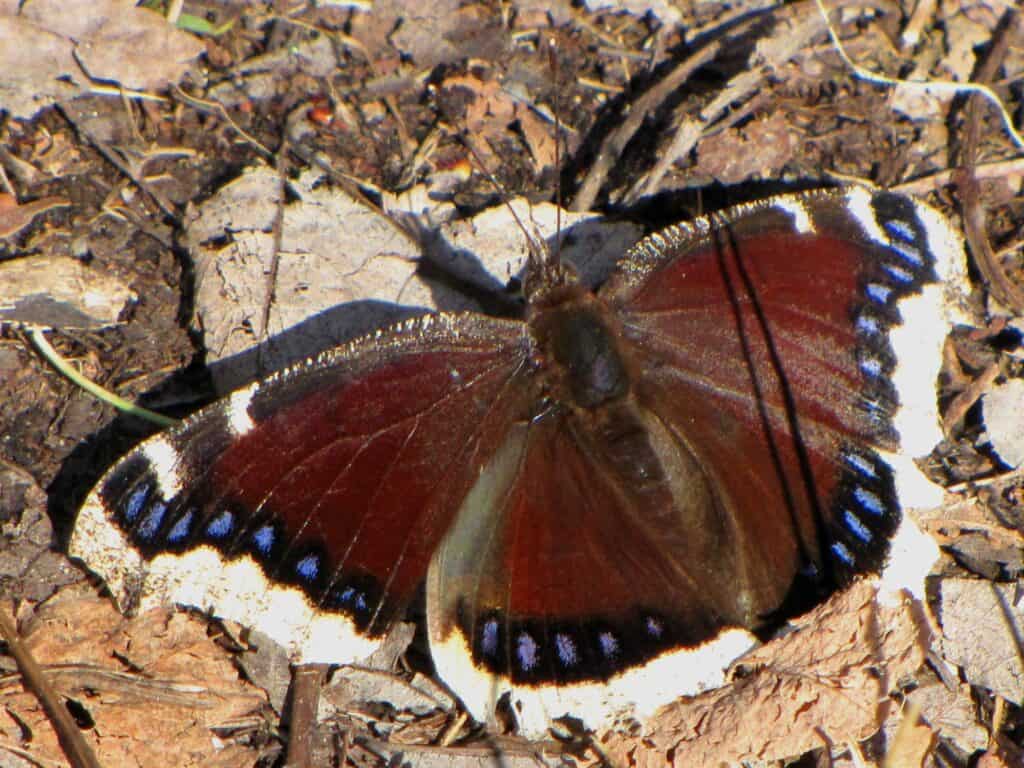
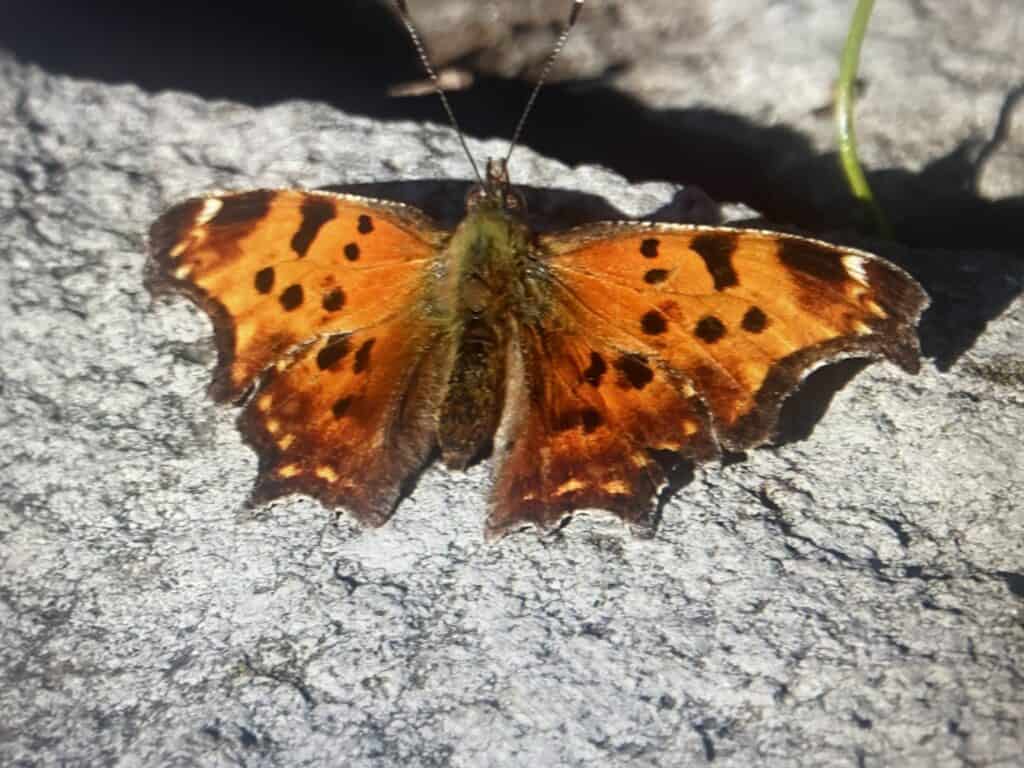
__ 28 ‑ Tonight is the full moon. If you happen to be out enjoying the moonlight and hear a snoring sound coming from the marsh, it’s probably the call of the leopard frog.
__ 29 ‑ The first tropical migrants are arriving back from Central and South America. Among those to be expected right now are northern waterthrush, broad-winged hawk, and chimney swift.
__30 ‑ Northward-bound loons fly over Peterborough on late April mornings. Even if you don’t see the bird, you may hear its yodelling call which is often given on the wing.
May – The Promise of Spring Fulfilled
The world’s favorite season is the spring. All things seem possible in May. – Edwin Way Teale
May usually begins with tree branches bear to the sky. But, as the trees leaf out, the spectrum of pastel greens, whites, browns and reds offers a colour spectacle that almost equals that of fall ‑ at least to those who take the time to appreciate its subtleties and nuances. When warm weather finally arrives, change occurs at a dizzying pace. Woodlots come alive with rafts of trilliums, fields glow with dandelion gold and roadsides and trails beckon us to savour the lovely fragrance of blooming lilacs. Southerly winds this month will push avian migrants north to take advantage of the billions of insects feasting on the smorgasbord of new leaves. The arrival of the birds of May is no less than a reaffirmation of life.
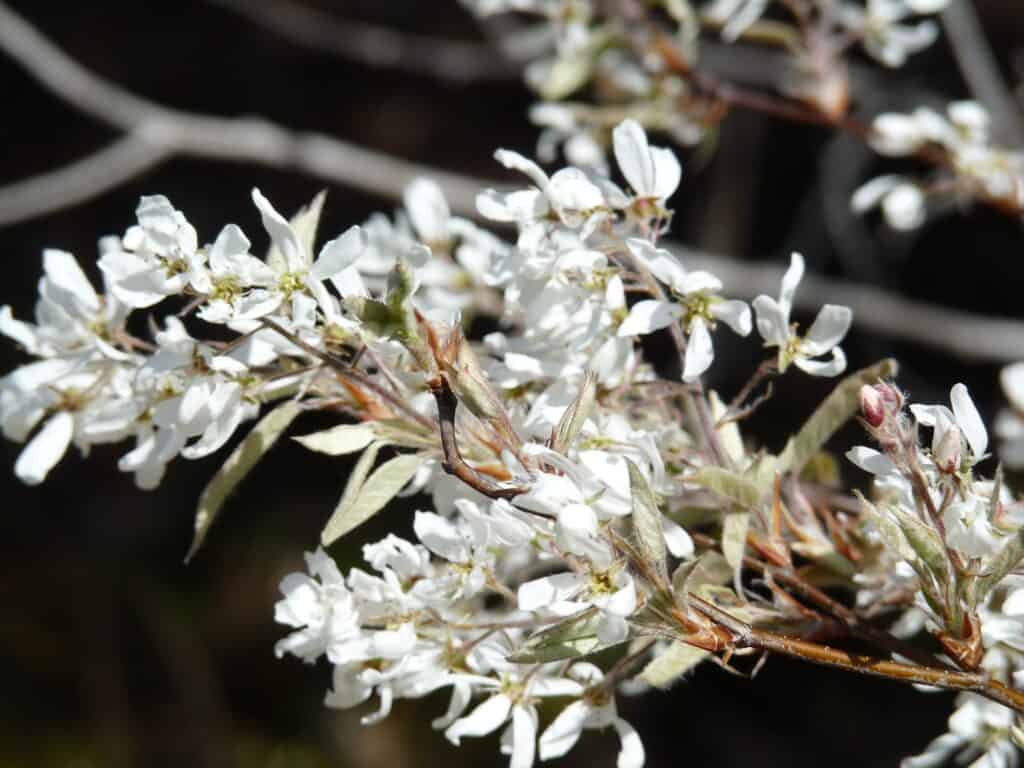
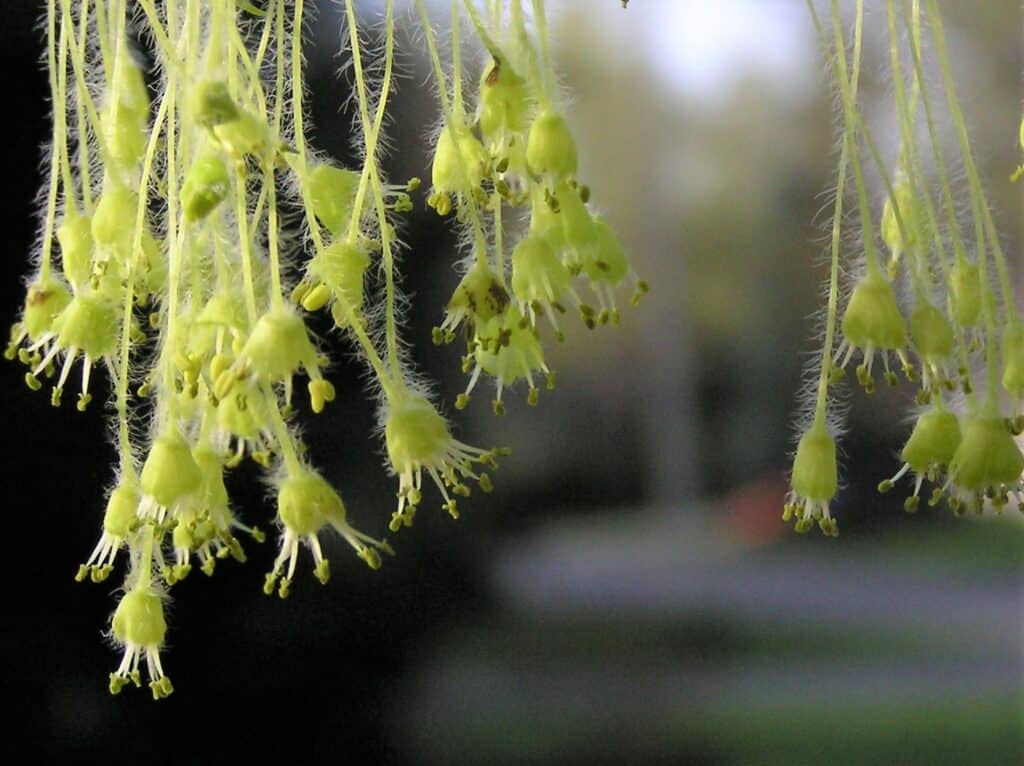
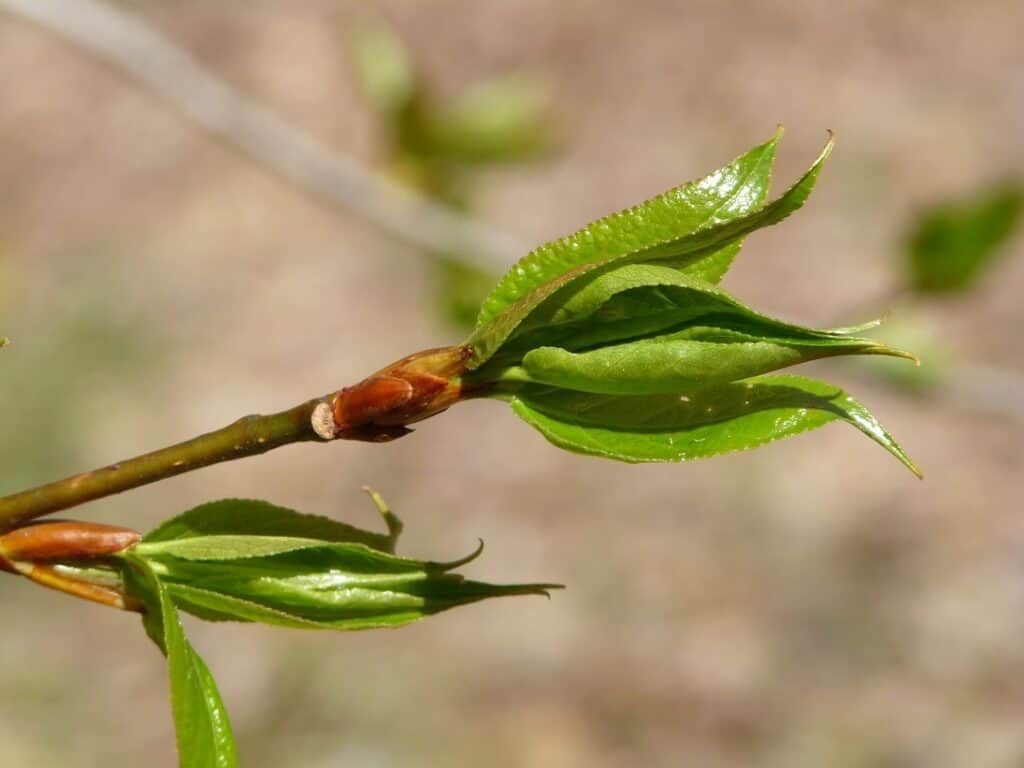
__1 Watch for skeins of high‑flying northen Canada geese passing as they make their way to nesting grounds on James Bay. Most are seen east of Peterborough.
__2 This is the time to see the “spring ephemeral” butterflies such as the Olympia marble, the chryxus arctic and the elfins. Try Sandy Lake Road off of County Road 46.
__3 The white blossoms of serviceberries, also known as Juneberries, are a common sight along country roadsides.
__4 Large, pregnant queen bumblebees forage at flowers and fly low over the ground, searching out an underground chamber in which to start a new colony.
__5 Hummingbirds return from the Yucatan and make a beeline to our feeders. Their natural food at this time includes tree sap oozing from sapsucker drillings.
__6 High in the NE, Ursa Major appears “upside down”, with Polaris and Ursa Minor below it. Today is Astronomy Day with special activities at the Centennial Museum.
__7 Blackflies are usually at their worst about now. One square metre of a fast‑running stream can produce over 30,000 in a season!
__8 The long, fluid trills of the American toad is a characteristic sound of early May. The high-pitched song can be heard both day and night and often lasts up to 30 seconds without a break!
__9 Along trails and roadsides, watch for the light brown stems of horsetails (Equisetum) rising from the ground in colonies. Spore cones are visible on the tips.
__10 Sugar maples appear light yellow from the thousands of yellow flowers in bloom. Within a week or so, they will fall to leave a yellow floral confetti on the ground.
__11 The first dragonflies change from forbidding aquatic nymphs to gracious adult flying machines. The first species seen is usually the common green darner, our only migratory species.
__12 The damp morning air is rich with the fragrance of balsam poplar resin, a characteristic smell of spring in the Kawarthas.
__13 With many species nesting, baby birds are inevitably found and believed to have been abandoned. Rarely is this the case. The cardinal rule is to leave them alone.
__14 The buck white-tailed deer’s antler growth accelerates dramatically as a result of the increased daylight. Males keep a low profile at this time of year and allow does a wide berth.
__15 Songbird migration is at its peak. The greatest numbers of migrating warblers, vireos, thrushes, orioles and flycatchers pass through between May 10th and 25th.
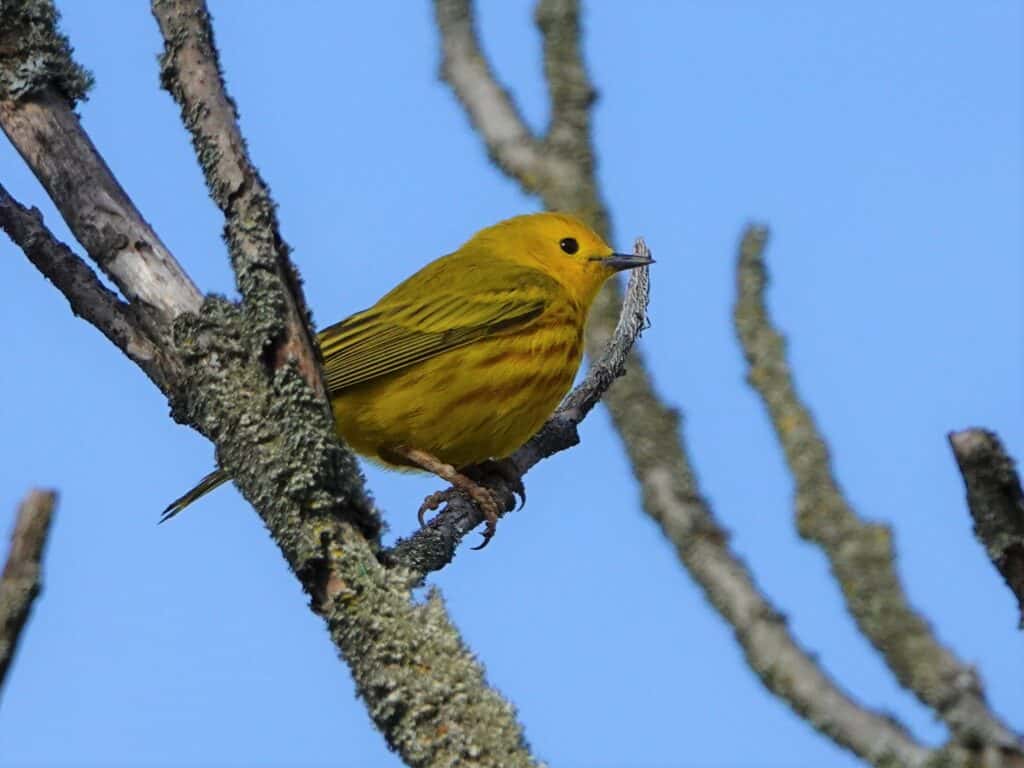
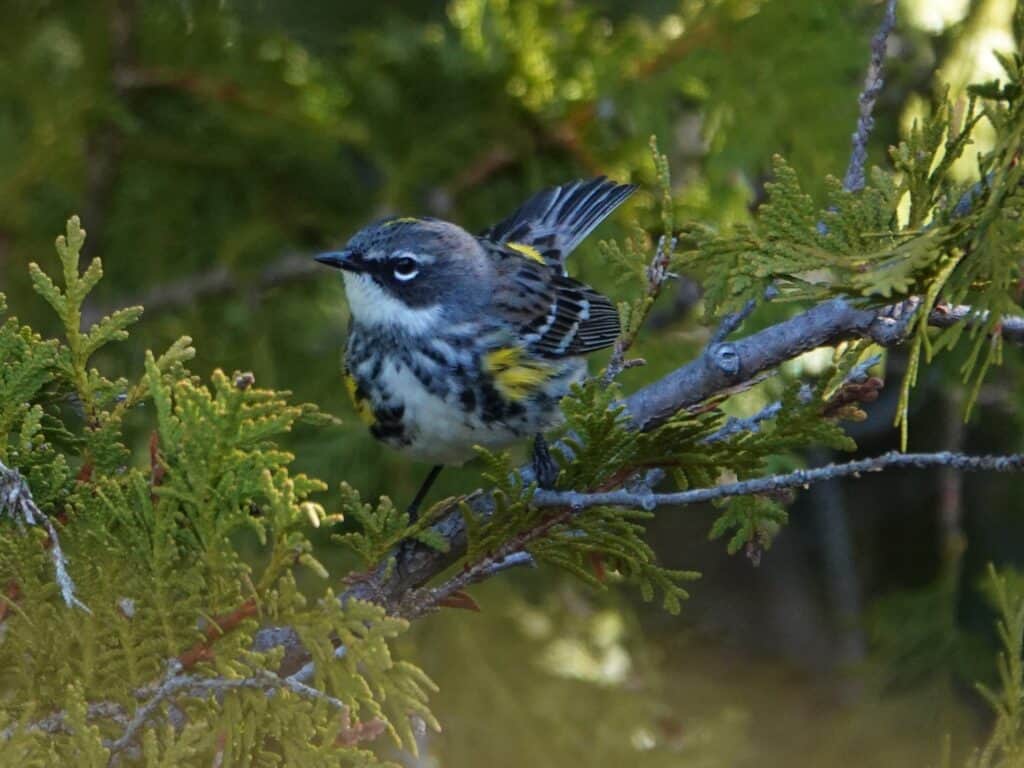
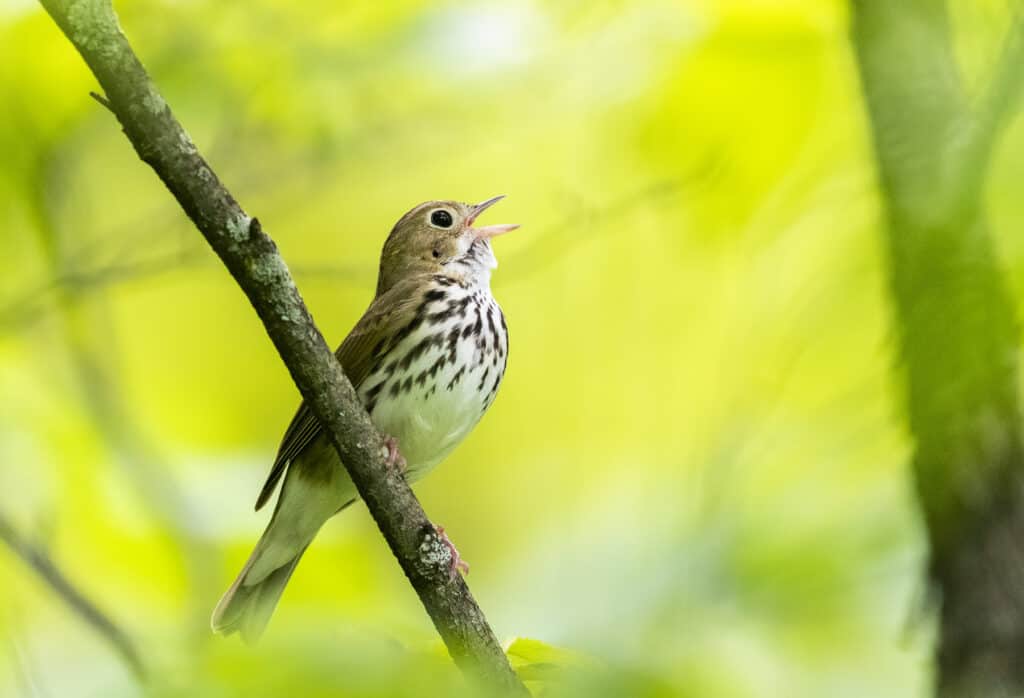
__16 Pin cherries bloom in mid-May at about the same time as lilacs. Mosquitoes become quite noticeable, too, since the males feed heavily on the nectar of cherry blossoms.
__17 Gray treefrogs, green frogs and bullfrogs join the amphibian chorus. Treefrogs sound remarkably like birds and will even call during the day. Listen for them in suburban areas, too.
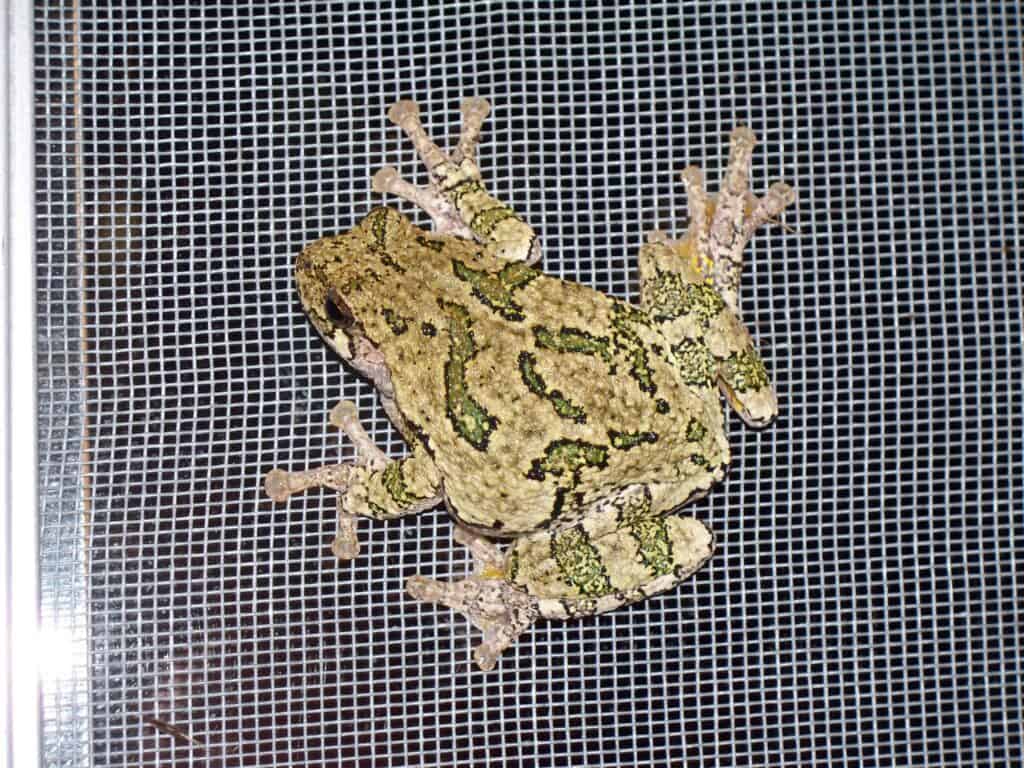
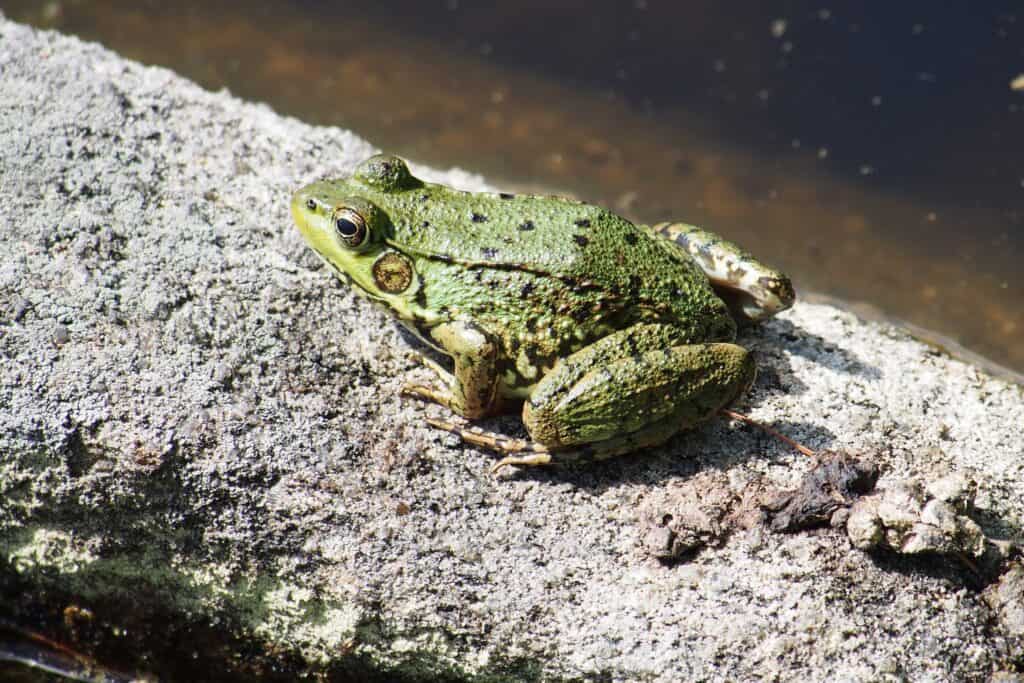
Green Frog
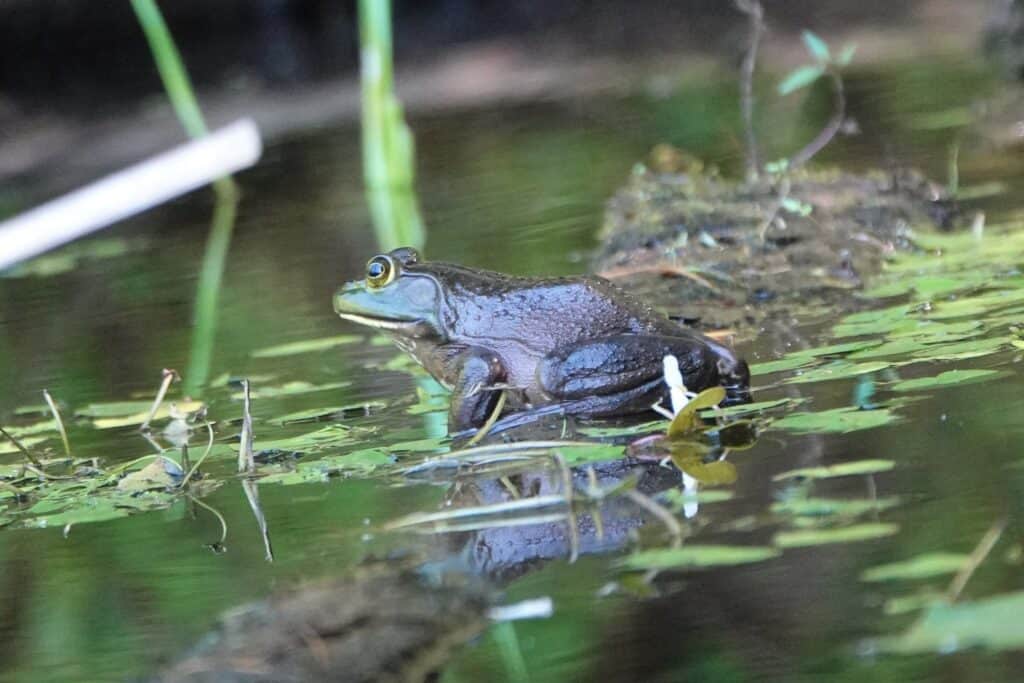
__18 The last frost in the Kawarthas usually occurs about May 18. Frost will generally not occur again until September, giving our area an average of 135 frost‑free days.
__19 Woodlots display a profusion of wildflowers including yellow trout lily, large‑flowered bellwort, spring beauty and, of course, white trillium.
__20 Migrating rose‑breasted grosbeaks and indigo buntings sometimes show up at sunflower feeders, so keep your feeders stocked up at least until month’s end.
__21 Tent caterpillar infestations sometimes reach epic proportions in late May. The eastern tent caterpillar builds a tent into which it retreats at night. Forest tent caterpillars do not make a tent. These are both native species and very rarely ever kill the tree that they feed upon.
__22 May is the time to see moose. Try northern Peterborough County, especially along County Road 507 near Pencil Lake. Algonquin Park is still the surest bet, however.
__23 Birders start looking and listening for the last of the warbler species to arrive, namely the blackpoll, mourning, and Canada. The blackpoll is only passing through, however
__24 Common nighthawks return to the Kawarthas. This species, which used to be common in downtown Peterborough, is suffering a major decline. It is still be found at Petroglyphs and Kawartha Highlands Provincial Parks.
__25 White ash, American basswood, and both red and white oak finally come into full leaf.
__26 Members of the sunfish family such as the small-mouth bass and the pumpkinseed begin to spawn.
__27 Trembling aspens release their seeds, filling the air with white “parachutes”. The seeds of elms, Norway and silver maples spin to the ground as well.
__28 Frothy, white masses of spittle become a common sight on the stems of field plants. They are excreted by spittle-bug nymphs, possibly as protection from predators.
__29 With many grasses now in bloom, grass pollen is a major irritant for allergy sufferers. Most pollen is released in the morning between 8 a.m. and noon when the anthers dry and burst open.
__30 White-tailed deer fawns are usually born in late May or early June.
__31 Canadian tiger swallowtail and black swallowtail butterflies appear by month’s end. They are sometimes seen “puddling” for minerals along trails and dirt roads.
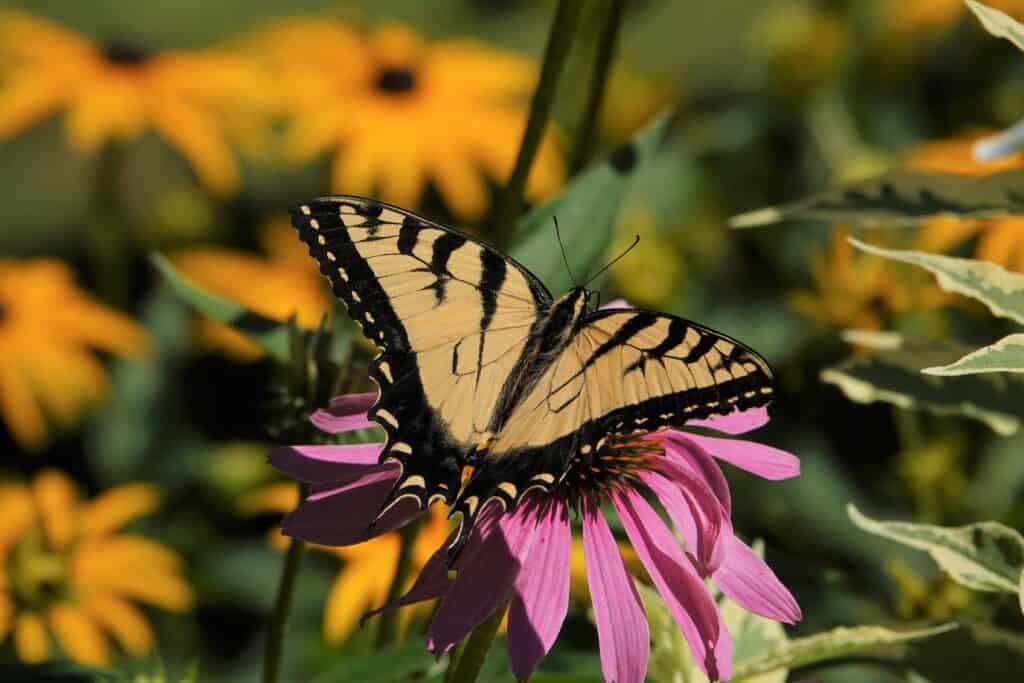
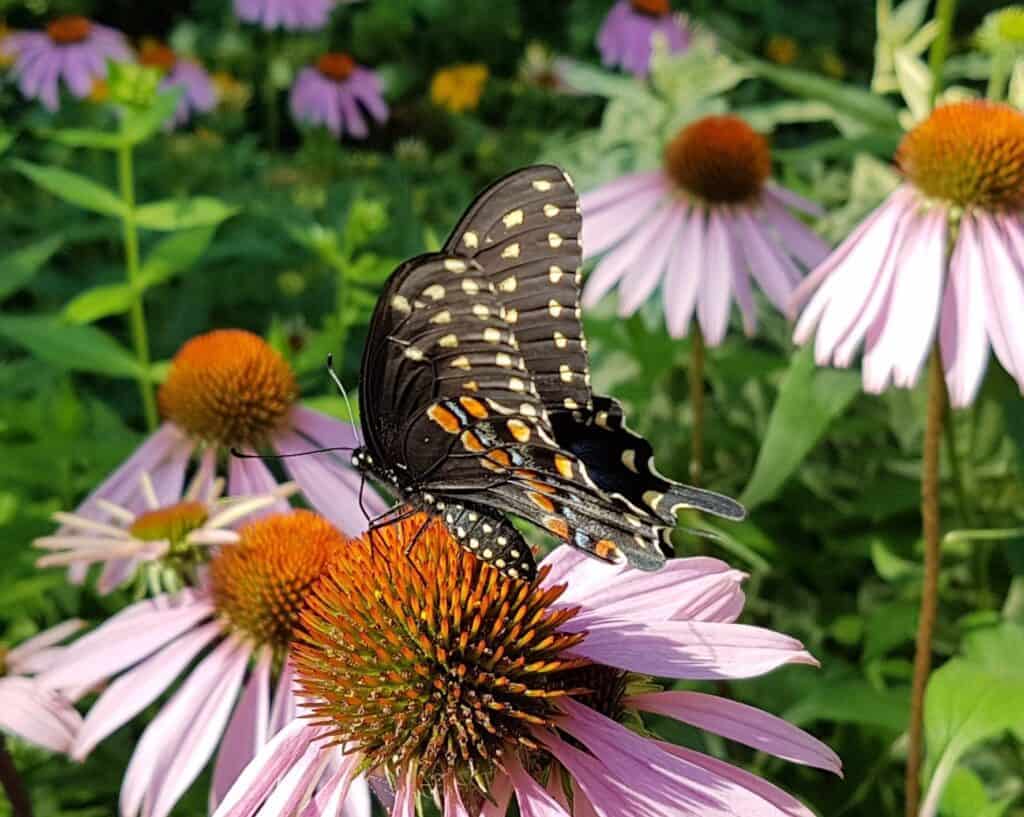
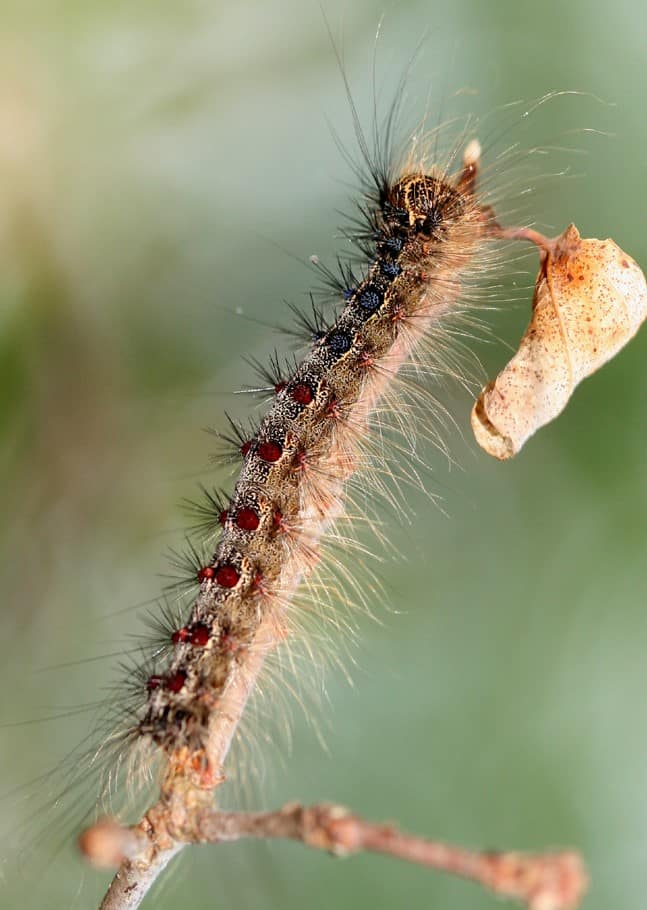
(Tim Dyson)
June – Endless Days and the Urgency of Life
Generous June is a wonderful time to be alive and know this sweet land. – Hal Borland
After the hectic days of May, June ushers in a time of relative calm for those who enjoy observing the natural world. There is still much to be seen, but the pace of change has slowed. It’s a little easier now to keep up with all that is new. The frenzy of spring bird migration has finally ended and most of our trees have already flowered and come into full leaf. We can now turn our attention to gentler pursuits such as dazzling moths and butterflies and breathtaking orchids
The June sun arches higher overhead than at any other time of year giving more than 15 hours of daylight and conveying a sense of unending time. Hal Borland, the former New York Times nature columnist, spoke of the month as “long, sweet days we bought and paid for with long, cold nights and short, bitter days at the dark turn of the year in December.” This is a month to be savoured.
Although many of June’s events can be observed in your own backyard or neighbourhood, a few may require a short drive or some special searching.
__ 1 The annual roadside flower parade begins with mustards and buttercups blooming first.
__ 2 In downtown Peterborough and Lakefield, chimney swifts are putting on quite a show. Pairs can be seen in courtship flight as they raise their wings and glide in a V position. Swifts nest in colonies inside the walls of old chimneys. Like their swallow cousins, they are in serious decline.
__ 3 Common carp are spawning. They can be seen thrashing at the surface of shallow rivers, bays and backwaters. The fish sometimes jump right out of the water.
__ 4 Dragonflies become quite common. Sometimes, thousands of individuals of the same species will emerge on the same day and fill the air around cottages and along country roads.
__ 5 Mother chipmunks force their young to leave the den and to find their own territories. This dispersal is accompanied by a constant barrage of “chuck-chuck” sounds.
__ 6 Birdsong is at its most diverse. Make a point of getting up and listening to the “dawn chorus,”the fervent birdsong that takes place each morning before the sun comes up. Robins usually lead off the show – at least in the city – but a myriad of other species soon joins in.
__ 7 At just about any time this month, adult mayflies emerge from lakes and streams and form large mating swarms. They are most often seen in the evening or early morning.
__ 8 Small-mouth, large-mouth, and rock bass, along with pumpkinseeds and bluegills, are spawning and can be seen guarding their shallow-water nests.
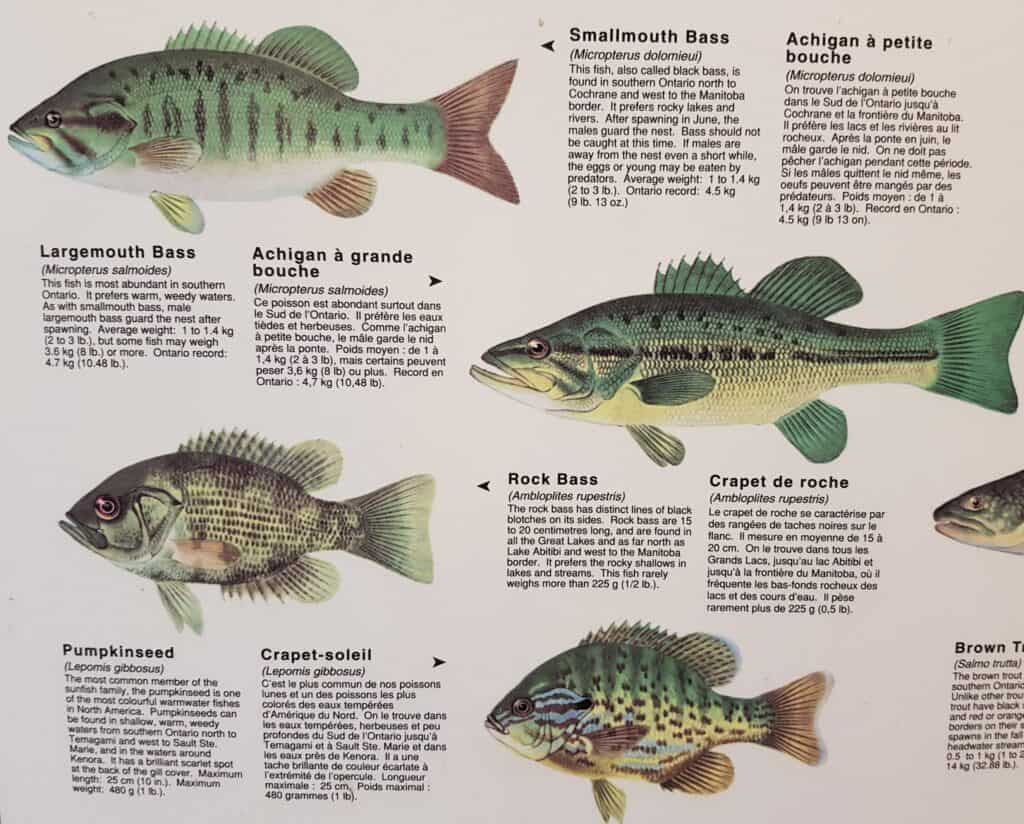
__ 9 Painted turtles and snapping turtles are often seen along roadsides and other sandy locations laying their eggs. Please slow down in turtle-crossing zones and, if safe, help the reptile across the road.
__ 10 On warm, still nights, giant silk moths are sometimes attracted to white lights. They may be seen flying around the light or sitting on the pole or ground. Watch especially for the Cecropia.
__ 11 Serviceberries (Juneberries) are the first shrubs to boast ripe fruit. Silver maple keys ripen about now, too, and fall to the ground in huge quantities.
__ 12 The gray treefrog chorus of melodious, two-second bursts of bird-like trills reaches its peak.
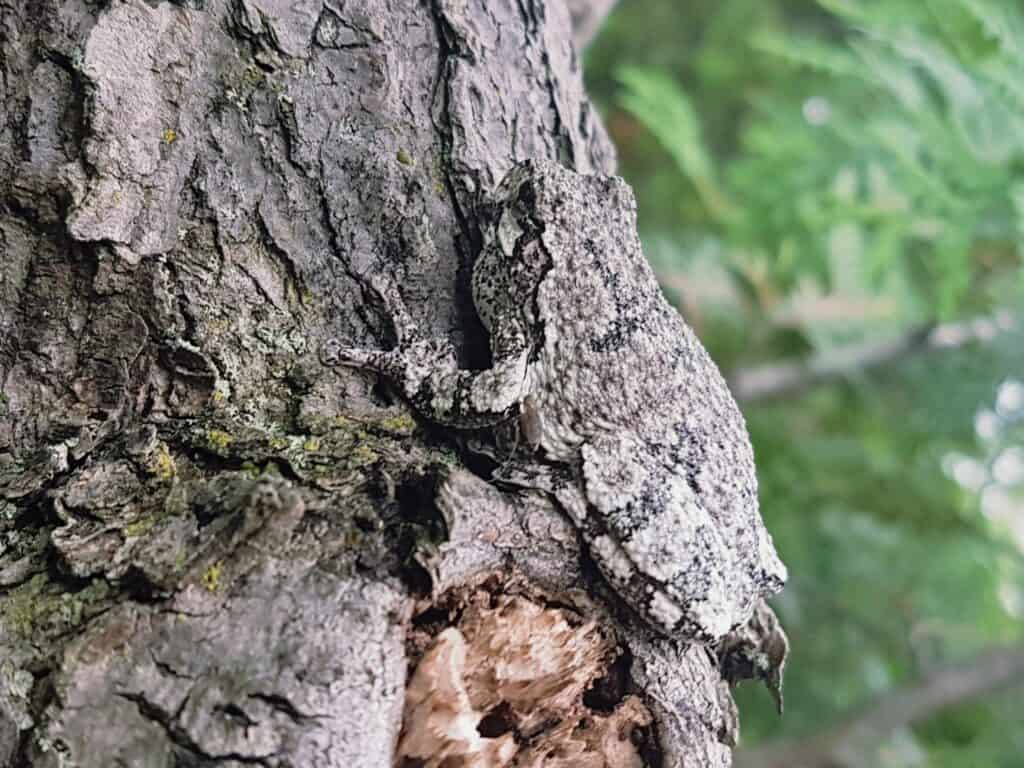

__ 13 Ox-eye daisies and dame’s-rocket bloom in fields and along roadsides.
__ 14 Male hummingbirds can be seen doing their pendulum courtship flight, almost as if suspended from a string. They fly in wide arcs above and to both sides of the female.
__ 15 Black cherries and black locusts come into flower. Locust flowers are extremely aromatic.
__ 16 The green frog’s banjo-like “poink” is a widespread sound in wetlands both day and night.
__ 17 The male cones of white and red pines release their pollen. Decks, picnic tables and shorelines look like they’ve been powdered with a yellow dust.
__ 18 The first monarch butterflies of the new year are usually seen sometime during the first half of June. These are usually the “grandchildren” of the monarchs that flew to Mexico last fall.
__ 19 June through early July is a critical time for loons. The birds are very vulnerable to disturbance by humans as they attempt to nest and care for their chicks.
__ 20 When the weather is dry enough, usually thanks to drying north winds, the first cut of hay takes place. Unfortunately, this often kills the babies of field-nesting birds such as bobolinks.
__ 21 The summer solstice occurs on June 20, 21, or 22, depending on the year. The sun will rise and set farther north than on any other day of the year. At about 1 p.m., it is at its highest point in the sky of the entire year and casts shorter shadows than at any other time.
__ 22 More than 20 species of orchids bloom this month. Among them is the spectacular showy lady’s slipper.
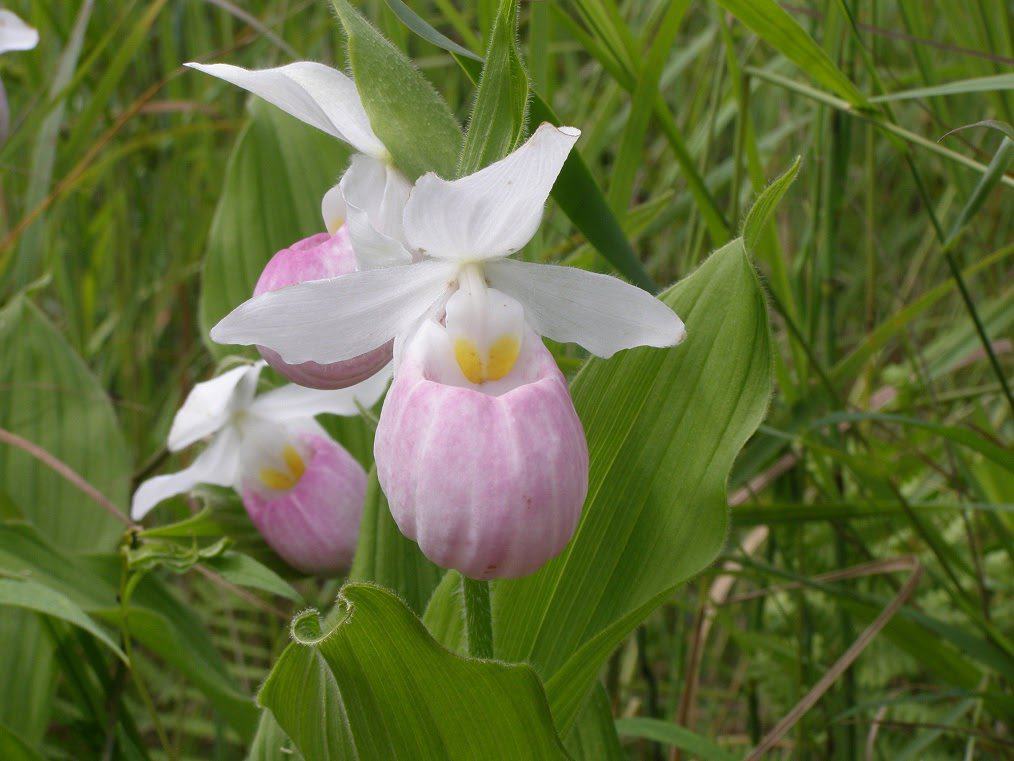
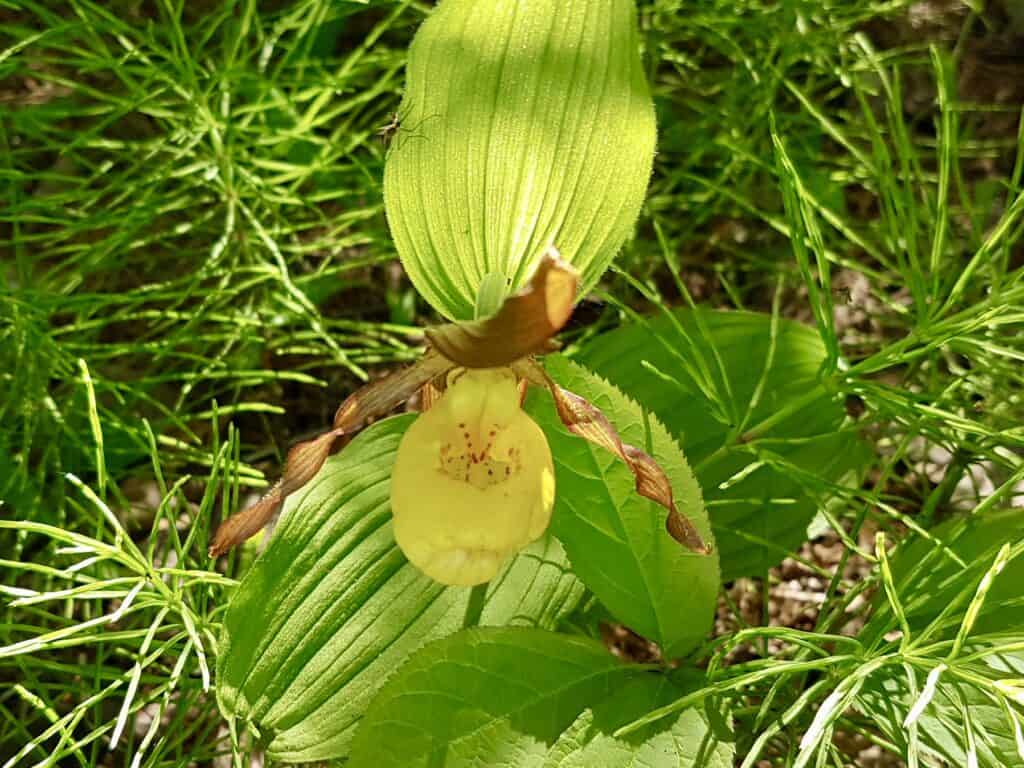
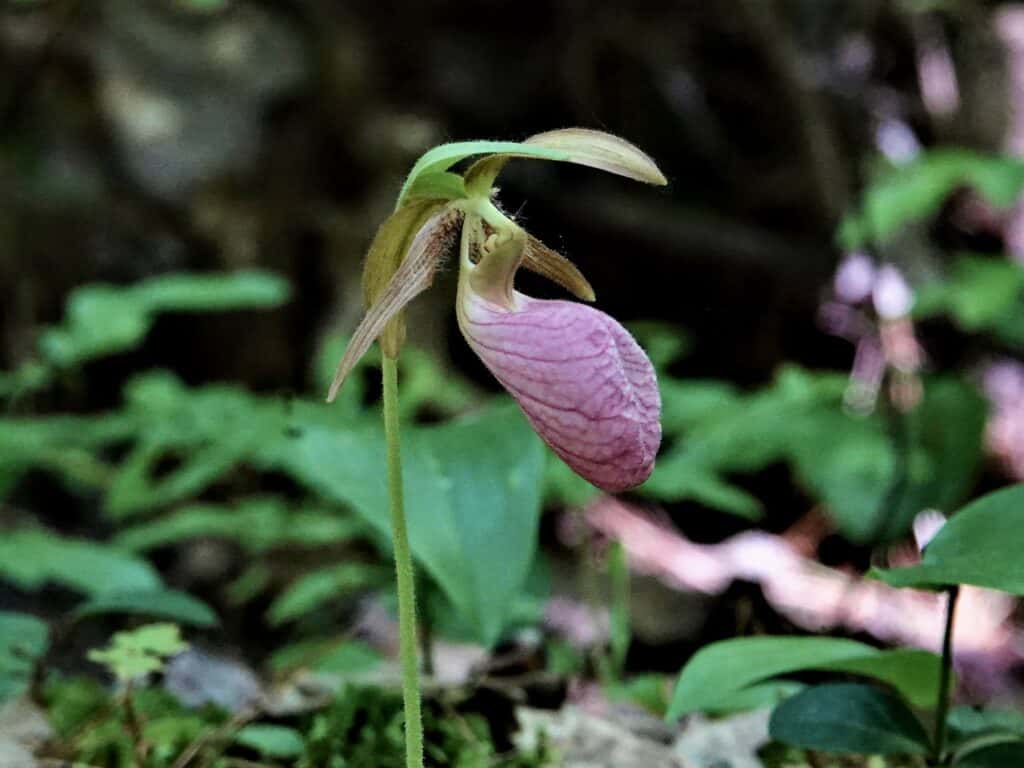
__ 23 The summer stars have arrived. The three stars of the Summer Triangle, Vega, Deneb and Altair, can be seen low in the eastern sky soon after dark.
__ 24 Black bears can sometimes be found in hay fields, grazing on clover and alfalfa.
__ 25 Warm, late June nights are wonderful for firefly watching. The magical flashes of light from the male serve to attract a female. She will respond with her own luminous signal.
__ 26 Crows and red-winged blackbirds have now finished nesting and reform flocks.
__ 27 Butterfly-watching is usually at its most productive in early summer since the greatest number of species is aflight at this time. Tiger swallowtails, white admirals, and tiny Dun and European skippers are particularly noticeable.
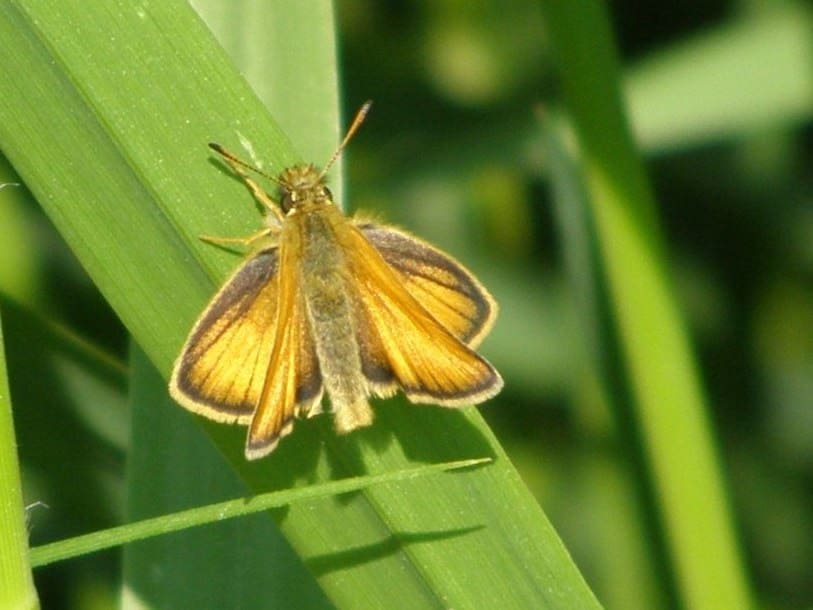
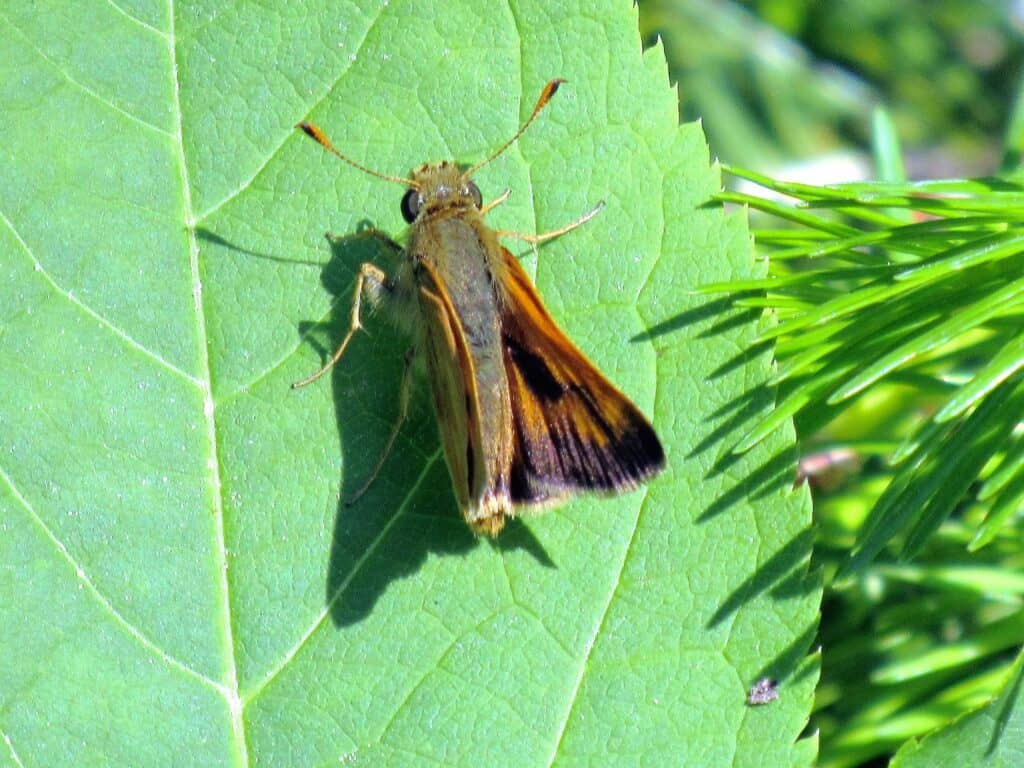
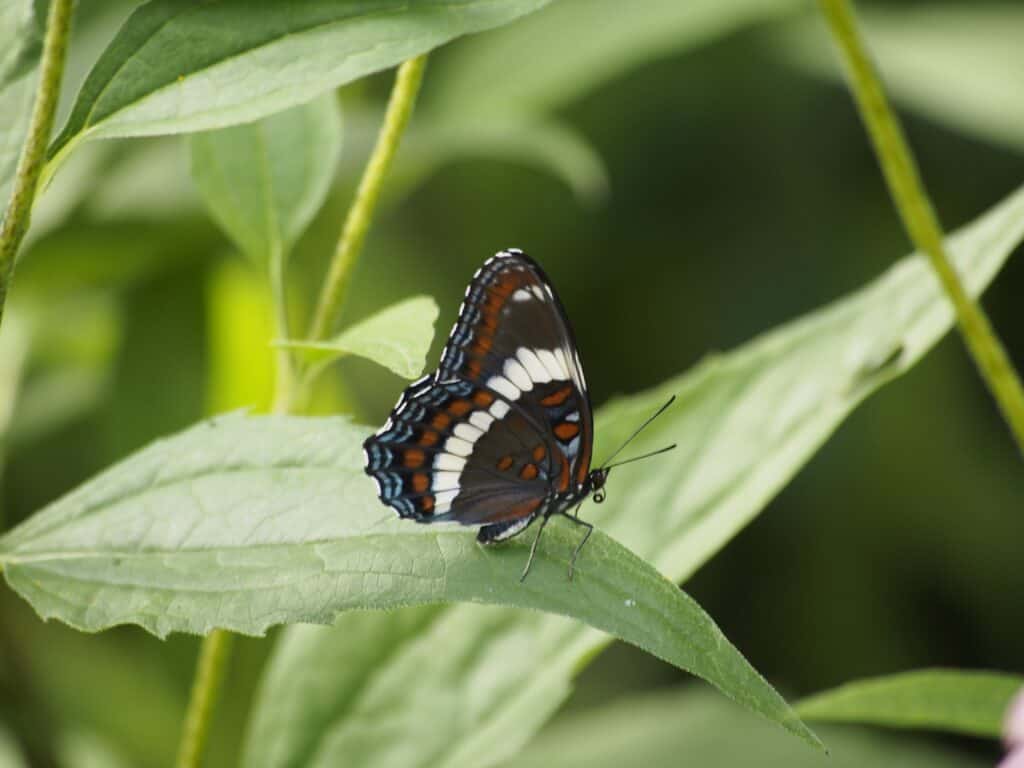
__ 28 Baby loons usually hatch in the last week of June or the first week of July.
__ 29 Look high overhead for Arcturus, the star that heralded the arrival of spring. It is now the brightest star in the sky.
__ 30 Common elderberries, along with cattails, bloom along wetland edges.
July – Summer at Its Height
“Live in each season as it passes: breathe the air, drink the drink, taste the fruit.”
– Henry David Thoreau
July, the seventh month of the year in the Gregorian calendar, represents summer at its height. It is our warmest month with hot, humid and often thundery weather. Roadside flowers are at their most colourful and diverse. The scent of milkweed and basswood flowers fills the air as cicadas buzz in the background. Many bird voices, however, fall silent this month and won’t be heard again until next spring. Blackbirds and swallows flock up and, as a cruel reminder of time’s relentless march forward, the first southward-bound shorebirds start to pass through.
July was named in honour of Julius Cesar who was born in this month. The Anglo-Saxons called the month, ‘Moed-monad’ or Mead-month, from the meadows being then in bloom. Similarly, in Finnish, July is called heinäkuu, meaning “month of grass.” Astronomically speaking, the sun begins the month in the constellation of Gemini and ends in the constellation of Cancer.
__ 1 Having completed their nesting duties, starlings, red-winged blackbirds, common grackles and American crows reform flocks. Flocking provides many advantages to birds such as protection. When the flock is feeding, it only takes a few individuals to watch for enemies. This allows the other birds in the flock to spend their time feeding and preening rather than having to constantly look out for danger.
__ 2 Ox-eye daisies usually dominate roadsides in early July. They are accompanied by other non-native wildflowers such as birdsfoot trefoil, chicory, orange hawkweed and viper’s-bugloss. However, this year, many roadsides have already been taken over by Queen Anne’s lace and white sweet clover, two species that usually flower later in the month.
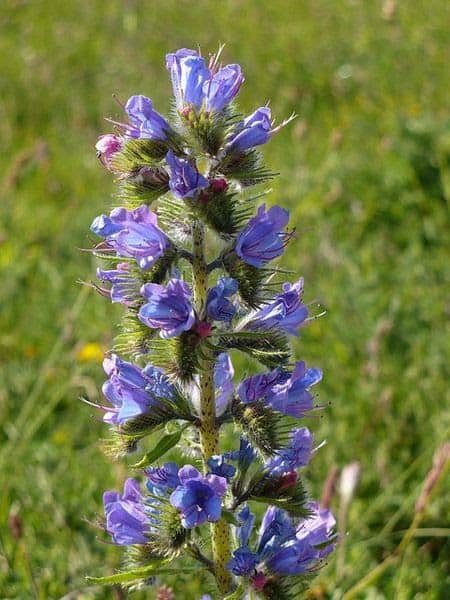
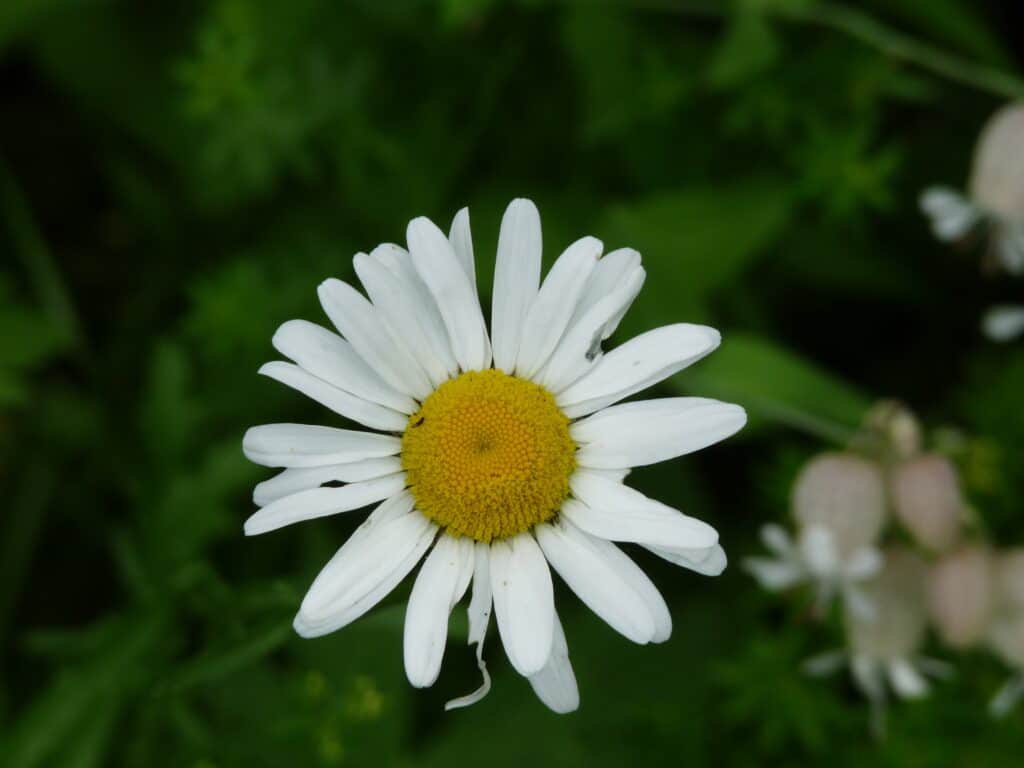
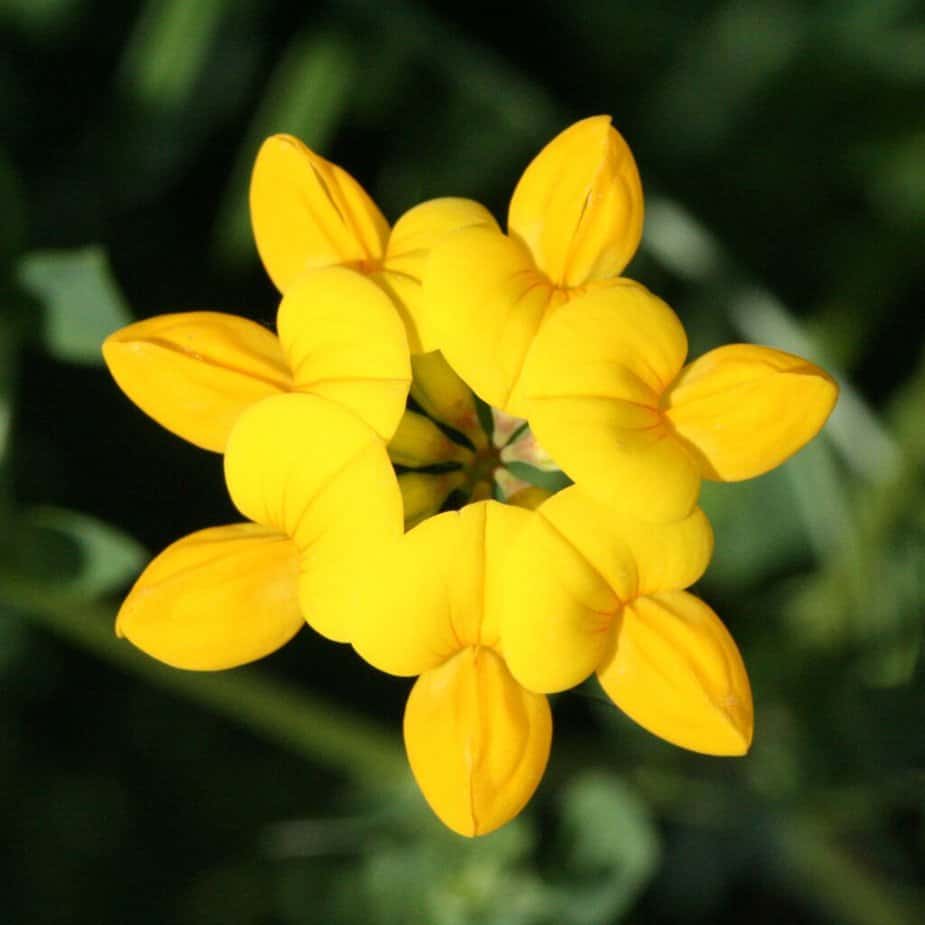
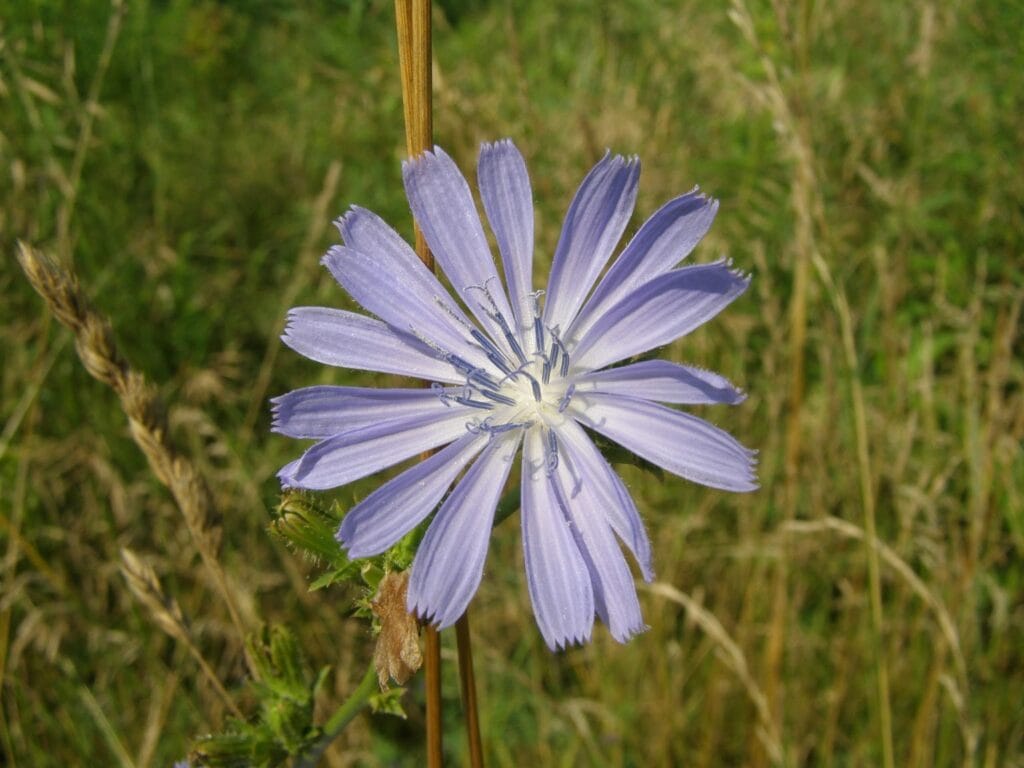
__ 3 If you’re out for an early morning walk alongside a wetland, watch for large, circular spider webs called orbs. Constructed vertically to the ground, a big orb web can be two feet in diameter and have 15 or more “spokes” reaching to the hub where the owner usually sits. Many different species of orb-weaver spiders exist. Dew-covered webs in the morning can make for great photographs.
__ 4 Common milkweed is in flower, and its rich, sweet scent fills the early summer air. Watch for monarch butterfly caterpillars on the leaves. They are striped in black, white and yellow. The number of monarchs reported so far this year appears quite encouraging, especially in light of the heavy die-off they experienced on their Mexican winter grounds.
__ 5 Tiny, moth-like butterflies called skippers are by far the most abundant butterflies this month. They get their name from their fast, erratic style of flight. Watch especially for the European skipper which is easily identified by its brassy, burnt-orange wings. It is usually very common in open grassy places with scattered flowers. Many other similar skipper species can also be seen right now, particularly on the margins of wetlands where flowers abound.
__ 6 American goldfinches breed later than most other birds in the Kawarthas. They usually wait until sometime in late June or early July when thistles have produced their downy seeds. Not only is thistle down used to line the nest but regurgitated thistle seeds are fed to the young.
__ 7 Wetlands are alive now with blooming elderberry, swamp milkweed, white water lily, Joe-Pye weed, purple loosestrife and, by mid-month, jewelweed. Watch also for tall meadow rue in the same habitat. Growing up to six feet tall, the male plant’s flowers have numerous, white, thread-like stamens which make the plant look like it’s covered with fuzzy balls.
__ 8 The buzzy, electric song of the cicada is now filling the void created by the decrease in bird song. Drum-like organs in the near-hollow abdomen vibrate to create the sound. On hot days, males do their best to attract silent females with this signature sound of summer.
__ 9 Cottage roads can be surprisingly good for birding in July and August. Look for trees and shrubs with ripe fruit where birds may be feeding. If you hear call notes, stop and “pish.” You’ll be amazed at all of the birds – including many recently-fledged young – that will pop up to see what the strange noise is. Most will probably be warblers.
__ 10 There is more to the black-eyed Susan flower than meets the eye – the human eye that is. The ultraviolet vision range of bees sees the yellow petals of the flower as three concentric bull’s eye rings surrounding the brown centre. This pattern serves as a guide to lead the bees to their reward of nectar and pollen in the central disk flowers.
__ 11 Family groups of common mergansers are often seen feeding and travelling along shorelines on lakes in the northern Kawarthas. The mother protects the chicks, but she does not feed them. They dive to catch all of their own food.
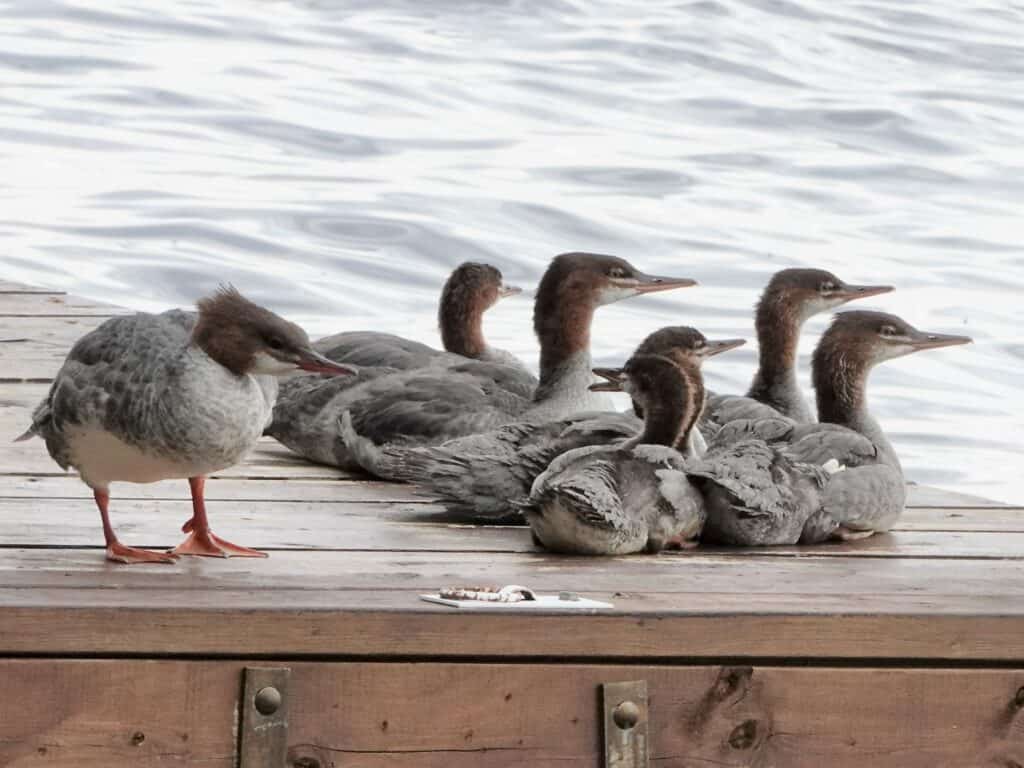
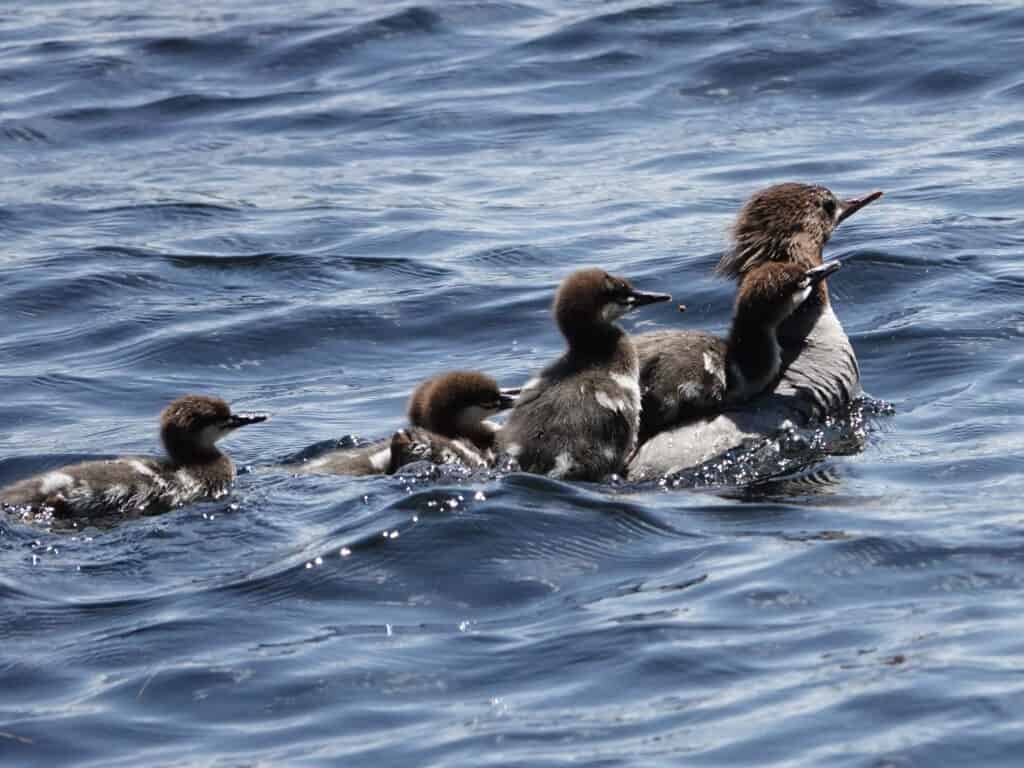
__ 12 With the abundant precipitation we had during June, mushrooms should start to be quite common this month. Watch especially for boletes. Although they are the same size and shape as other mushrooms, they have no gills under the cap, but rather an underside surface full of tiny pores. It’s fun to make mushroom spore prints with boletes. Go to: http://www.mushroomexpert.com/spore_print.html for instructions.
__ 13 The ear-splitting chorus of spring peepers and gray treefrogs has now been replaced by the lazy, laid-back calls of the green frog. Named for the green colour that usually appears on the head or face, this species produces a plucking sound which is remarkably like the twang of a loose banjo string. Green frogs are most vocal at dusk and dawn.
__ 14 As the nesting seasons wraps up, there is a marked decrease in bird song. It’s easy to forget that the primary reason for song is that males want to advertise themselves, be it to declare ownership of territory or to attract a mate. Singing requires a huge amount of energy, so if there is no reproductive imperative to do so, it’s to a bird’s advantage to remain quiet.
__ 15 Signs of the changing season are already upon us as swallows start congregating on roadside wires, especially in the vicinity of farms. Only ten years ago, these flocks used to number in the hundreds of birds with tree and barn swallows dominating.
__ 16 Along cottage roads, watch for thickets of purple-flowering raspberry. A small shrub, it has maple-like leaves and rose-purple flowers about 3 – 5 cm across. The raspberry-like fruits have a nice flavour but tend to be extremely seedy. This species also makes a nice addition to a native wildflower garden.
__ 17 The first southward-bound shorebirds begin to pass through. Watch especially for semipalmated sandpipers, pectoral sandpipers and yellowlegs. The Otonabee Gravel Pit Conservation Area is often a good place to see shorebirds in Peterborough County. However, Presqu’ile Provincial Park offers our area’s best shorebird-watching opportunities.
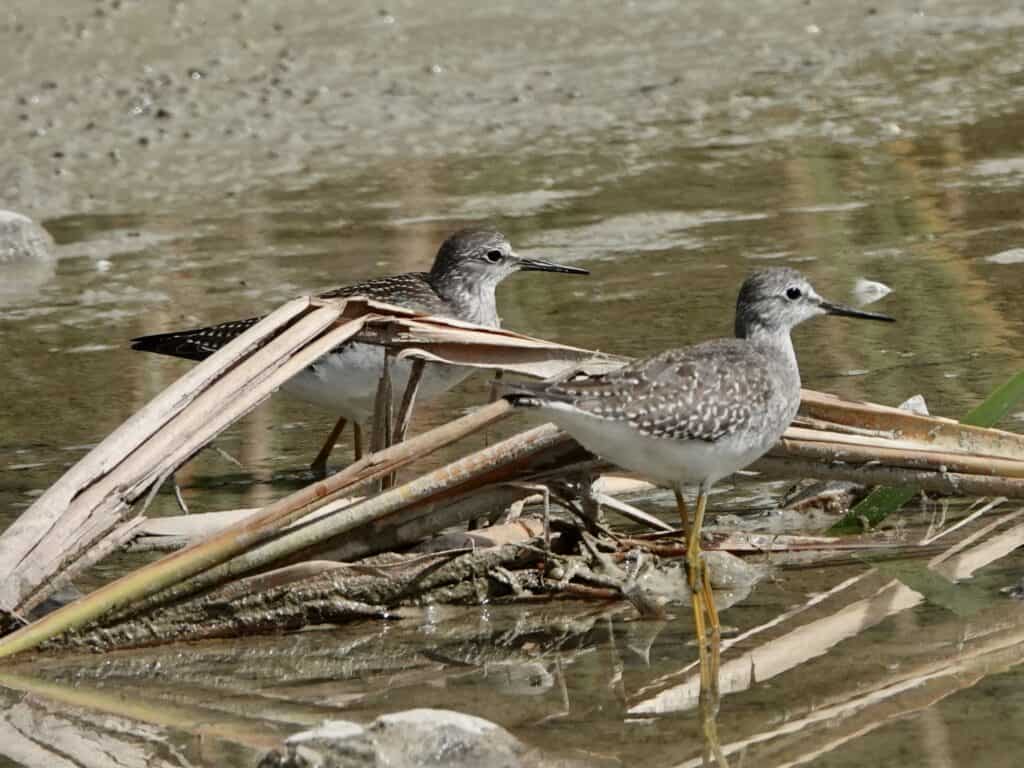
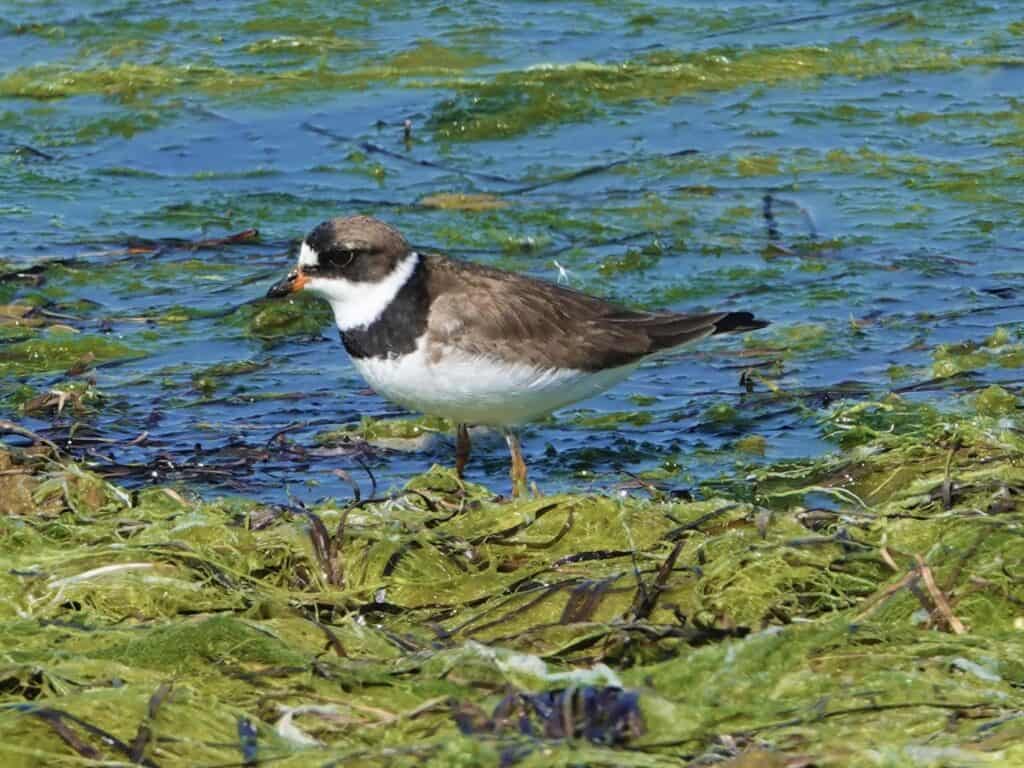
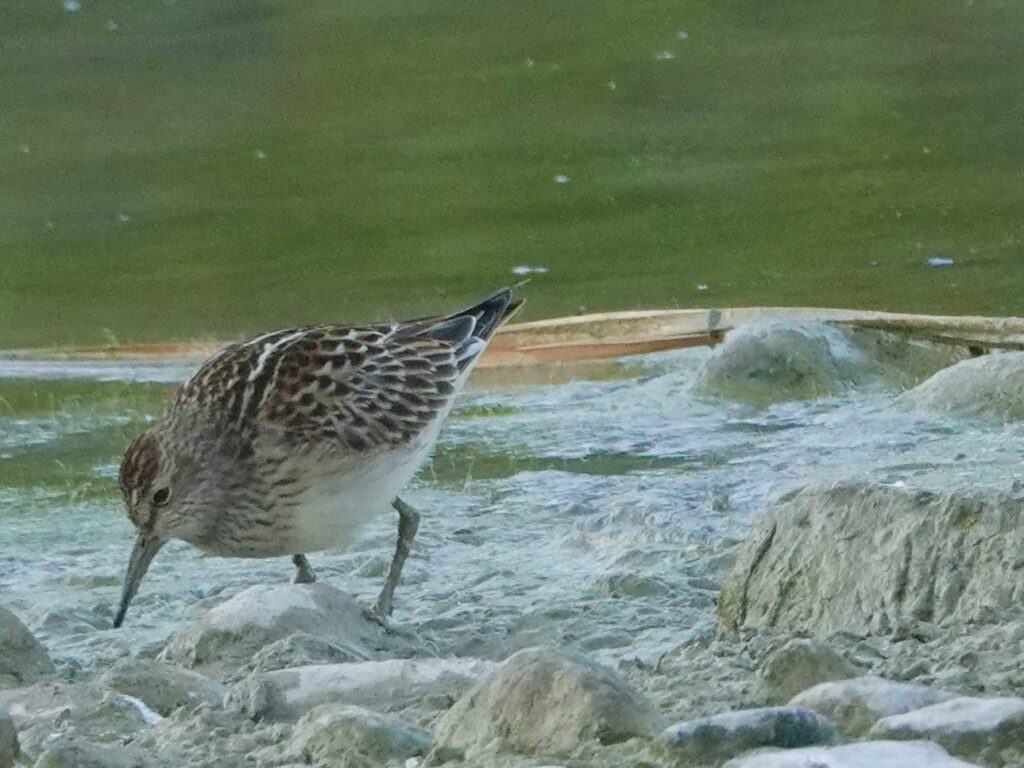
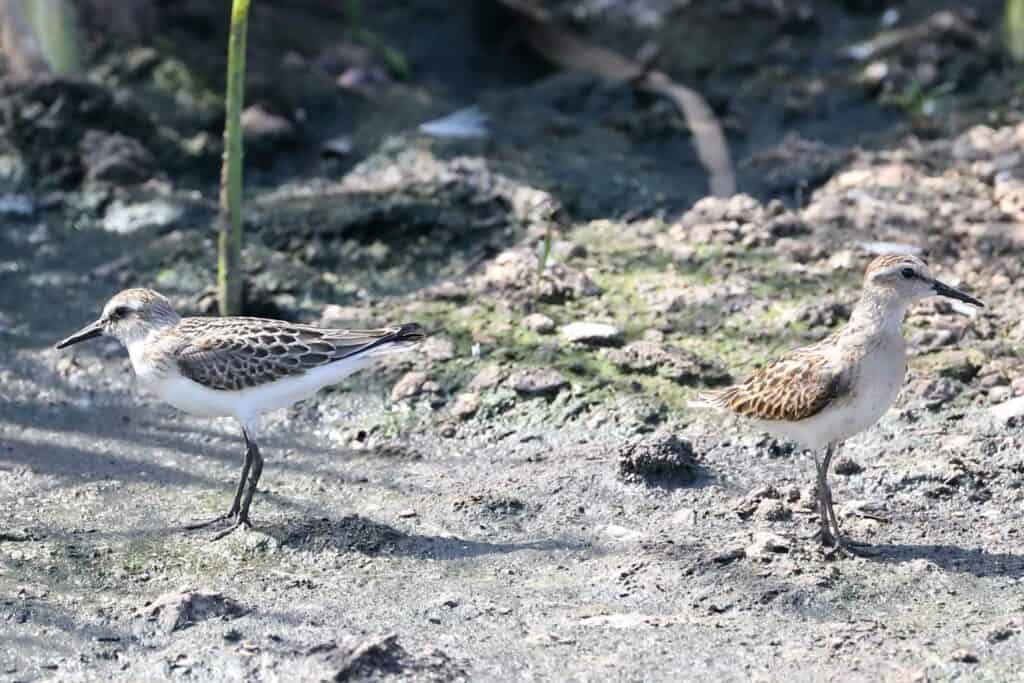
__ 18 Watch for the uncommon map turtle basking on rocks in larger lakes such as Stony. They often do their sunbathing piled one on top of the other!
__ 19 July is a great time to take a break from birding and to turn your attention to our many species of butterflies. Among the most common July species are the European skipper, Dun skipper, eyed brown, northern pearly-eye, clouded sulphur, cabbage white, great spangled fritillary, northern crescent, white admiral, red admiral, and, of course, the monarch. Close-focusing binoculars and a guide book are a must. You may also wish to take a picture of the butterfly with your digital camera and then use the digital zoom feature to get a close-up look at the various field marks. A good website for butterfly identification can be found at http://www.butterfliesandmoths.org/
__ 20 Identifying and photographing dragonflies is also a wonderful way to spend a summer afternoon. You should have no trouble finding the dot-tailed whiteface, common whitetail, four-spotted skimmer, and chalk-fronted skipper. Go to http://www.odonatacentral.org/ for pictures of all the North American dragonflies and damselflies.
__ 21 The days are slowly growing shorter. Sunset (8:50 p.m.) is only about 10 minutes earlier now than it was at the summer solstice in June. Sunrise (5:49 a.m.) is just 20 minutes later.
__ 22 Local lakes reach their warmest temperatures this month. The average is about 23C. This warm water sits on top of much colder water that remains at 4C all summer long, thereby creating two “separate lakes” which do not mix.
__ 23 Deer flies are very common throughout July. Slightly larger than house flies, they are mostly yellow or black with dark markings on the wings. They have brilliant green or golden eyes. Deer flies persistently buzz around your head until they decide to land and dine!
__ 24 Solitary sandpipers are now passing through the Kawarthas after completing nesting duties in the far north. As its name implies, this species is always found alone, often along the edge of small wetlands.
__ 25 The branches of cherries, honeysuckles and dogwoods bow over with ripe berries. Many bird and mammal species gorge themselves accordingly.
__ 26 Being opposite the high-riding summer sun, the summer moon is always low in the sky. This means that summer moon shadows are much longer than those of winter. The low moon also makes for romantic, long moonbeams over the water.
__ 27 The margins of shallow bays turn purple in late July and early August when pickerel weed flowers. It is thought that the name “pickerelweed” comes from the fact that this plant shares its shallow-water habitat with the fish of the same name.
__ 28 If you are out in the early morning, watch for dew droplets sparkling on the leaves of jewelweed, hence the name. When the seeds are ripe, the inch-long pods explode when touched, scattering seeds in every direction. This explains the plant’s other common name of touch-me-not.
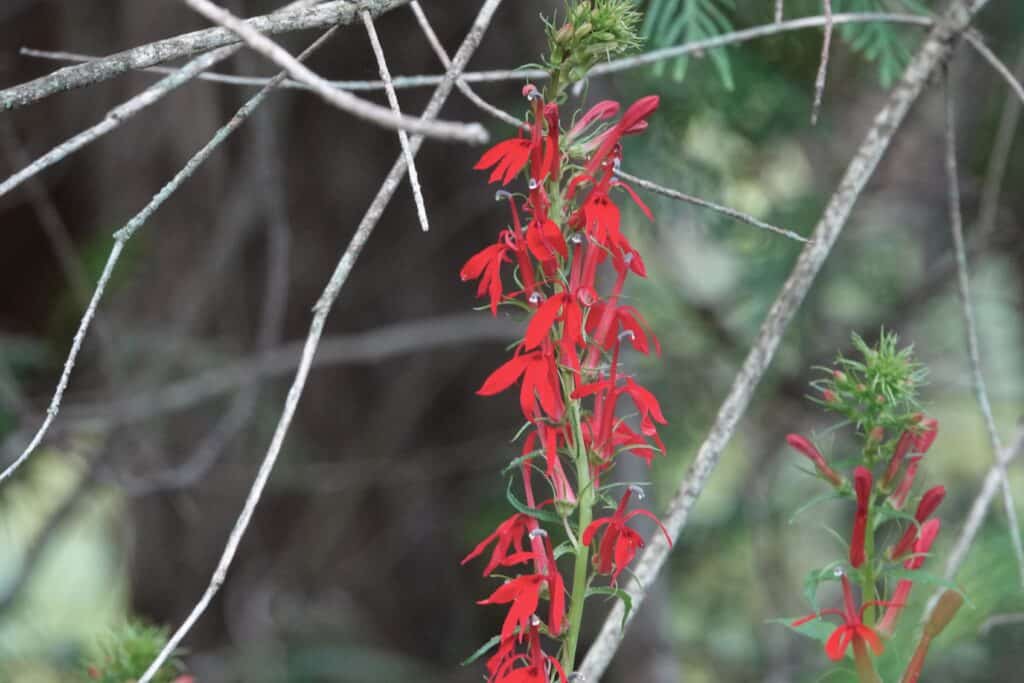
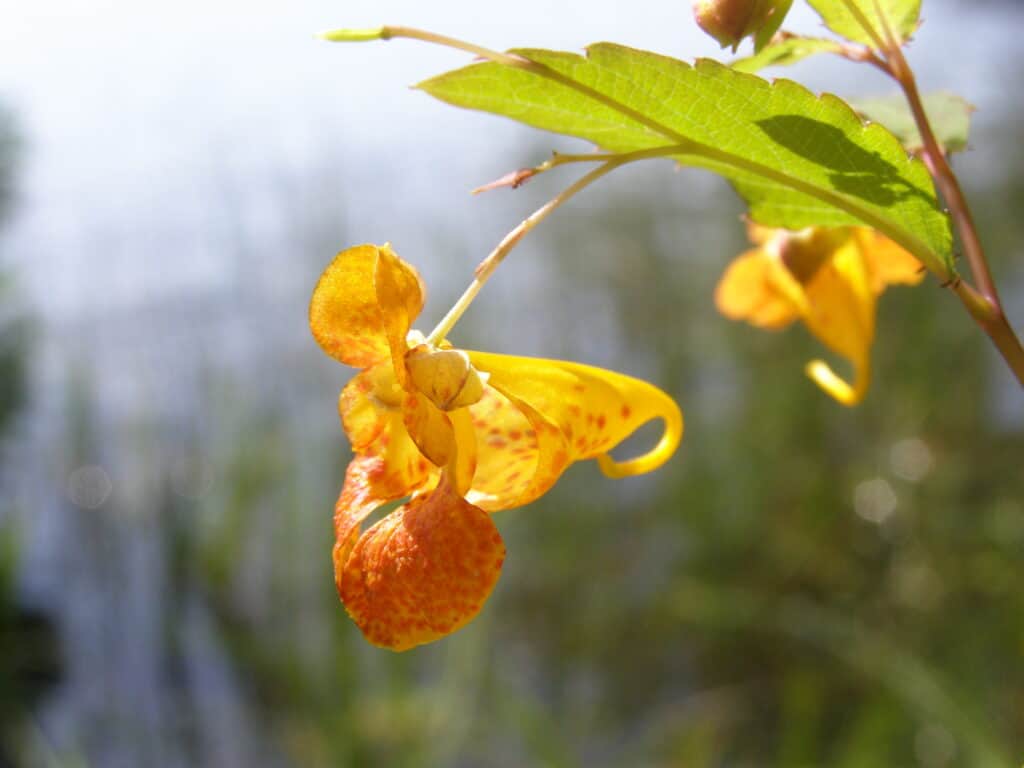
__ 29 The Summer Triangle and Milky Way dominate the night sky. As for the Big Dipper, it is suspended high in the northwest. The two stars that form the handle-end of the Dipper’s bowl point almost directly to Vega, the brightest star of the Triangle.
__ 30 If you’re lucky, you may find scarlet cardinal flowers in bloom along lake shores and the margins of wetlands. They are highly sought by nectar-seeking hummingbirds.
__ 31 Pegasus, the signature constellation of fall, becomes visible along the northeastern horizon in the late evening. It reminds us to enjoy summer now because it won’t last!
August – Summer Becoming Fall
The real voyage of discovery consists not in seeking new landscapes but in having new eyes. – Marcel Proust
Henry David Thoreau, the great American naturalist and philosopher, once observed “how early in the year it begins to be late.” How true this is. Despite weather which is often hot and sultry, August delivers each year the first real signs of fall. The frantic plant growth and animal activity of spring and early summer have now been replaced by an almost lazy feeling of calm. The avian and amphibian choruses of only a few weeks ago have mostly fallen silent and given way to a more gentle orchestra of cicadas, grasshoppers and crickets. Bird migration is already under way, the first leaves are beginning to change colour and roadsides will soon be transformed by a yellow cloak of goldenrod.
Despite the premonitions of summer’s end, August is still very much a month to be savoured. Among the month’s delights are the delicious taste of fresh corn and tomatoes, the calming sight of misty dawns, the often clear, cool nights illuminated by the Milky Way and the sound of snowy tree crickets calling in perfect unison as we fall asleep.
With late August comes the anticipation of bright, cool September weekends and the riot of leaf colour that is just around the corner. In a cultural sense, August is much more the end of the year than is December. With Labour Day, our lives begin anew as school reconvenes and countless community activities begin again.
__ 1 Blue jays once again become quite vocal. Along with the “lisping” of cedar waxwings, the calls of jays are typical August bird sounds.
__ 2 However, other than the sporadic singing of a handful of species such as red‑eyed vireos, northern cardinals, mourning doves, peewees and song sparrows, most bird song ‑ as opposed to calls ‑ has ceased.
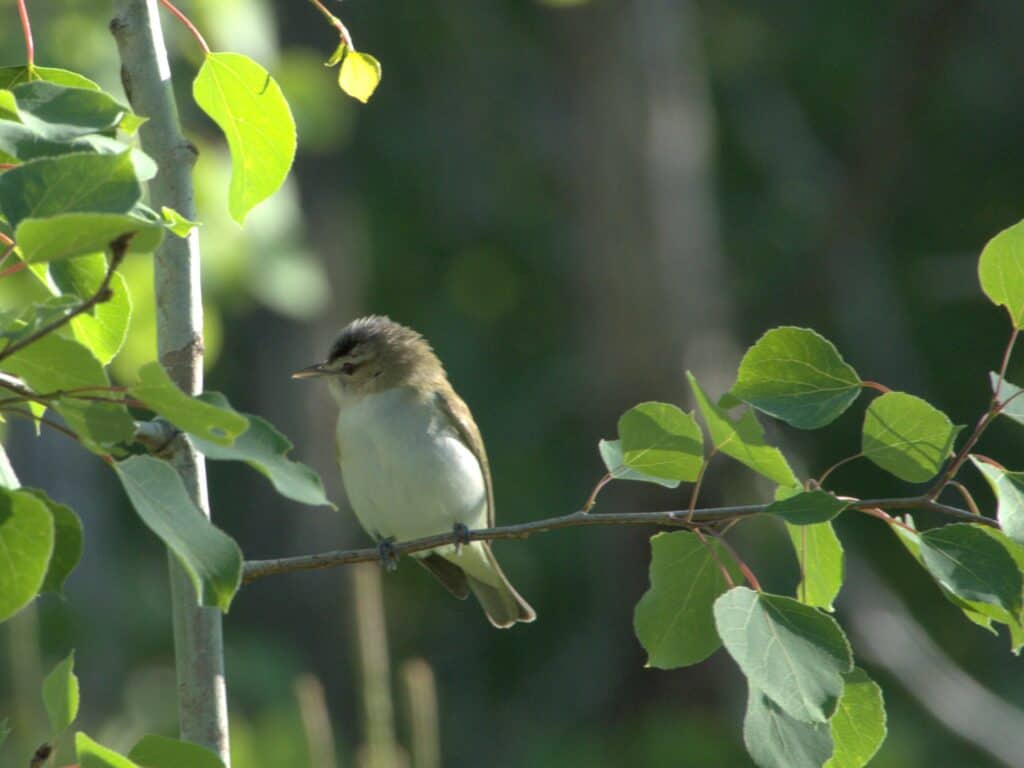
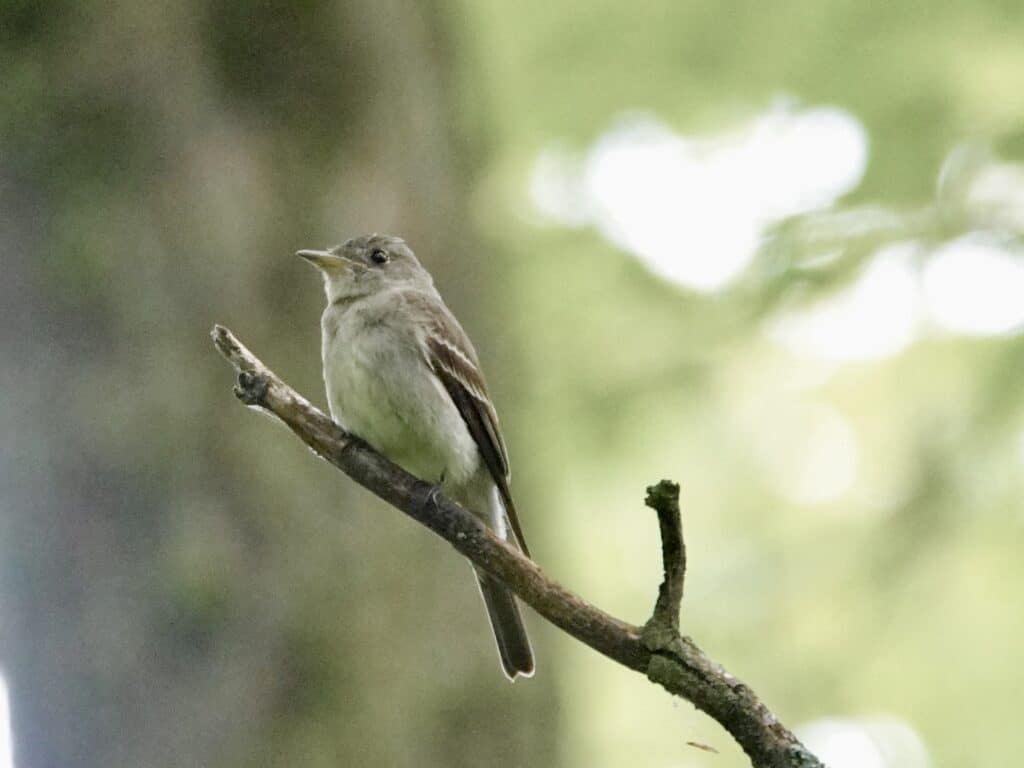
__ 3 Some of the interesting wildflowers plants that bloom in early August include woodland sunflower, turtlehead, and large-leaved aster. Petroglyphs Provincial Park is a good destination for botanizing.
__ 4 Leopard frogs wander en masse from their wetland habitat to invade nearby fields. They feed heavily on the bounty of insects to be found there.
__ 5 Queen Anne’s lace continues to dominate roadsides.
__ 6 The electric, buzzing sound of the cicada makes the mid‑day heat seem even hotter.
__ 7 At this time of year, the “Dog Star,” Sirius, rises in the southeast just before the sun. Because its appearance often coincides with the hottest days of summer, this period became known as the “Dog Days” of summer.
__ 8 Water levels often drop in late summer, revealing emergent shorelines. These sites are worth exploring for interesting plants such as bladderworts.
__ 9 Underwing moths, named for the bright colours of the underwings, are easy to find in August. You can actually attract them by spreading a bait concoction on tree trunks and checking it after dark. Try a mixture of stale beer, mashed bananas, molasses and a shot of rum!
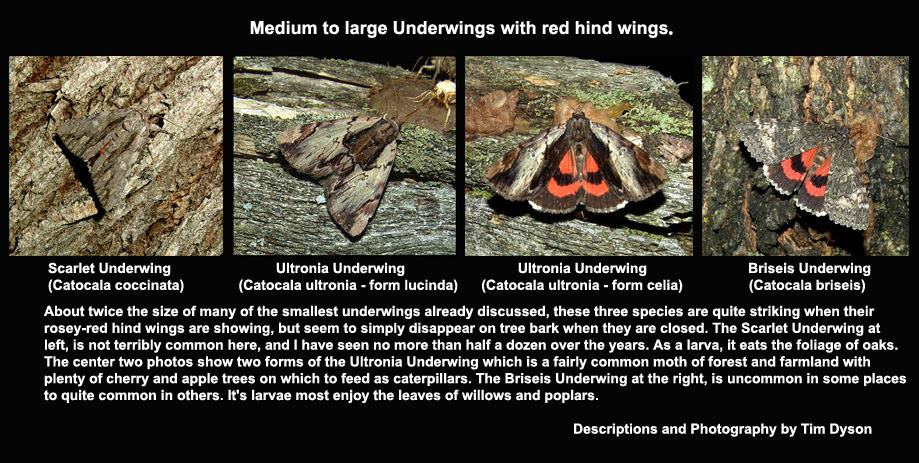
__ 10 Large groups of loons are sometimes seen on the bigger lakes. 10 or more birds often come together in these “convocations” and appear to talk to each other in chuckles and clucks. The gatherings would therefore appear to have a social function.
__ 11 Green frogs and gray tree frogs may continue to call sporadically during the day. However, these calls never amount to a full chorus.
__ 12 The Perseid meteor shower peaks on August 12. Even with an almost full moon this year, it should still be possible to see a dozen meteors an hour.
__ 13 If you’re out walking along our rail‑trails or gravel roads, watch for Carolina locusts. With their yellow‑bordered wings and the crackling sound they make as they fly, they are hard to miss.
__ 14 In August and throughout the fall, family groups of otters can often be seen feeding and frolicking in quiet lakes including Lily Lake just west of Peterborough.
__ 15 A profusion of ripe wild fruits can be found on various shrubs and small trees such as chokecherry, raspberry, Virginia creeper, elderberry and blueberry.
__ 16 Red maples along the edges of lakes and wetlands are the first trees to show splashes of fall colour. Virginia creeper and staghorn sumac may also show colour change.
__ 17 Bald‑faced hornets, the wasp species that makes the globe‑shaped paper nests in trees, are common. It is black with yellowish‑white markings on the face and should be treated with respect.
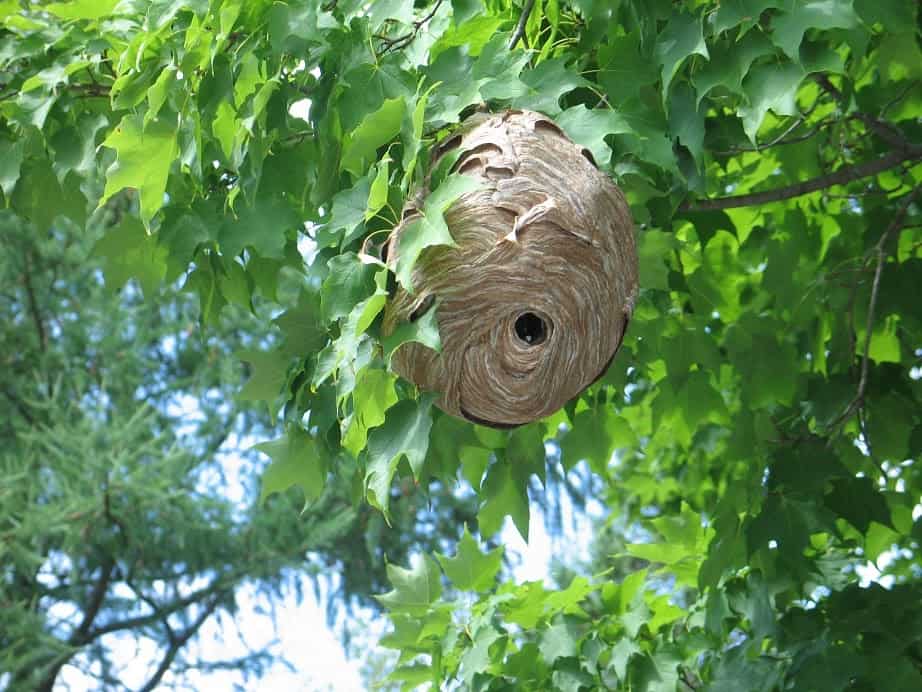
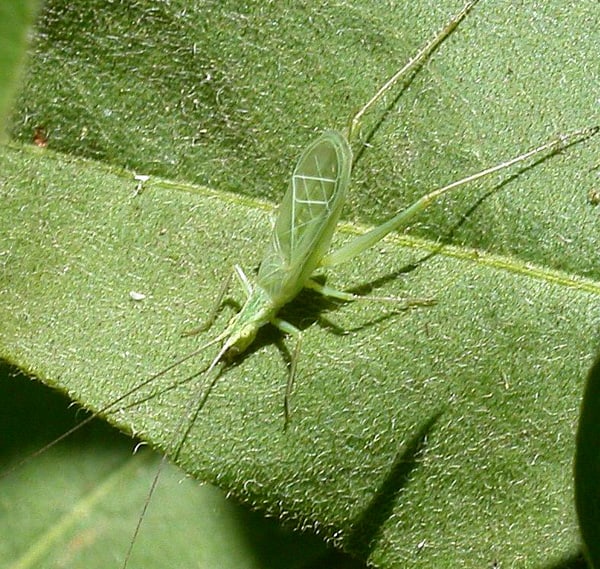
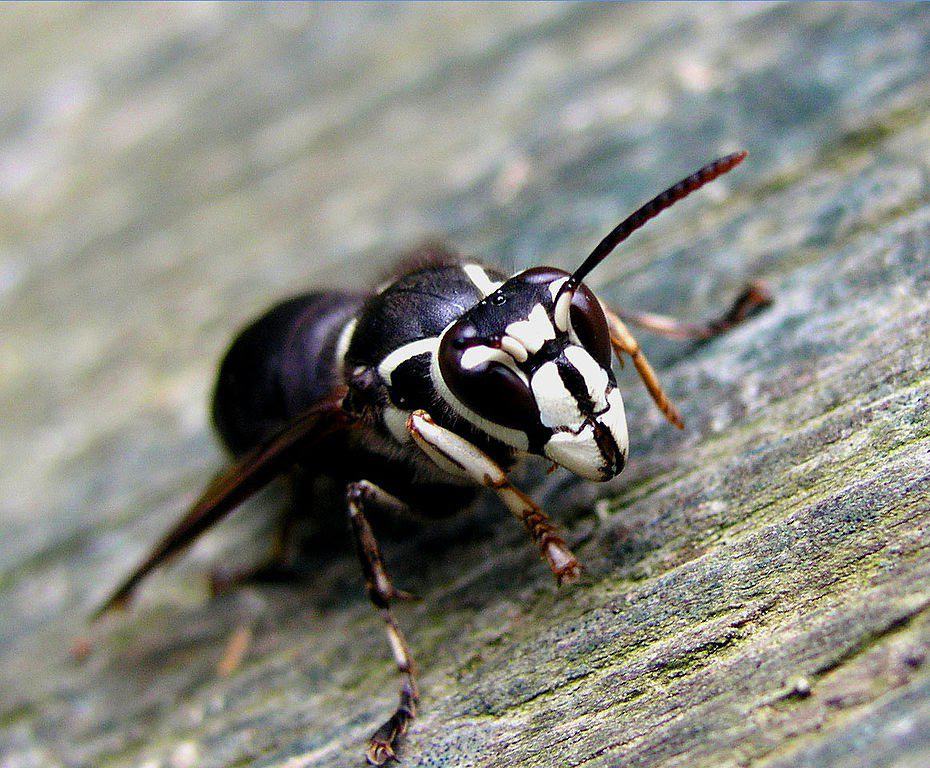
__ 18 Ragweed is in bloom. The pollen from its tiny green flowers sets off the beginning of another hay-fever season. Goldenrod is not the culprit!
__ 19 Monarch butterfly numbers are usually at their highest by about now. Yellow sulphur butterflies are also quite common, especially over fields of alfalfa.
__ 20 Songbird migration is in full swing, with numerous warblers, vireos, and flycatchers moving through. By making a “pish” sound, you should be able to draw the birds in and get good views. If you hear chickadees, you are almost certain to find warblers with them. Some local hotspots during migration include the Lakefield Sewage Lagoons, the South Drumlin Nature Area at Trent University and Meadowvale Park in Peterborough.
__ 21 Small dragonflies known as meadowhawks become very common. In most species, the males are red and the females are yellow.
__ 22 If you’re lucky, you may see flocks of migrating nighthawks in late afternoon or early evening.
__ 23 A large variety of mammals gorge themselves on late summer fruit and nuts. Bears are especially fond of beech nuts and sometimes leave large piles of broken branches high in the beech trees where they’ve been feeding.
__ 24 The soft, rhythmic “treet…treet…treet” of snowy tree crickets is a common sound in parts of Peterborough. Sounding almost like a gentle-voiced spring peeper, this is the insect you often hear calling in campfire scenes in Westerns. By counting the number of chirps in seven seconds and adding five, you can make an accurate estimation of the temperature in degrees Celsius.
__ 25 Milkweeds attract a huge variety of insects including tuft‑covered milkweed tussock moth caterpillars and the red and black milkweed bug. Now is also the best time to look for the yellow and black larvae of the monarch butterfly.
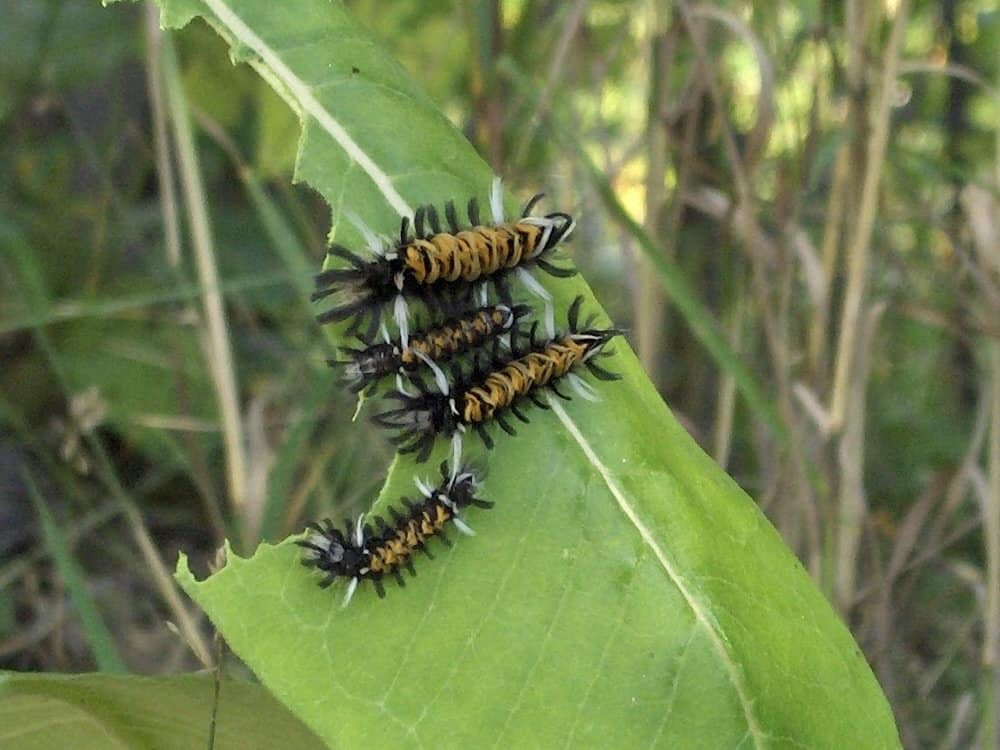
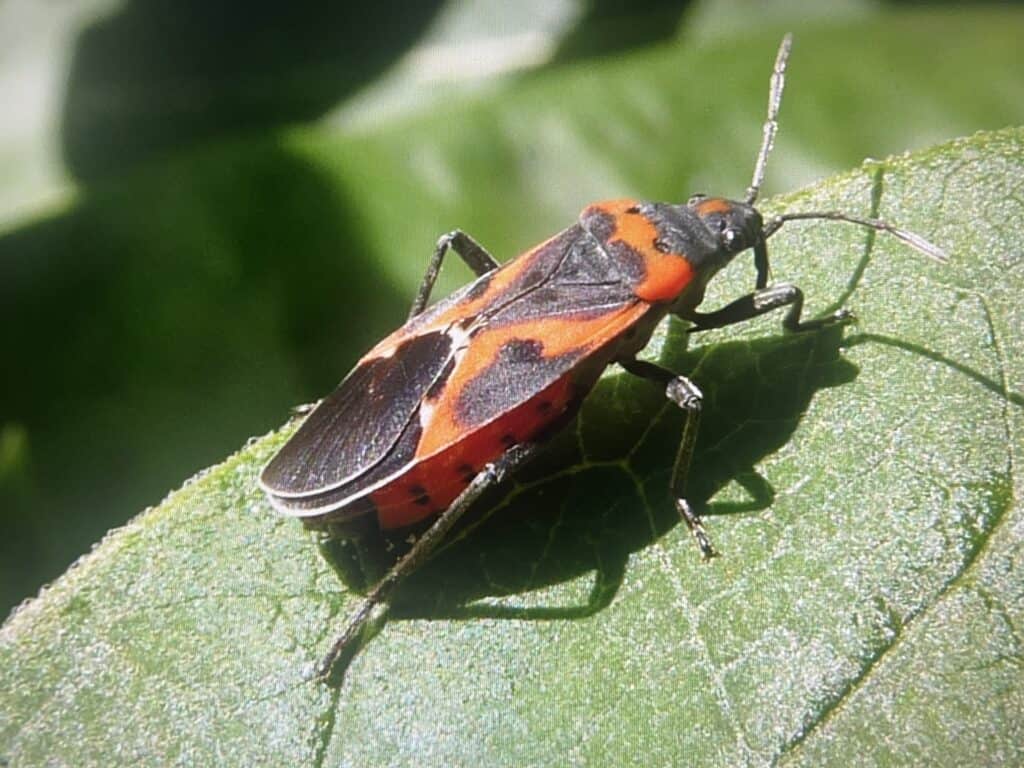
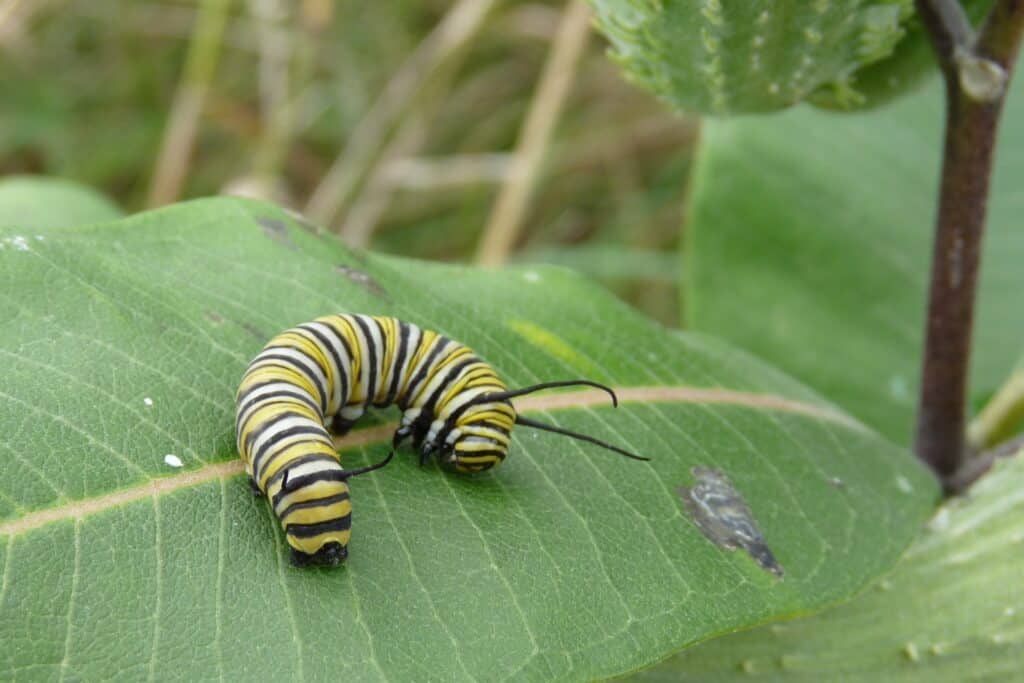
__ 26 Yellowjacket wasps are usually very conspicuous by now. In late summer, there is usually a frenetic search for food to feed the larvae in their underground nests, hence their attraction to garbage cans and family picnics.
__ 27 Goldenrods reach peak bloom at month’s end and take over as the main roadside and field flowers. Some fields appear almost totally yellow.
__ 28 Starting in late summer, listen for coyotes calling. Their “yip‑yip” calls are often heard at this time as pups, now in their adolescence, begin to try out their voices.
__ 29 Heavy morning mists, especially in valleys and over lakes, complement the beauty of the August sunrise.
__ 30 Orion, the main constellation of winter, is now visible one hour before dawn on the eastern horizon.
__ 31 The eggs of all our turtle species hatch from late August to early October. In the case of painted turtles, the young may actually stay in the nest and not emerge above ground until the following spring.
September – Mists and Melancholy Joy
“Best I love September’s yellow,
Morns of dewstrung gossamer,…
More than Spring’s bright uncontrol
Suit the Autumn of my soul.”
– Alex Smith
Few would argue that autumn’s arrival carries a stronger emotional charge than any other change of season. From the vibrant colour and smell of the fall leaves to the cooler temperatures and misty mornings, fall resonates with sentimentality. I suppose it partly stems from the nostalgia of summer’s more relaxed lifestyle being over, the return to our often hectic schedules, saying goodbye to people you might not see for another year, and witnessing nature’s preparations for winter. Fall, too, is a season of time-honoured traditions and celebrations. Be it raking leaves, closing the cottage, getting together with family for Thanksgiving or going on the deer hunt, an element of wistfulness and reminiscence never seems to be far away.
For many, September brings a surge of energy. The generally cooler temperatures seem to compel us to shake our summer lethargy and get out and do something – start a project we put off all summer, clean out the garden, stack wood, or go for a walk in the woods. As school reconvenes and myriad community activities begin again, this is the true New Year.
| 1 Fall songbird migration is at its peak. Watch and listen for warblers and vireos in city backyards, most often in the company of chickadees. The migrants are usually hidden by foliage, however, and need some “pishing” on your part to be coaxed out into the open. Some, like the Bay-breasted Warbler, appear quite different than in the spring. Others, like the redstart, look the same. Many of the birds you’ll see are immatures.
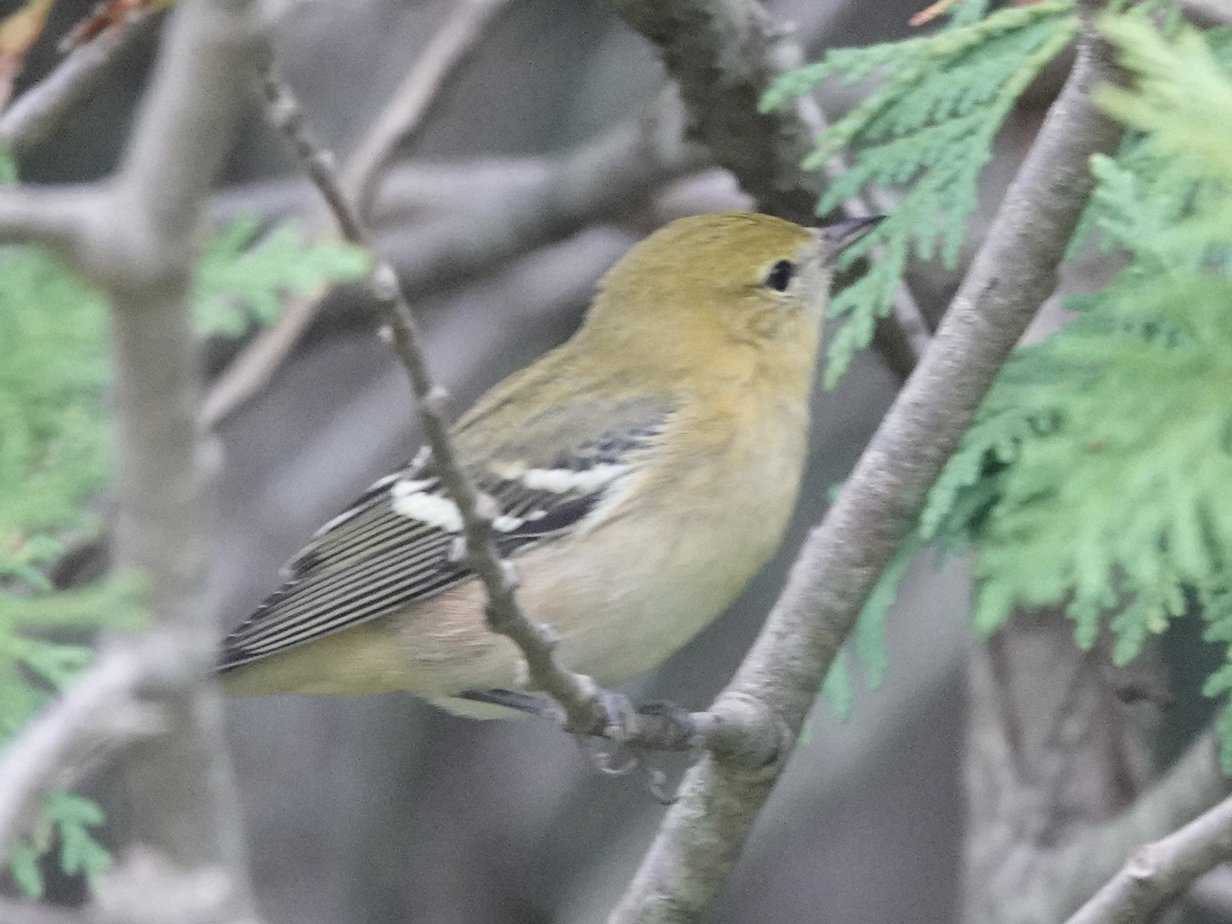
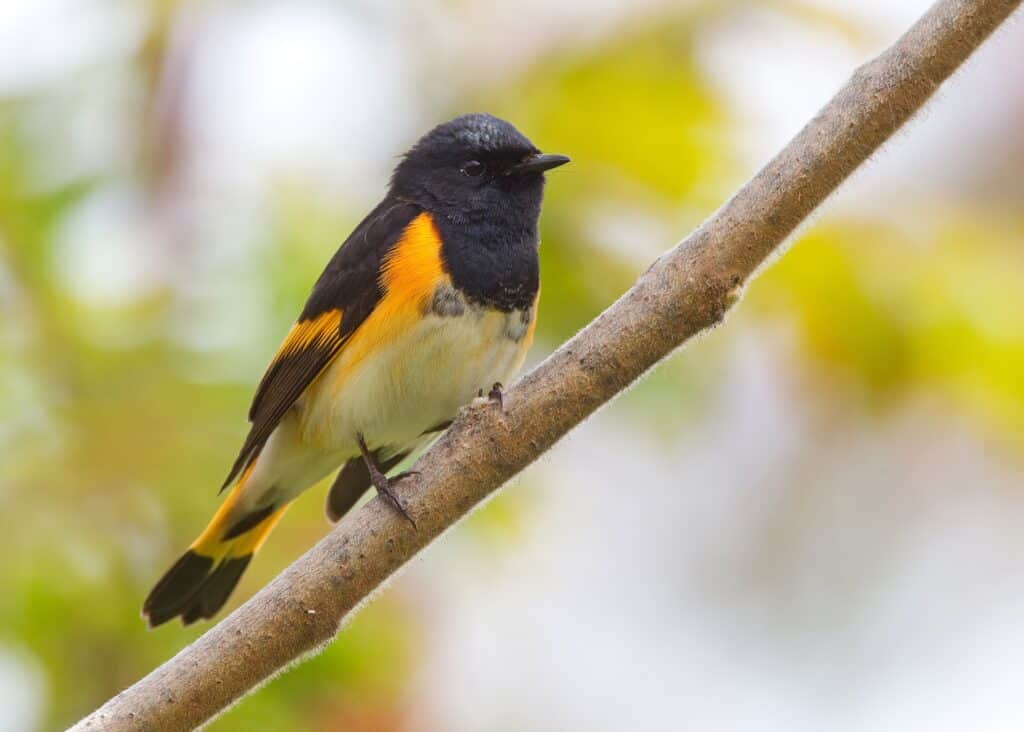
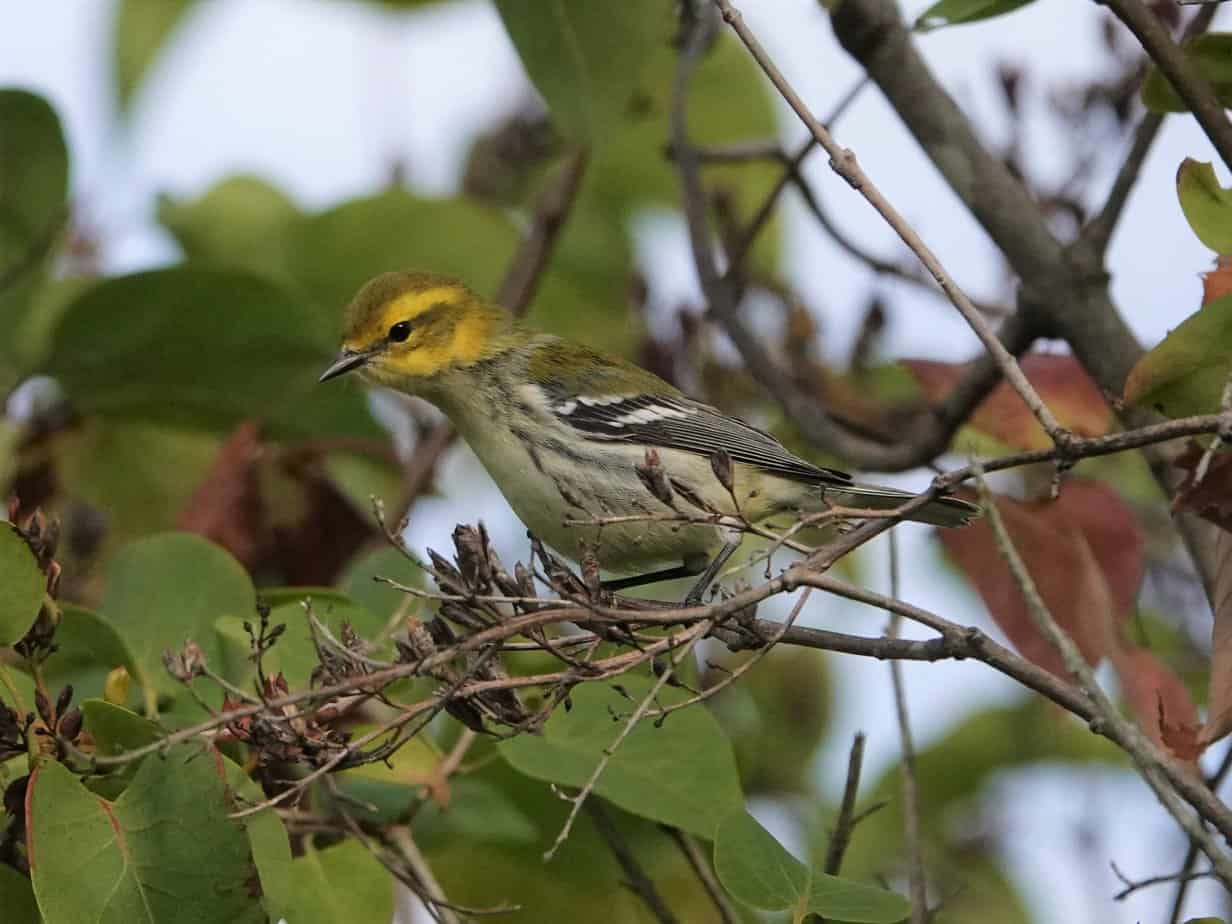
| 2 The wild fruit crop, along with all manner of berries and seeds in general, can be abundant some years. Oaks, maples, elderberries, dogwoods and mountain-ash are but a few of the species offering up an extra big serving of food to hungry birds and mammals.
| 3 Robins begin to flock up and a dozen or more can often be seen feeding together on suburban lawns. Young birds with speckled breasts are usually quite conspicuous in these gatherings.
|4 Spectacular swarms of flying ants are a common September phenomenon. Some are females – the potential future queens – but the majority are males. A given ant species will swarm and mate on the same day over huge areas, sometimes covering hundreds of kilometres. The males soon die, and the mated females disperse to try to start up a new colony.
| 5 Possibly the most typical bird sound of September is the raucous call of the blue jay. Most of Ontario’s blue jay population actually migrates to the U.S. in the winter
| 6 Canada goldenrod transforms fields into a sea of yellow. The Kawarthas boast at least 15 goldenrod species including blue-stemmed and zigzag goldenrod which grow in open woodlands.
| 7 Fringed and bottle gentians are in bloom. Other September wildflowers to watch for include false dragon-head, grass-of-Parnassus, and ladies’-tresses orchids.
| 8 Monarchs are now heading south to the mountains of Mexico where they will spend the winter. Most will go to the El Rosario Sanctuary near the town of Angangueo, west of Mexico City. The number of monarch butterflies wintering in western Mexico plummeted last winter despite a remarkable decline in illegal logging in the area where they congregate. It appears that far fewer butterflies than usual arrived in the sanctuaries. Climate change, droughts and other extreme weather, and pesticide use north of the border are all being cited as probable reasons for the decline. But, thanks to the hot, sunny weather, monarch numbers in the Kawarthas have appeared close to normal this summer.
| 9 Cool mornings with bright sun sometimes coaxes birds into tentative song, although its reproductive purpose is for another season.
| 10 Keep an eye out for the beautiful yellow and black golden garden spider. It often builds its big web of sticky spiral threads in a clump of goldenrod and hangs conspicuously right in the hub.
| 11 It’s really beginning to look and feel like fall. Daylight and darkness are now almost equal in duration. On cool mornings, heavy mists dance and curl over rivers, lakes, and valleys.
| 12 Part of the green darner dragonfly population actually migrates south in the fall, while the others overwinter in the Kawarthas in the nymph stage of the life cycle. Migratory green darners are capable of flying up to 137 km in a day, most likely to the southern U.S. It is thought that the same individuals return north in the spring.
| 13 Two vines are very much in evidence right now, especially along rail-trails and woodland edges where they sprawl over fences, shrubs and trees. They are wild cucumber, which has cucumber-like seed pods covered in soft bristles, and Virgin’s bower, identified by its distinctive, fluffy seedheads of gray, silky plumes.
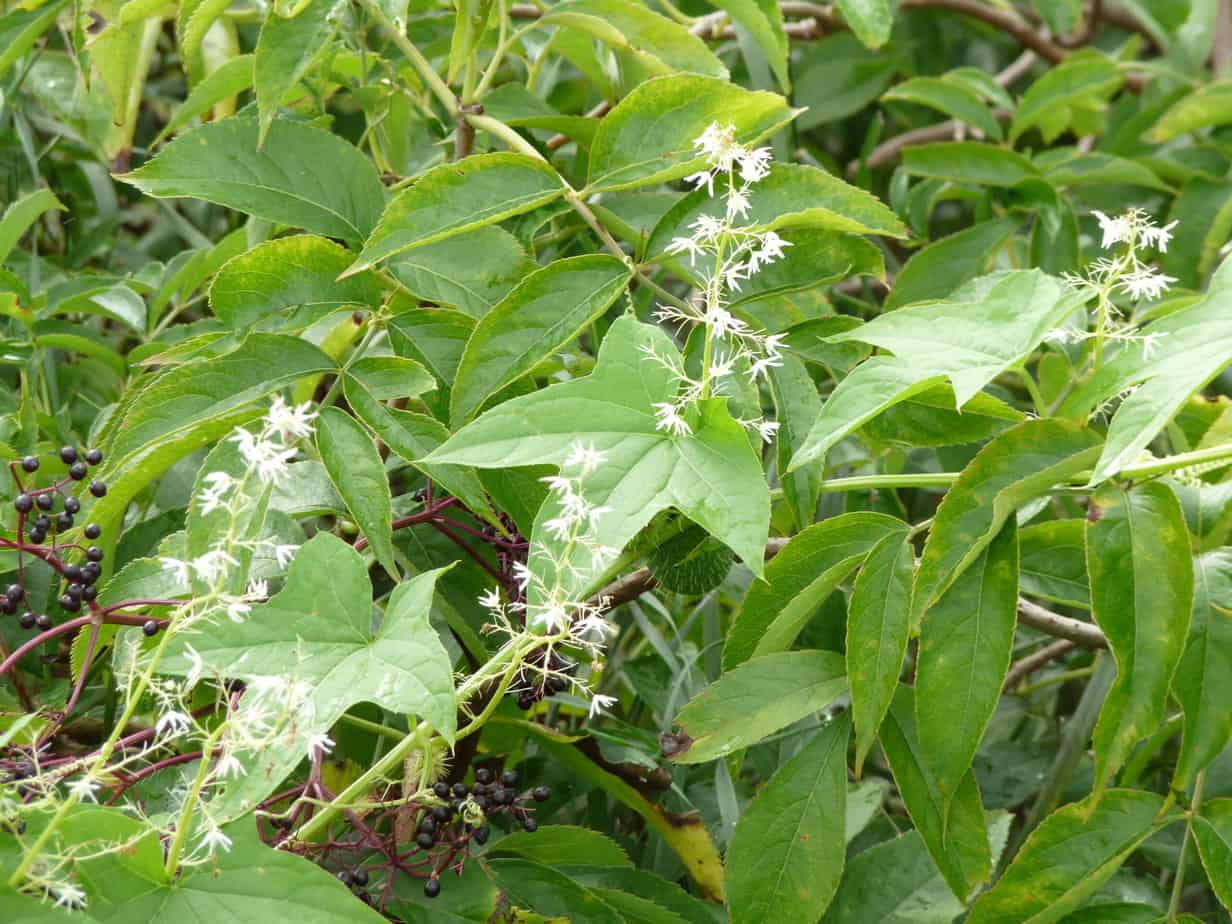
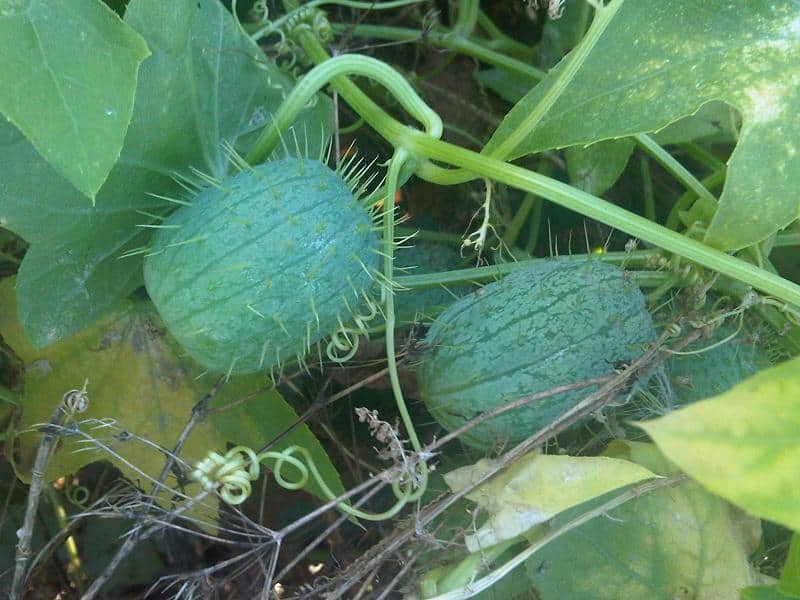
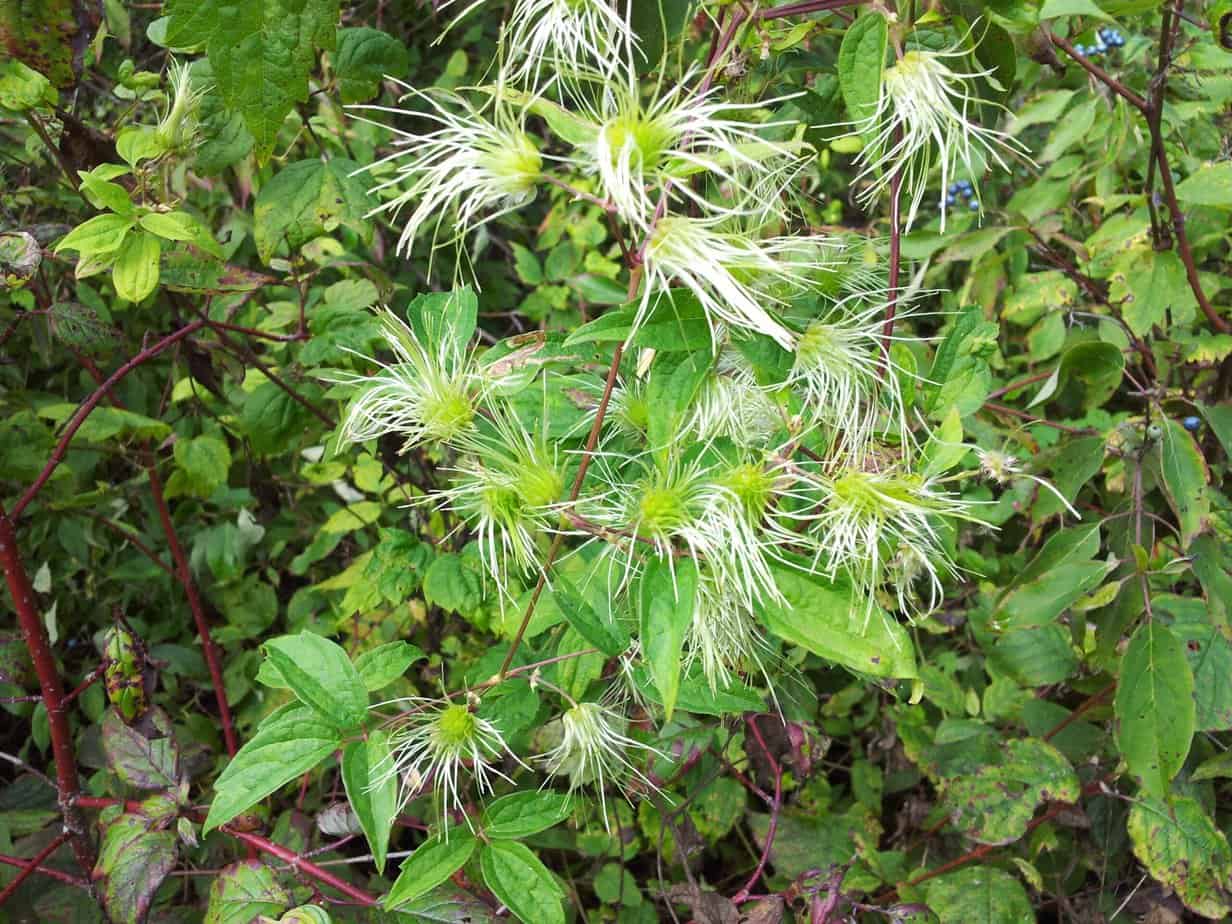
| 14 If there’s sufficient moisture, mushrooms are at their most plentiful and diverse in September. The giant puffball is sometimes found in fields and looks like an errant soccer ball or loaf of white bread. It is edible when young. If you step on an old one, brown, dust-like spores will puff out.
| 15 Ruby-throated hummingbirds abandon our feeders and surrender to the urge to migrate. Most ruby-throats winter in Mexico’s Yucatan Peninsula and in Central America. The southward flight includes a remarkable non-stop crossing of the Gulf of Mexico, taking 18-20 hours.
| 16 Virginia creeper and poison ivy turn a fiery red as well as some sumacs and an increasing number of maples.
| 17 In mid-September, the first sub-freezing temperatures are traditionally recorded along with the first frost. However, with global heating, the first frosts sometimes don’t occur now until well into October.
| 18 Brown and black woolly bear caterpillars are a common sight, especially on paths and sidewalks. People used to believe that the length of the middle brown band could foretell the severity of the coming winter. The longer the band, the shorter and milder the winter would be. In reality, the caterpillar simply becomes increasingly brown as it ages.
| 19 Be sure to put your bird feeders up if you haven’t already done so. Among other birds, white-throated sparrows are migrating through and are easy to attract if you scatter millet or finch mix seed on the ground.
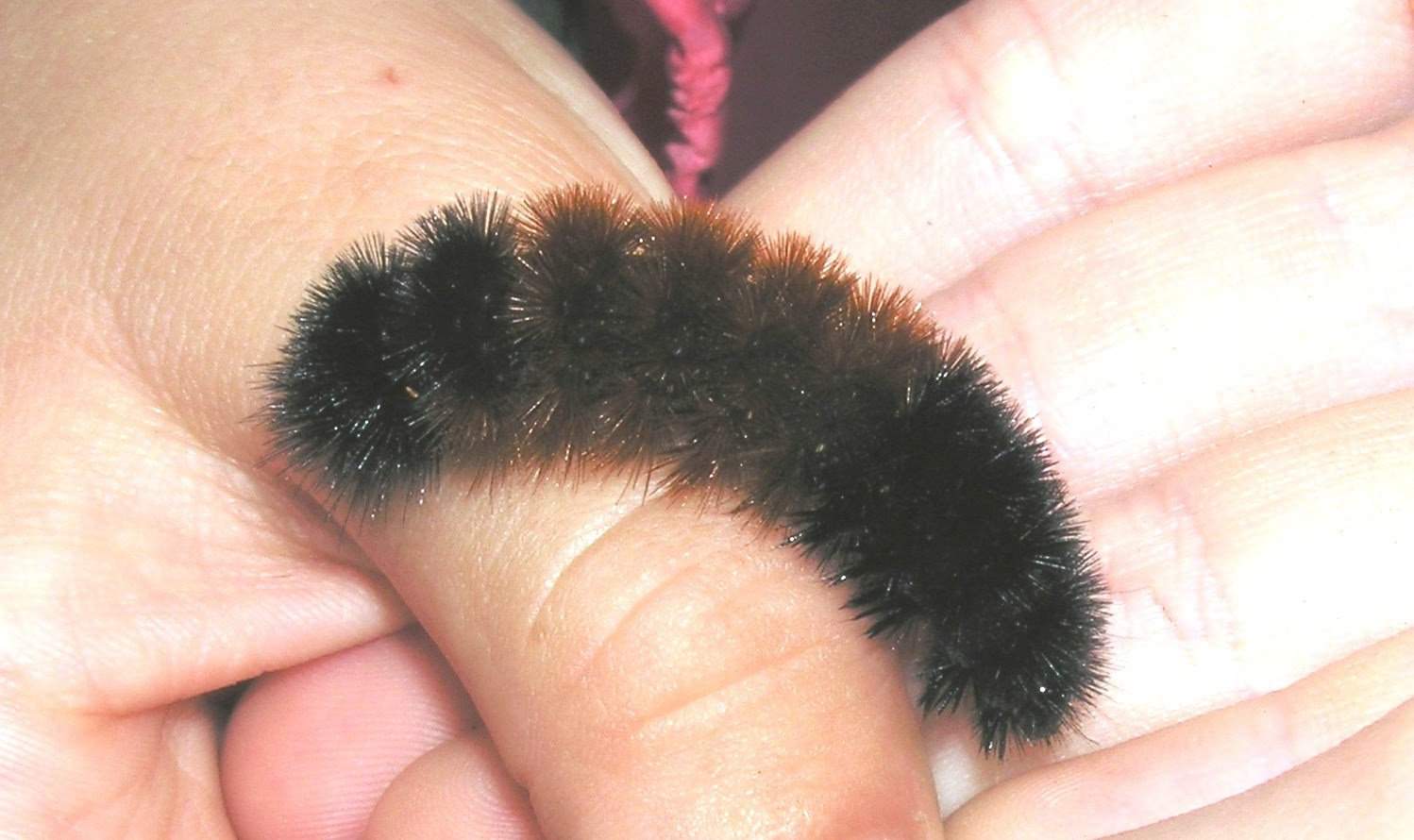
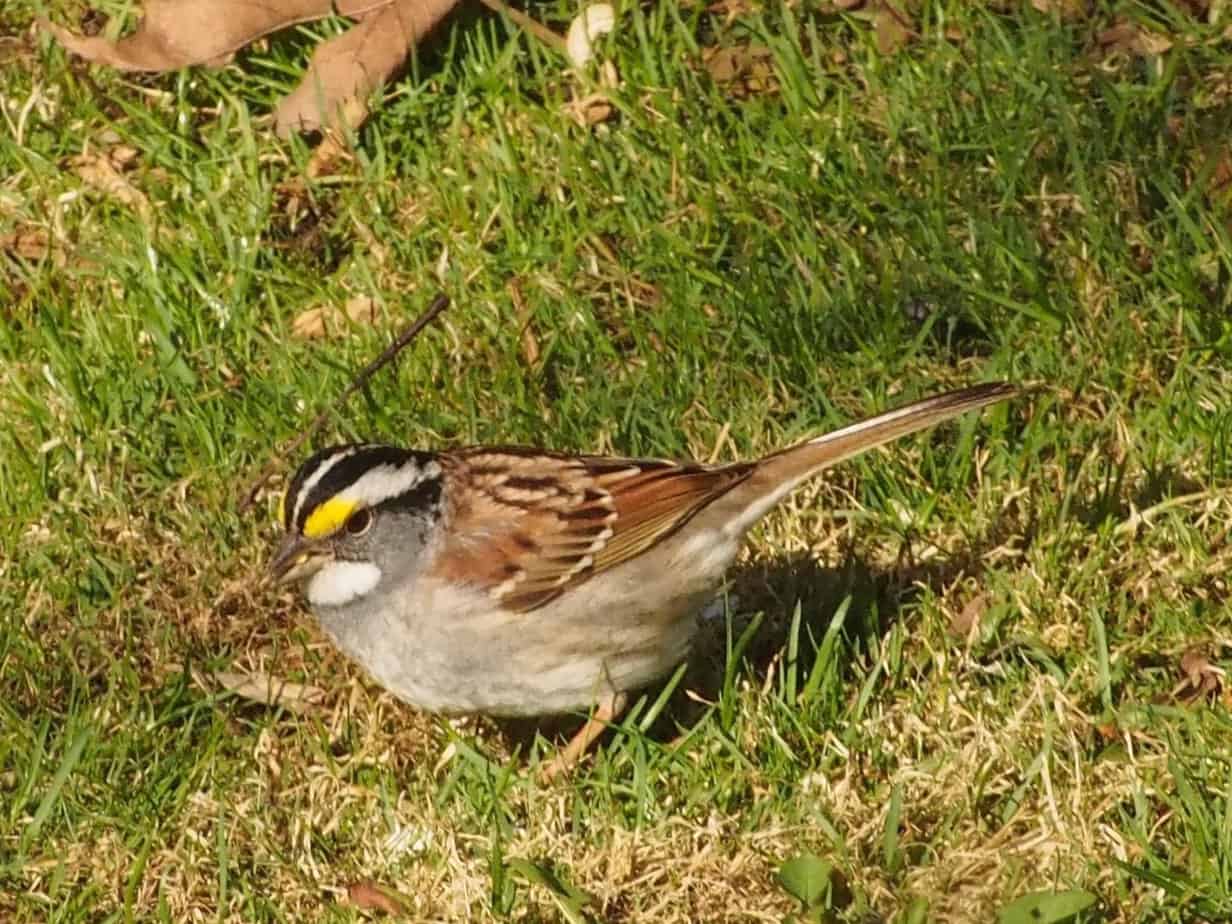
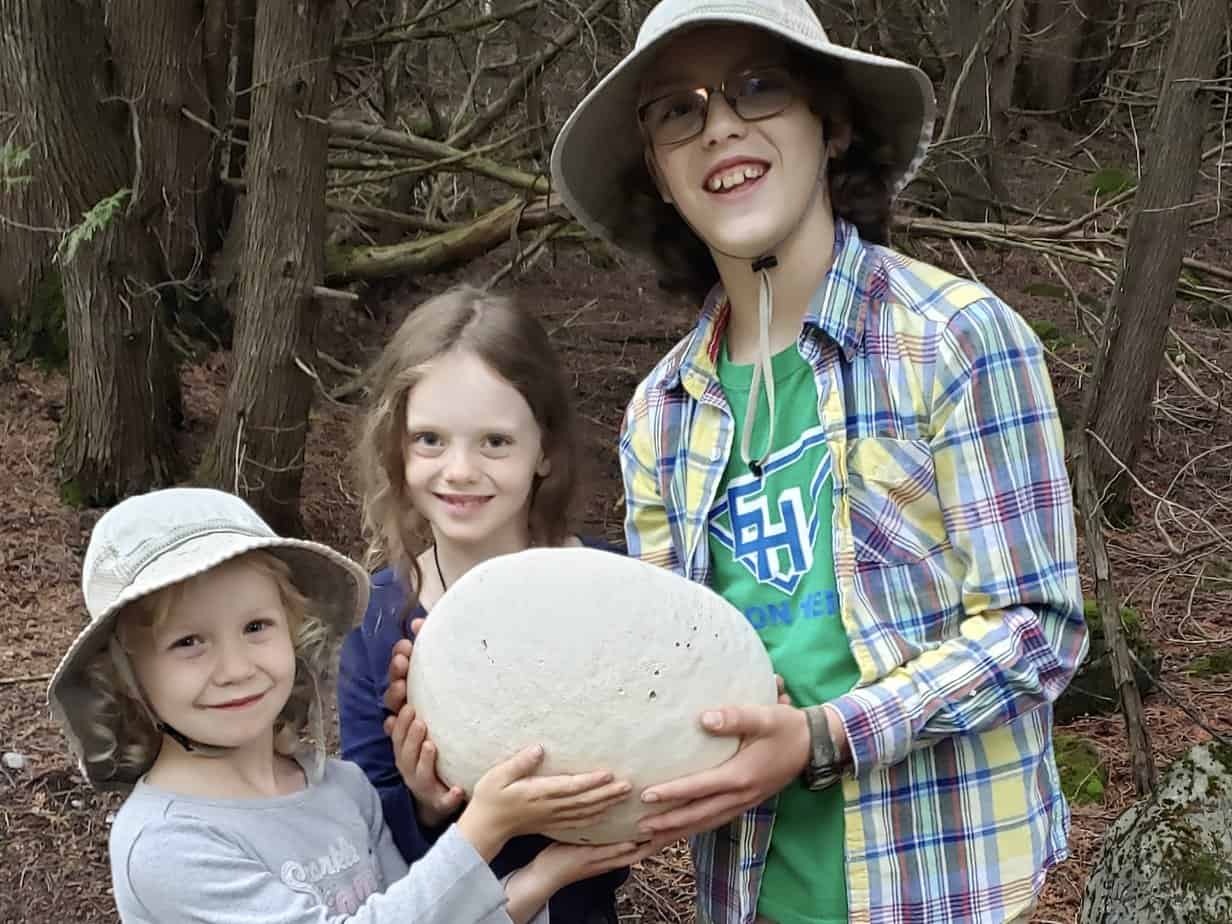
| 20 Oaks are now shedding their acorns. They are gobbled up by all manner of animals including deer, bear, squirrels and blue jays.
|21 Chinook and coho salmon, along with brown trout, leave Lake Ontario this month and spawn in the headwaters of streams and rivers like the Ganaraska. You can see them jumping up the fish ladder in Port Hope in huge numbers.
|22 Migrant warblers and vireos often join up with mixed flocks of chickadees and nuthatches in the fall and will come in remarkably close in response to “pishing.” Simply take a deep breath and softly but quickly repeat the word “pish” in one, drawn-out exhale. Keep it up for at least a minute or two.
| 23 The fall equinox takes can take place September 21, 22, 23, or 24, depending on the year. It marks the beginning of autumn. Day and night are now almost equal in length, hence the word equinox. Today, both the moon and sun rise due east and set due west. Take note of where the sun rises and sets right now as seen from an east and west window in your house and then watch as these locations move increasingly southward over the course of the fall.
| 24 The myriad grasses that bloomed in the summer are actually easiest to identify in the fall. This is because seeds, rather than flowers, are the most important features for identification.
| 25 Large migratory flights of thrushes often pass over about this time. Their loud, plaintive call notes are surprisingly easy to hear in the night sky, even over the city. Migration is usually at its best just after the passage of a cold front when northwesterly breezes provide tail winds.
| 26 The Harvest Moon, the full moon closest to the fall equinox usually occurs this month. For several evenings in a row, the moon rises at almost the same time and climbs more slowly than usual up into the sky. Watch, too, for Jupiter which will be shining brightly in the south.
|27 The purples, mauves, and whites of asters now reign supreme in fields and along roadsides. The Kawarthas have about 15 species of these late bloomers that represent the year’s last offering of wildflowers. The more common species include New England, heath and panicled asters.
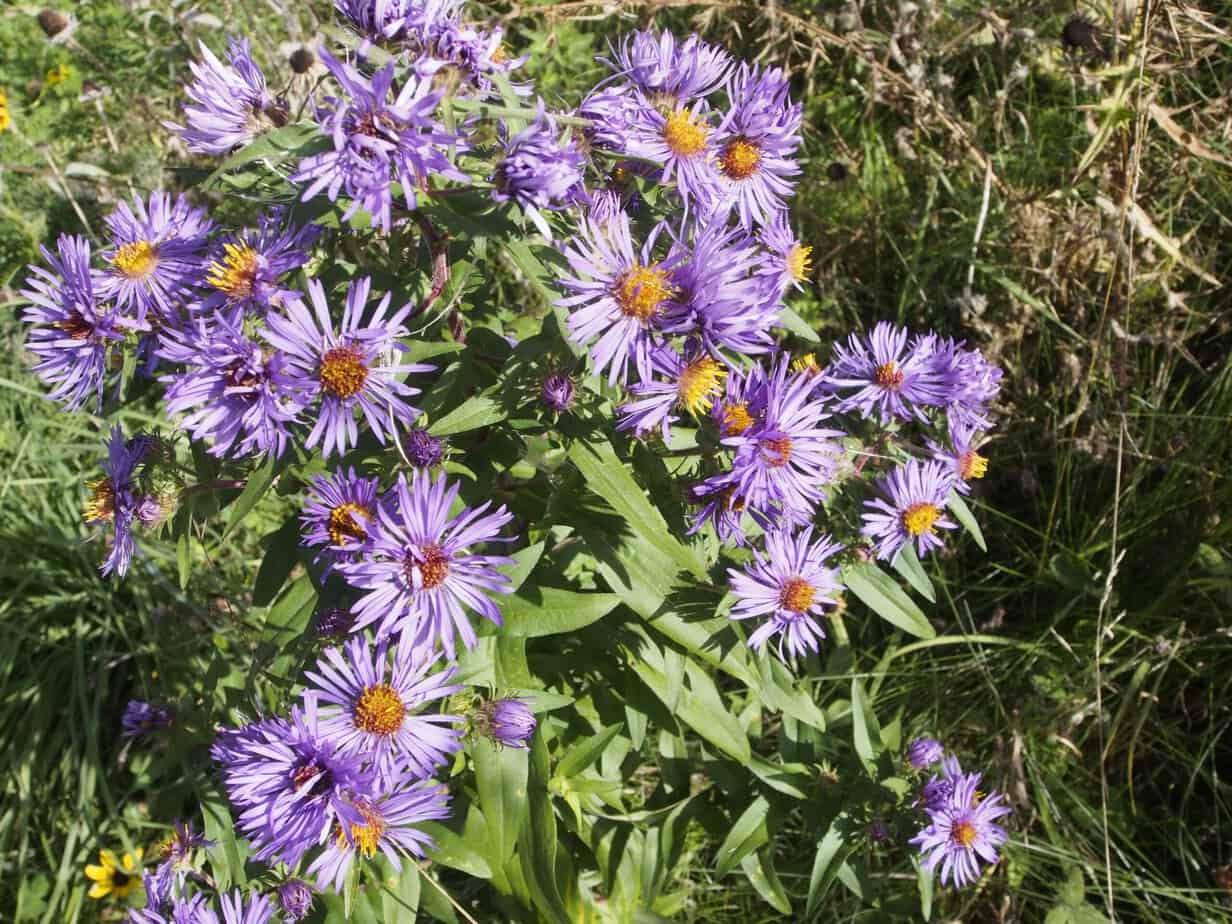
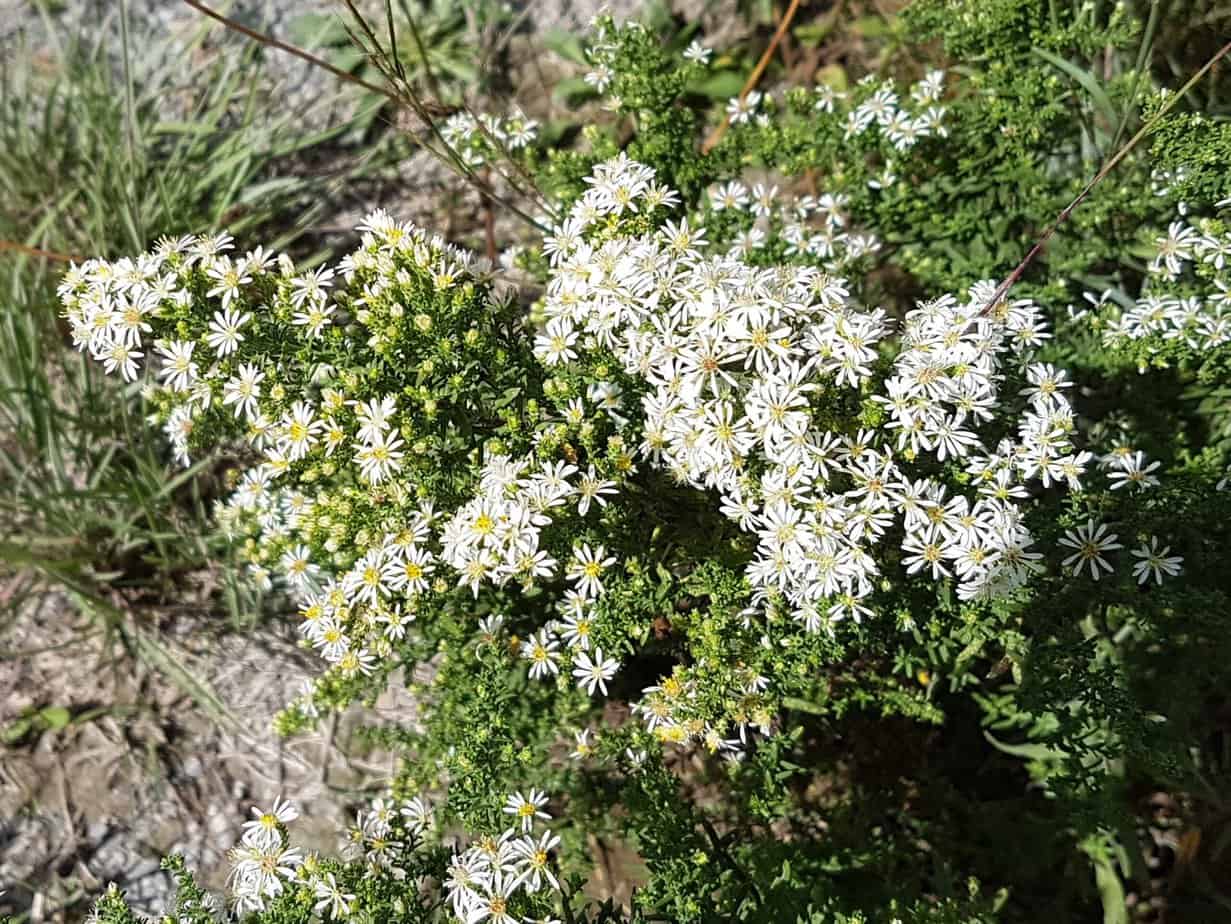
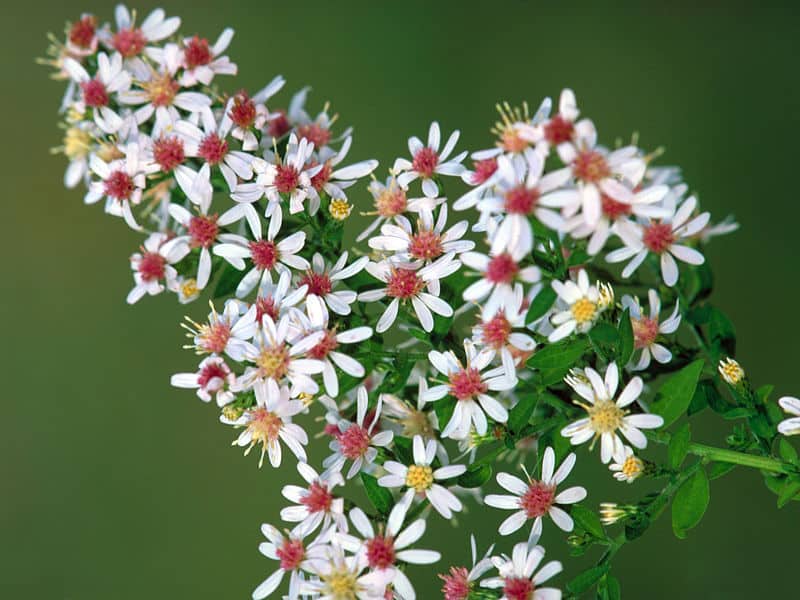
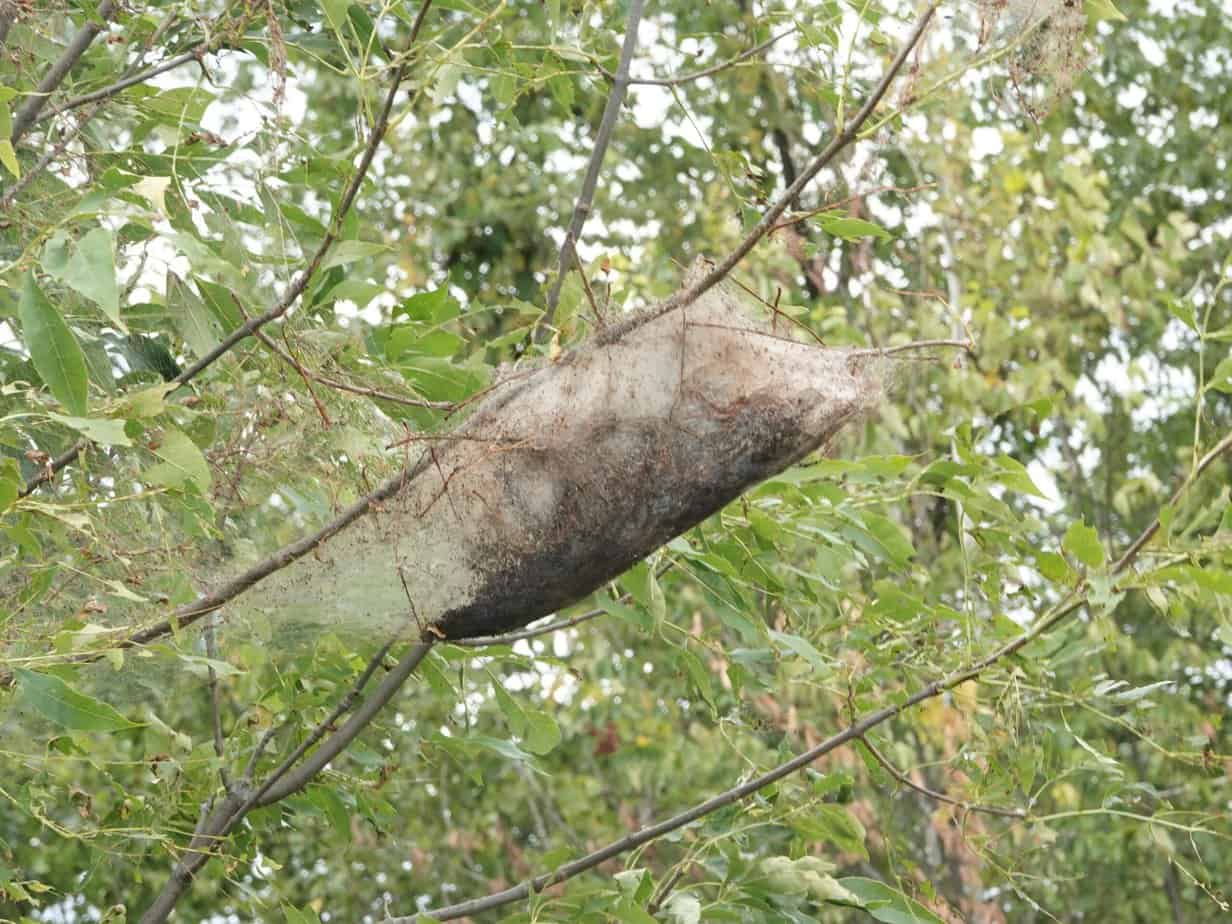
| 28 The webs of the fall webworm stand out noticeably. The large, loose structures encase the ends of branches of broad-leaved trees and shrubs and house colonies of small, beige caterpillars covered with long hairs.
| 29 Most years, white ash, pin cherry, and staghorn sumac reach their colour peak about now. Some ash trees turn a stunning purple-bronze that literally glows in the September sun.
| 30 Ospreys begin to leave the Kawarthas for their wintering grounds in the West Indies and Central and South America. Mangroves, rainforests and coastal estuaries will be their home until next spring.
October – The Time of Falling Leaves
“Just before the death of flowers,.
And before they are buried in snow,
There comes a festival season
When nature is all aglow.”
– Author unknown
In early October, the sun still shines with warm benevolence. Yet, it is not the light of summer. Often hazy and surreal, October sunshine has a quality all its own. As crickets sing softly from meadows of aster, winter seems far away. But, as experience has taught us, the beauty of early October is both temporary and fragile. So, we try to hang on to these magnificent days before wind and rain scatter leaves and colder weather descends upon us. Perhaps it is the ephemeral nature of October’s loveliness that makes it so special.
October mornings greet us with the first heavy frosts of the season. As the sun warms the cold night air, leaves shower down from trees, and vistas that were hidden all summer long once again become visible. This is the month of the rake; but there is a payoff for our labour. The familiar, spicy smell of the fallen leaves transports us back to childhood, evoking an instant flood of memories of autumns past .
As the month draws to a close, the only leaf colour that remains is the yellow of poplars and tamaracks and the browns, oranges and burgundy of oaks. Corn fields and cattail marshes become a sea of drab yellow, and fallen leaves quickly turn an ubiquitous brown. With cold, damp weather and markedly shorter days, it’s not hard to imagine why the Celts chose this time of year to celebrate the various traditions that have become our Halloween.
__ 1 Northern Canada geese continue to stream southward in large, high‑altitude flocks.
__ 2 Large, grey, Western conifer seed bugs (sometimes called leaf‑footed or squash bugs) seek overwintering sites in homes this month. They can measure up to 2 cm in length and look rather imposing. This insect cannot breed indoors, however.
__ 3 Sulphur and cabbage butterflies are active throughout October. The occasional monarch, too, can usually be seen until late in the month.
__ 4 White, mauve and purple asters are the dominant wildflowers this month, bringing the roadside floral parade to a close. Watch for heath, panicled, and calico asters in particular.
__ 5 This is sparrow month at feeders. Watch for white‑throated and white‑crowned sparrows, along with dark‑eyed juncoes. If you are lucky, a thrush‑like fox sparrow may even put in an appearance. Be sure to scatter seed on the ground.
__ 6 The full moon of October is known as the Hunter’s Moon. In early fall, the moon rises only about 30 minutes later each evening and stays low in the sky. Fields and forests are bathed in moonlight allowing hunters of days past to pursue game late into the evening.
__ 7 Golden‑crowned and ruby‑crowned kinglets, along with yellow‑rumped warblers, pass through in large numbers. They can be heard calling as they search for food.
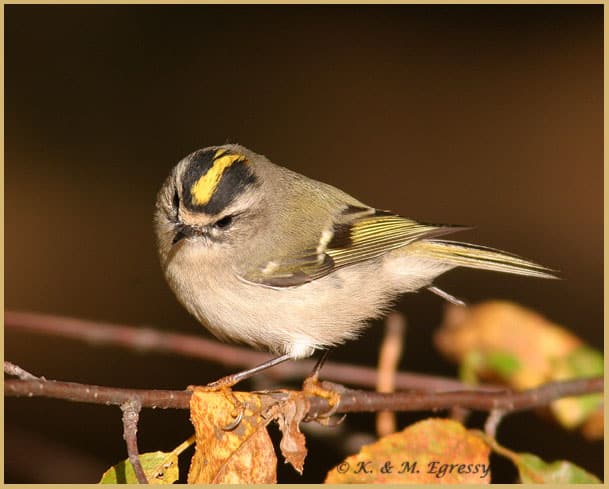

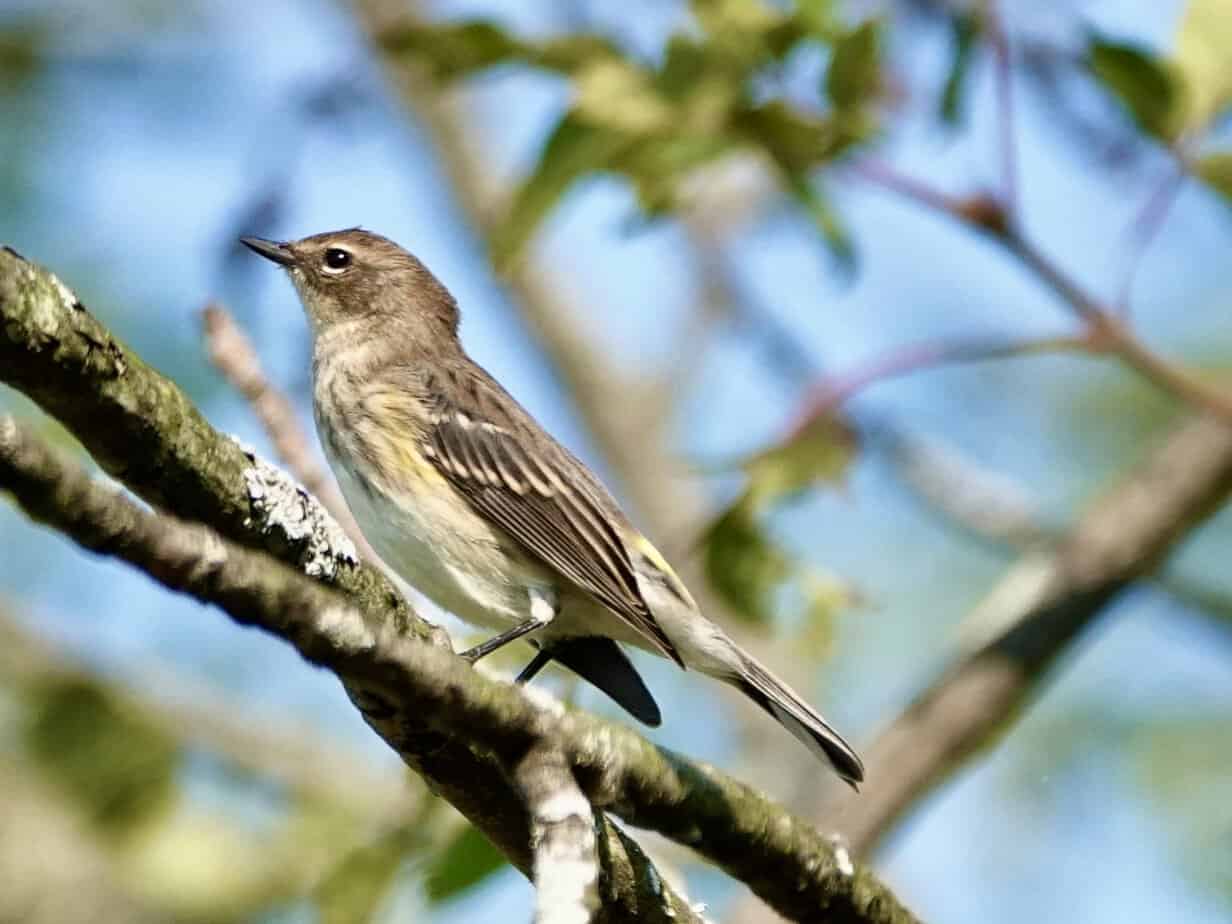
__ 8 Frogs and toads are often found sitting motionless on warm road pavement on wet, mild fall nights.
__ 9 Fall colours are at their height. Quite often, the peak coincides with the Thanksgiving weekend. Sugar and red maples steal the show.
__ 10 The Orion constellation towers over the southern sky as we head off to work in the early morning darkness. Like falling leaves, it is a sign that winter is fast approaching.
__ 11 On warm, sunny October days, the light often has a hazy, almost dream‑like quality. This is due to large amounts of water vapour in the air in fall and the fact that the fall sun is lower in the sky. The two factors combine to create a feeling of reverie.
__ 12 Through late summer and fall, bird species that are usually found in more southern regions often drift northward into the Kawarthas. The most common of these is the great egret.
__ 13 Watch for white‑tailed deer feeding along the edges of fields and woodlots at dawn and dusk.
__ 14 Trees are quickly shedding their leaves now, each species following its own timetable. Ash are often the first species to become leafless.
__ 15 Starling‑sized northern saw‑whet owls migrate southward through the Kawarthas.
__ 16 Bright yellow aspens and brown, red and burgundy oaks take over the fall foliage spectacle.
__ 17 Star-nosed moles are very active in the fall. They tunnel just below the surface of the ground in search of earthworms. In the process, large quantities of soil are pushed up from below into mounds.
__ 18 Muskellunge continue to feed heavily. This can make for great fishing.
__ 19 The sporadic calling of spring peepers can still be heard on warm days.
__ 20 Migrating diving ducks congregate on the larger Kawartha Lakes such as Pigeon Lake. Watch for large rafts of goldeneye and scaup along with mergansers.
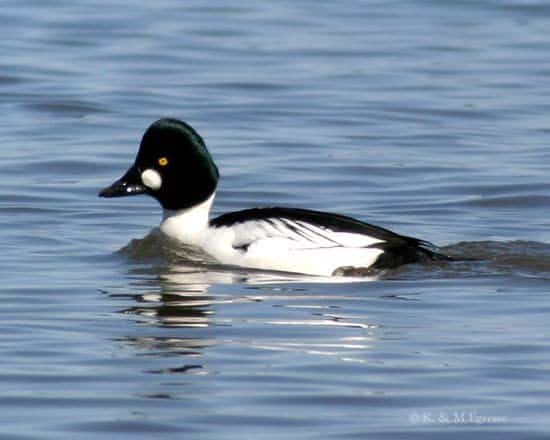
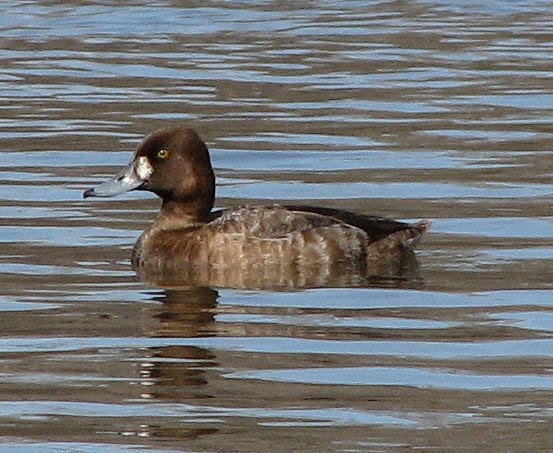
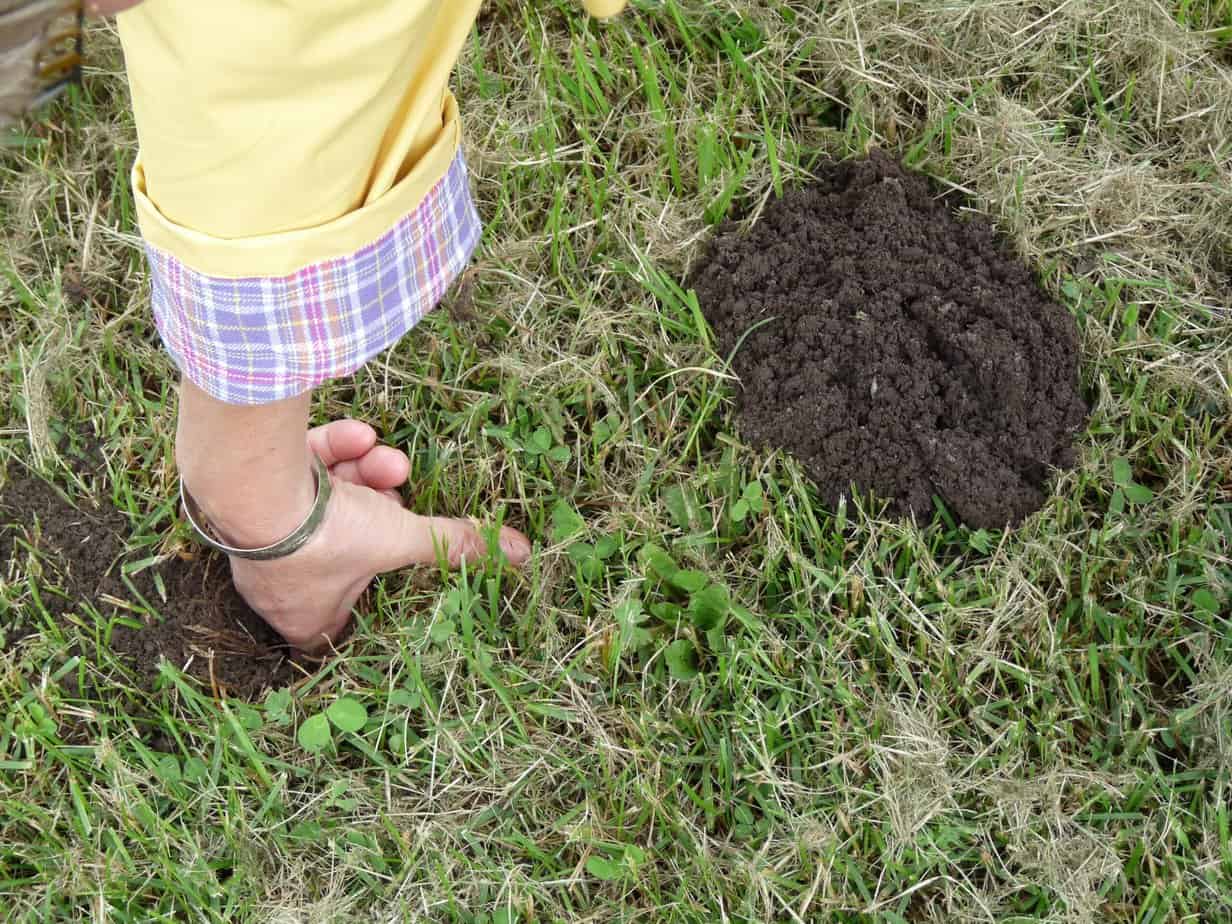
__ 21 Mating clouds of midges are still common, even on days when the temperature is close to freezing.
__ 22 Because they are still mostly green and fully‑leaved, the extent of non‑native trees and shrubs becomes evident. Norway maple, lilac and European buckthorn stand out in particular.
__ 23 Deer mice seek out winter accommodation. Human habitations are often chosen.
__ 24 Eastern garter snakes are still active and can be seen basking in the mid‑fall sun. They are the last of the snakes to retreat to winter quarters.
__ 25 The “fall turn‑over” begins to re‑oxygenate lakes this month and will continue until freeze‑up. It occurs when the surface water cools and mixes with the uniformly‑cold deeper waters below. At times, the mixing even brings dead weeds to the surface.
__ 26 Chipmunks retreat to their secure, well‑provisioned dens. Unlike groundhogs, chipmunks are unable to store large amounts of body fat and must therefore eat throughout the winter.
__ 27 The first winter finches usually show up about now. Depending on the year, these may include pine siskins, common redpolls and pine grosbeaks. Golden eagles migrate south through the Kawarthas from late October through early December.
__ 28 Brightly‑coloured brook trout spawn at gravel‑bottomed sites in stream headwaters and along lake shores. They choose areas where spring water wells up through the gravel.
__ 29 Daylight Savings Time ends on the last Sunday of October. Set your clocks back an hour. Total darkness is upon us now by 5:30 p.m.
__ 30 The smoky, golden‑yellow of tamaracks lights up wetland borders like so many candles. They represent the final act in the annual fall colour extravaganza.
__ 31 Right on cue for Halloween, late October is often when people come across bats in older schools, churches and homes. These are usually big brown bats looking for wintering sites or animals that have been disturbed during their dormancy. Little Brown Bats overwinter in caves and old mines. Their numbers have plummeted as a result of White Nose Syndrome.
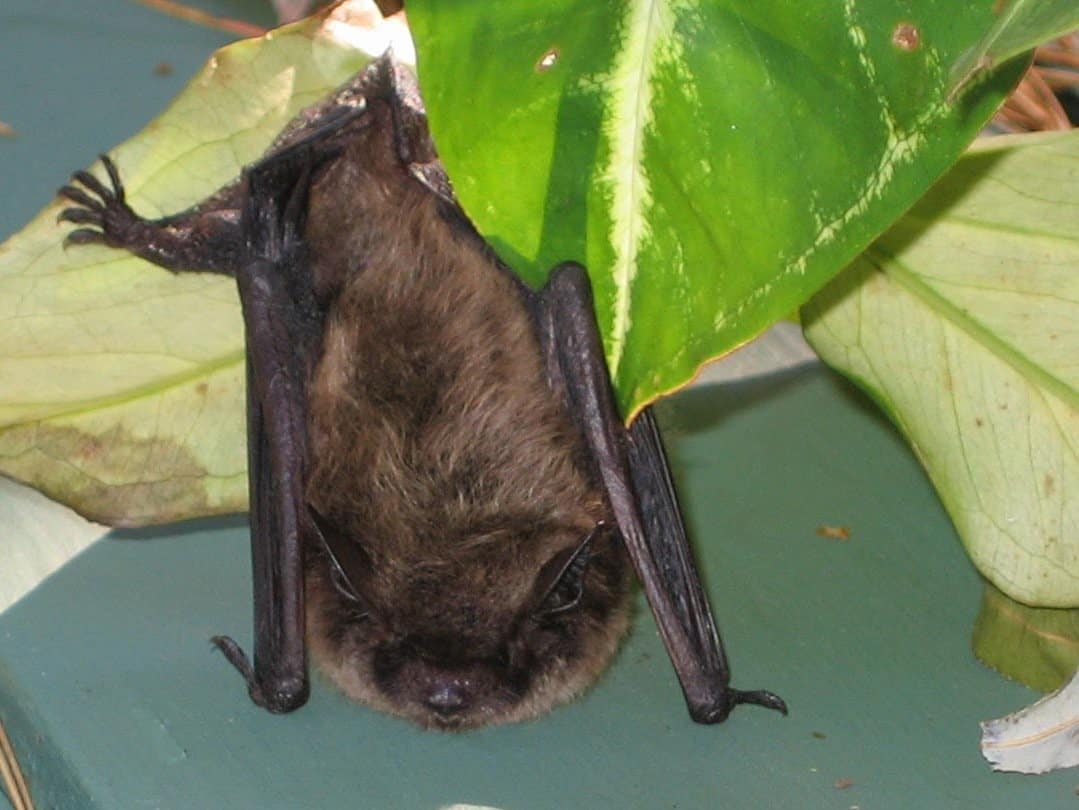
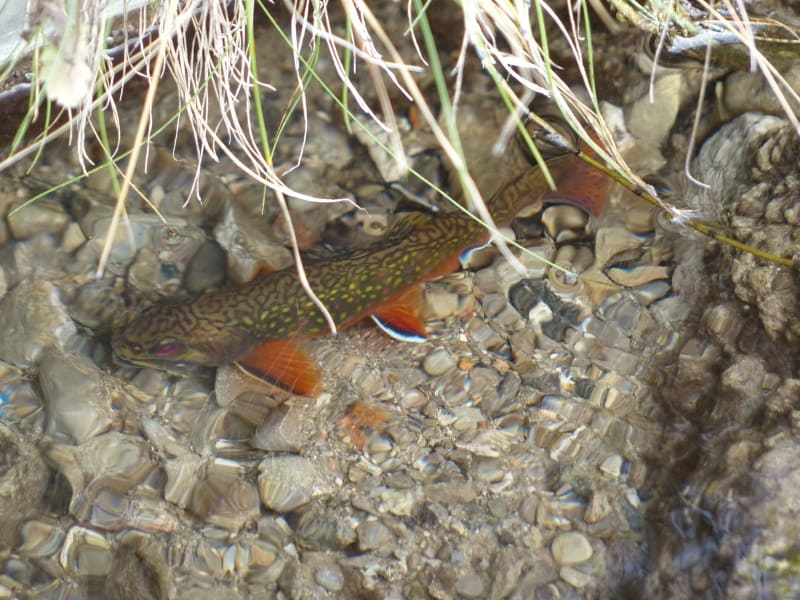
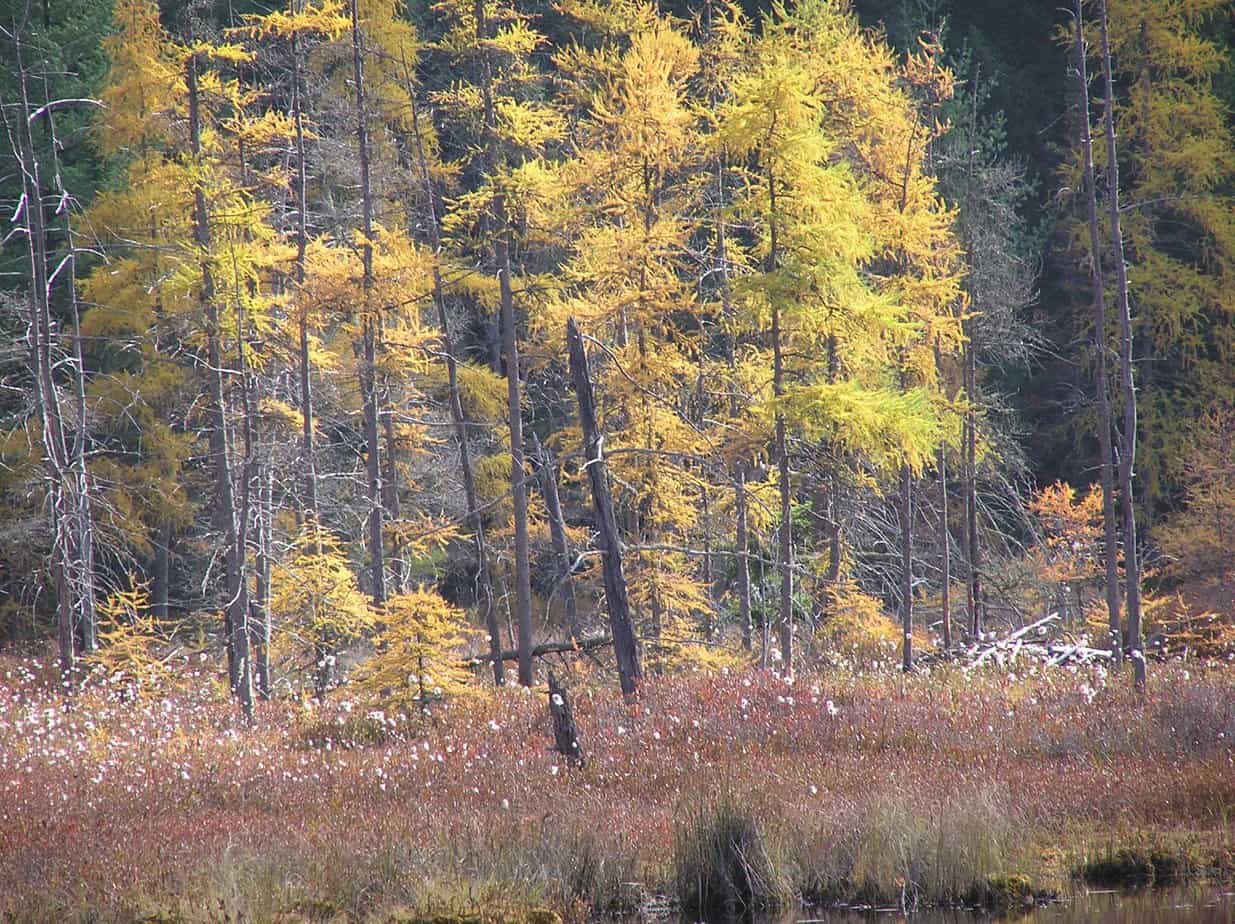
November – A Hush upon the Land
“It is a joy to walk in the bare woods.
The moonlight is not broken by the heavy leaves.
The leaves are down, and touching the soaked earth,
Giving off the odours that partridges love.”
– Robert Bly, Solitude Late at Night in the Wood
As we enter November, a pre‑winter stillness is settling upon the natural world. The calls of migrating sparrows and kinglets cease, most robins bid us farewell and the last crickets surrender to the cold. Damp, often cloudy weather, leafless trees and faded grasses and flowers create a world of greys and browns, punctuated only by the dark green of conifers. Yet some years late fall’s typical bleakness is pushed aside by a lingering Indian Summer that gently eases us into winter.
Like the first red‑winged blackbirds in March, the arrival of the birds of winter marks the approaching change of season. In addition to shrikes and tree sparrows, bald eagles will return in the coming weeks to spend the winter in the Kawarthas. They are joined most years by several species of northern finches. At the same time, however, loons are departing for the Atlantic seaboard and taking with them the last vestiges of summer. For lakeside residents, it is a melancholy event.
A walk on a November day seems uneventful, with seemingly little of interest to catch our attention. Still, the relative scarcity of plants and animals allows us to focus on the commonplace ‑ the leafless trees reduced to their elemental form, the intricacy and diversity of the mosses and evergreen ferns, and the beauty of a milkweed pod spilling its last seeds. But, other than the occasional call of a chickadee or woodpecker and the steady rustling of squirrels and mice foraging for seeds, the woods are nearly devoid of animal sounds. With colder weather, nature’s kaleidoscope of smells is also reduced to a minimum. Apart from the scent of decaying leaves or the smoke of a wood stove, there is little to stir our sense of smell. Yet the cold of late fall brings renewed appreciation for the warmth and comfort of our homes and growing anticipation – among those of us who enjoy winter at least – for the new season just around the corner.
__1. Most of our loons and robins head south. However, a small number of robins regularly overwinters in Peterborough, especially in years like this when wild fruit is plentiful.
__2. A few hardy field crickets may still be heard on warm days.
__3. Oaks, tamaracks and silver maples are about the only mature deciduous trees that are native to the Kawarthas that may still retain their foliage in early November. A particularly attractive stand of red oak can be seen at the south entrance to the village of Bridgenorth.
__4. Non‑native trees such as weeping willows and Chinese elms are often still green and stand out like sore thumbs against the late fall landscape. Unfortunately, they take away from our “sense of place.”
__5. Bird feeder activity tends to slow down as migrant sparrows have now left. With any luck, however, northern finches such as pine siskins and common redpolls will fill some of the void.
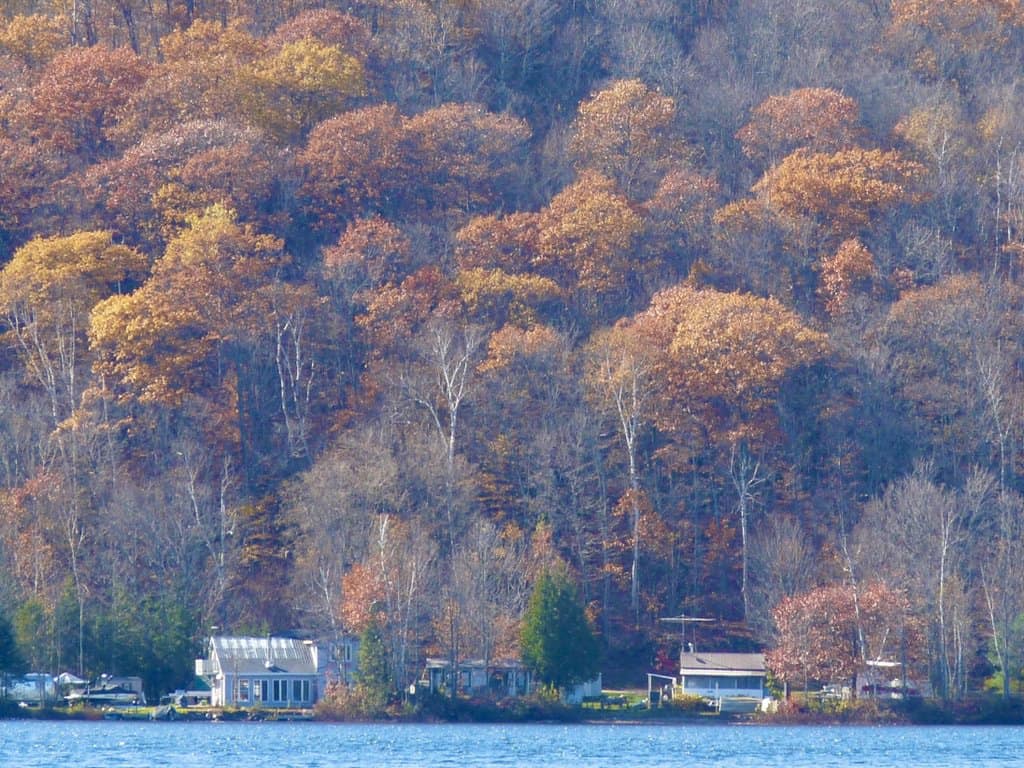

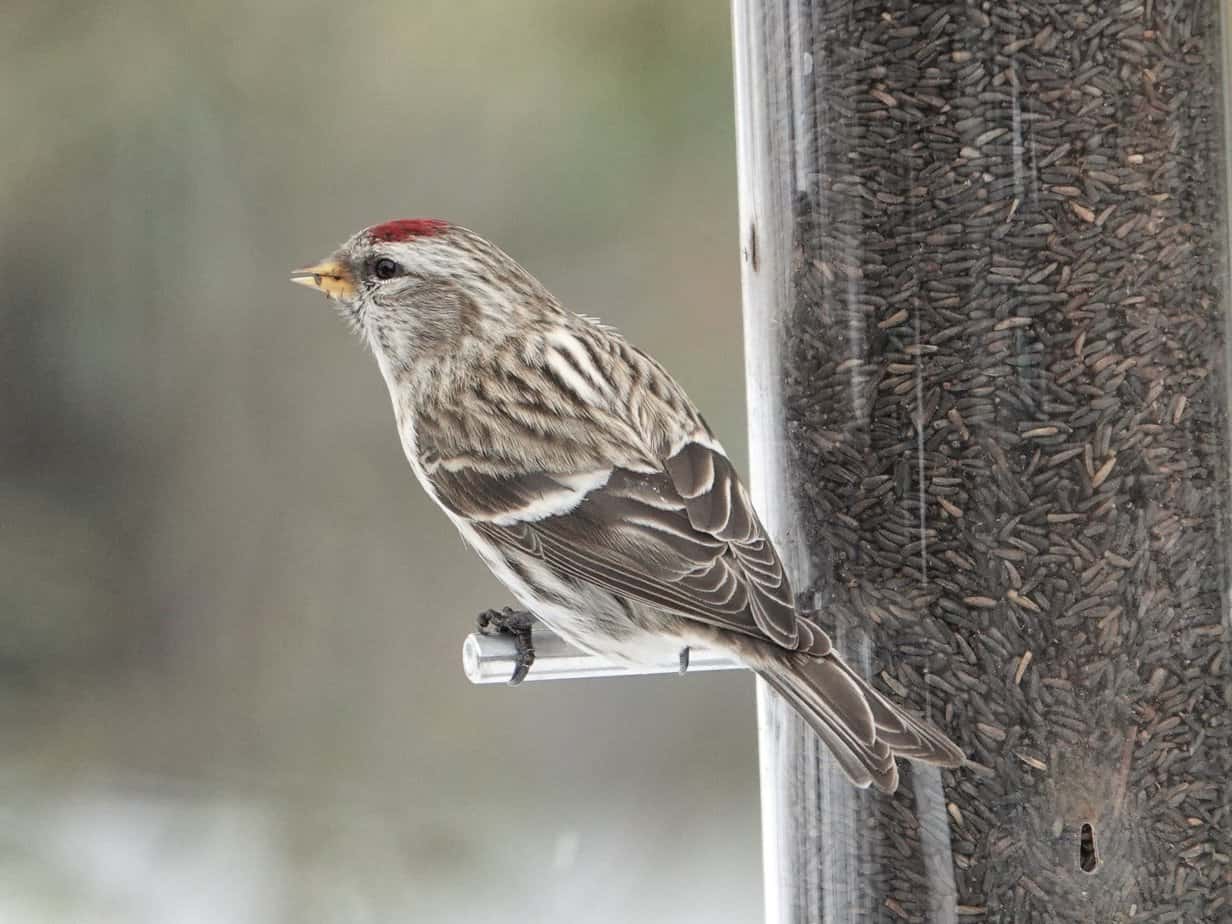
__6. With the arrival of the breeding season, white‑tail bucks are now in rut. Today also marks the beginning of the annual deer harvest by rifle and shotgun. Car accidents involving deer are very common this month. Be careful, especially at night.
__7. The last dragonflies of the year may still be active. The most common species to watch for is the yellow‑legged meadowhawk. This is a small red or yellow dragonfly.
__8. The seeds and fruits of a wide variety of trees, shrubs and vines attract birds and provide some rare November colour. The red berries of winterberry holly, a shrub of wetland borders, are especially attractive.
__9. It is not uncommon to see mourning cloak and Compton tortoiseshell butterflies on warm November days. Both of these species overwinter as adults.
__10. Watch for migrating ducks such as goldeneyes and buffleheads along the Otonabee River near Lakefield and on Lake Katchewanooka near the bridge at Young’s Point. All three scoters, along with long-tailed ducks and red-necked grebes turn up off of Sandy Point on Pigeon Lake every year. Hundreds of scaup, common mergansers, hooded mergansers and bufflehead, along with dozens of redheads, common goldeneye and red-breasted mergansers also gather on Rice Lake, especially off of Pengelly Landing. Also, a large selection of diving ducks can almost always be found in the Lakefield Sewage Lagoons, located on the south side of County Road 33, just south of the village.
__11. Frogs opt for one of two options to get through winter. Some, like the green frog, settle into the mud at the bottom of ponds and wetlands. Others, like the gray treefrog and the spring peeper, spend the winter as frozen “frogsicles” in the leaf litter of the forest floor. Glycerol, acting as an antifreeze, inhibits freezing within the frogs’ cells.
__12. Toads, as well as salamanders and snakes, retreat to below the frost line as their overwintering strategy.
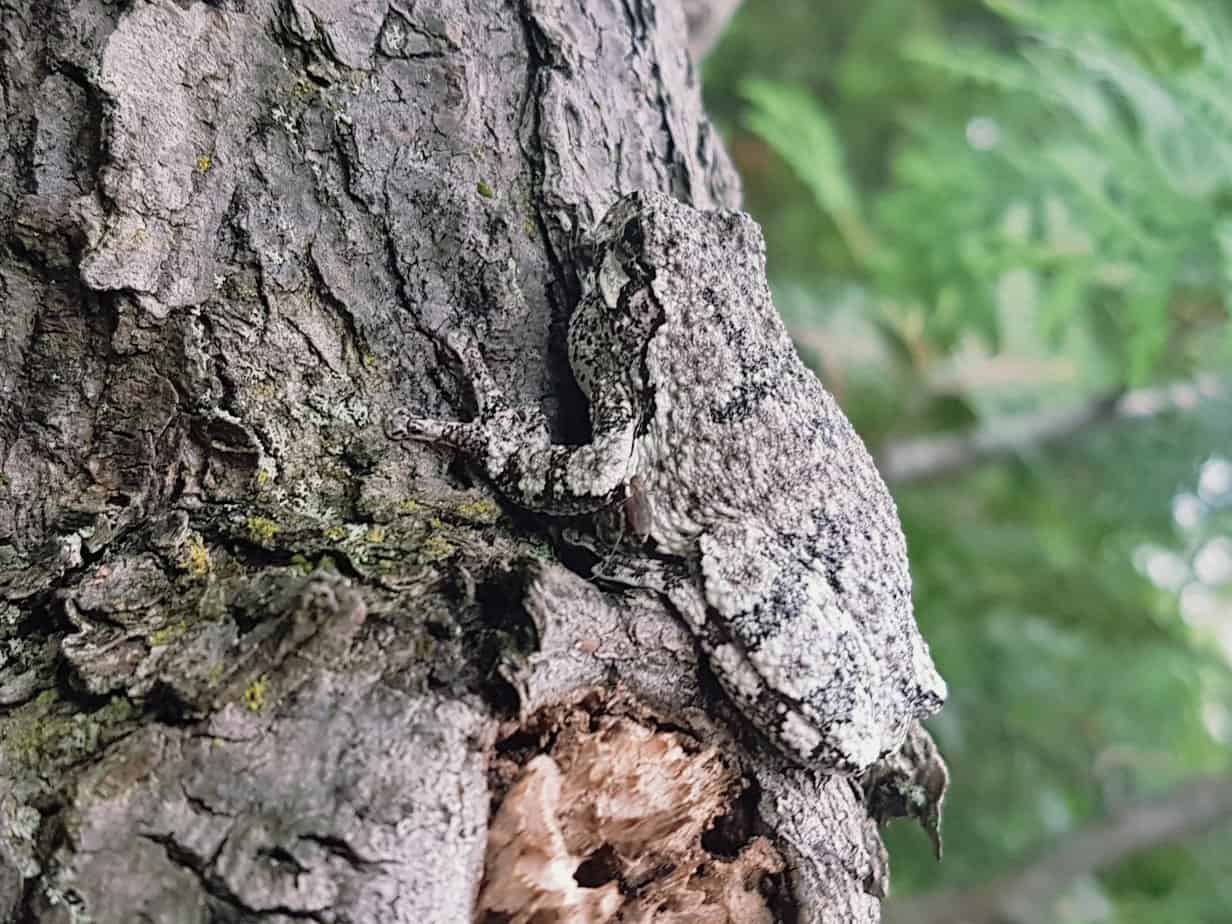
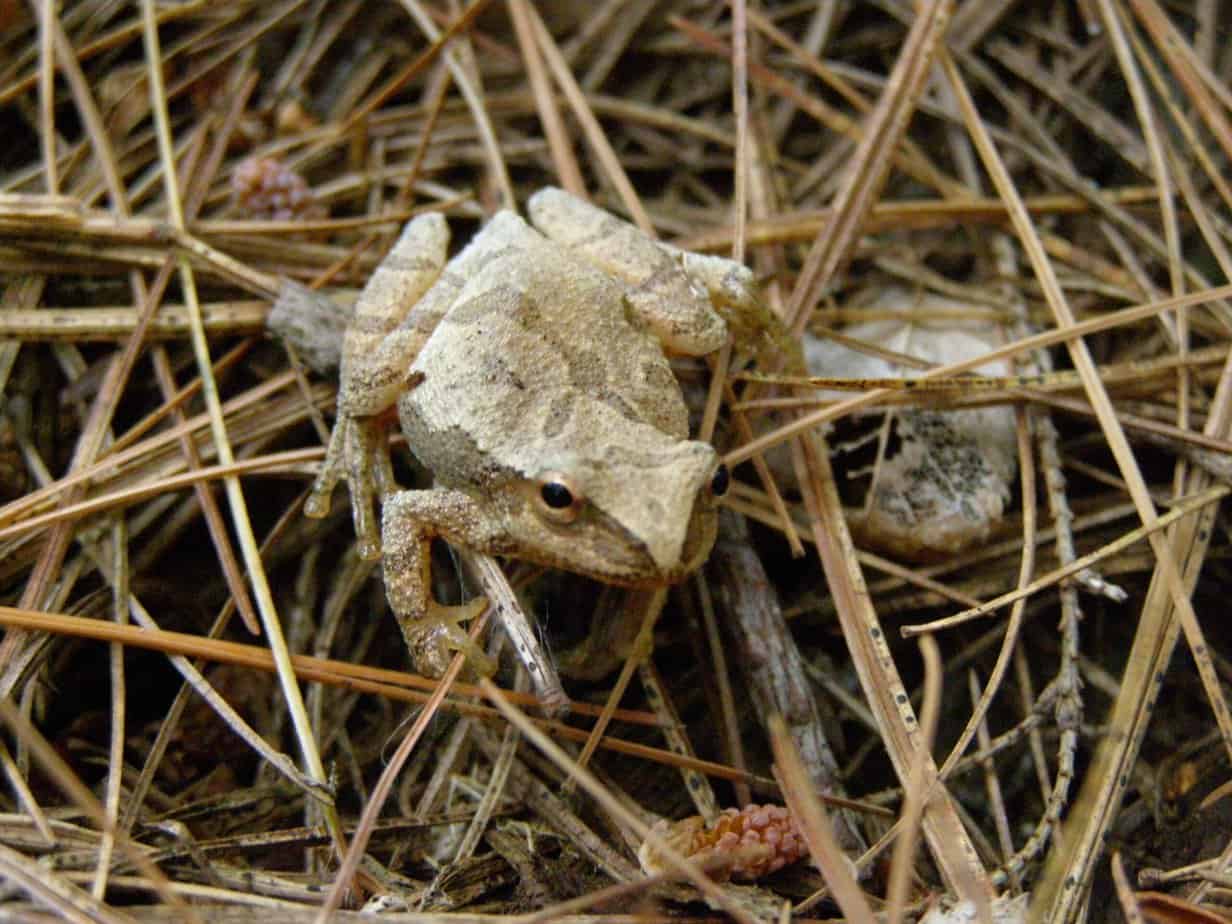
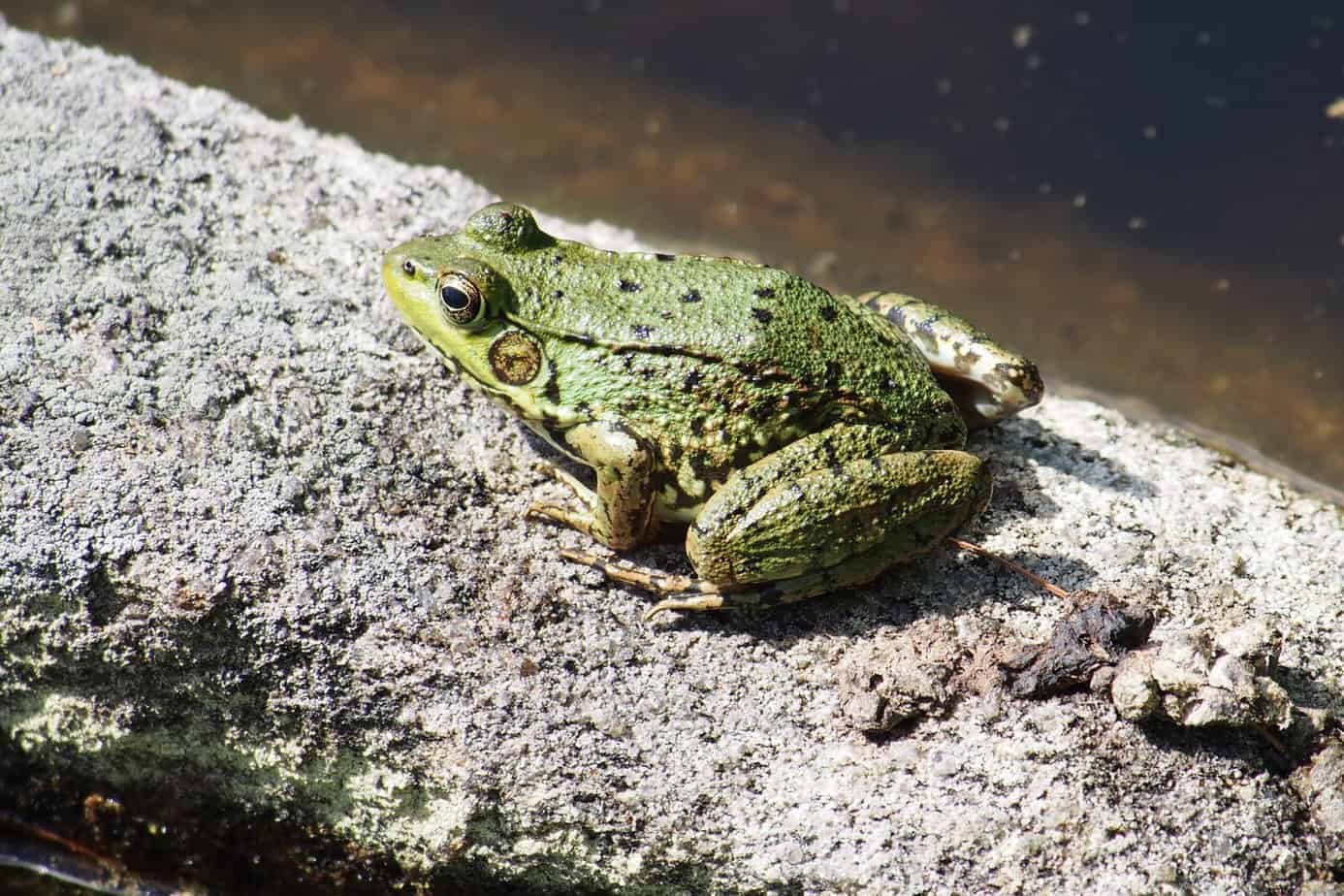
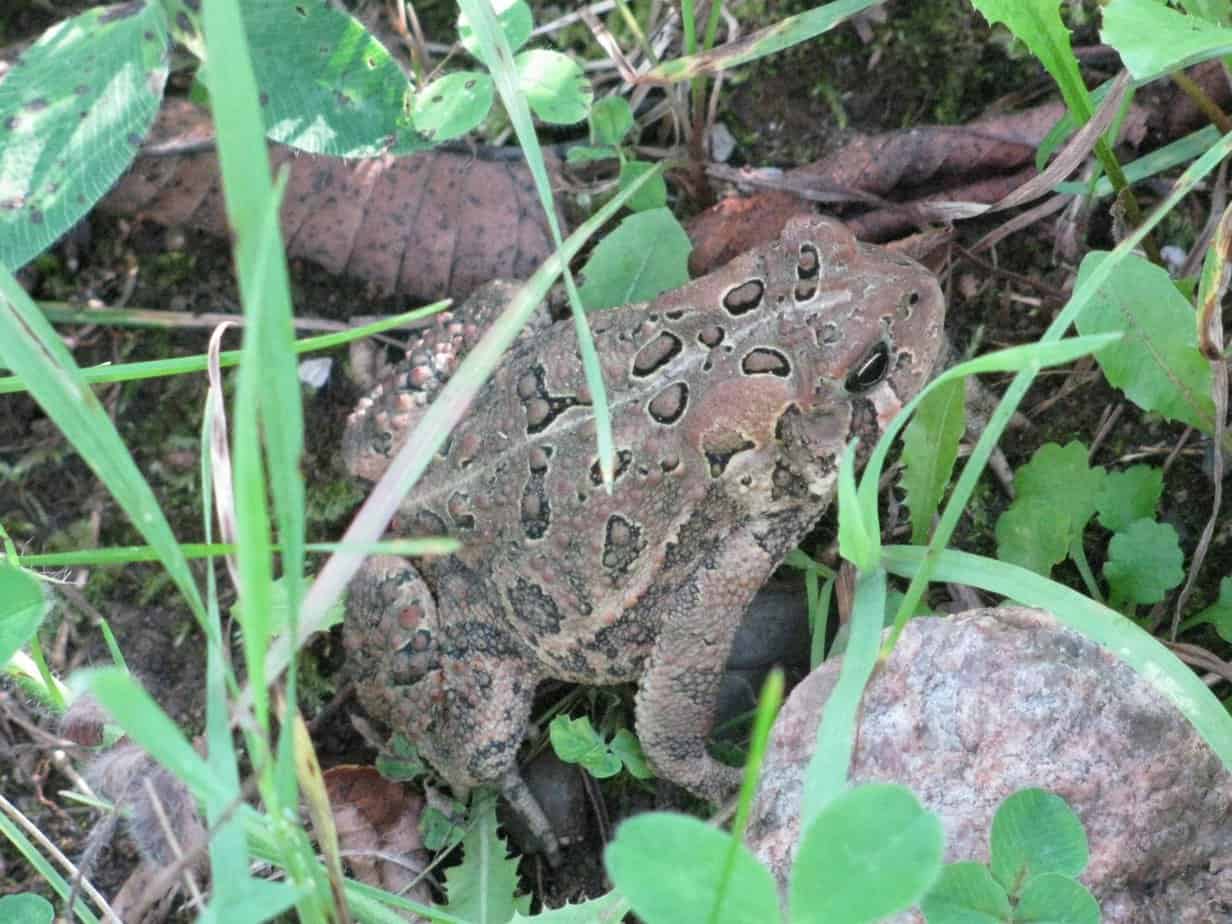
__13. Striped skunks, raccoons and black bears retreat to their winter quarters but will come out on warm days. They are not true hibernators.
__14. Mosses, club‑mosses, lichens and several species of evergreen ferns stand out against the brown leaf litter of the forest floor and deserve close observation.
__15. Surprisingly enough, November’s average number of days with rain is no more than during the summer months.
__16. Monarch butterflies are arriving now in large numbers on their wintering grounds in the Sierra Madre mountains west of Mexico City. This year monarchs are expected to cover around 6.5 hectares of forest which is well below the average of nine hectares. This is mostly because of dry conditions over much of the butterfly’s mid-western range this summer.
__17. In our woodlands, the only trees still clinging to some of their foliage are young American beech, sugar maple and ironwood. Many will retain some leaves all winter.
__18. Hard corn is still being harvested this month and green fields of young wheat stand out noticeably. The smell of manure is often in the air as farmers spread it to fertilize their fields in the fall.
__19. Most red‑tailed hawks leave the Kawarthas for more southern climes. On a good day, hundreds can be seen migrating along the north shore of Lake Ontario. Some will actually spend the winter along the lake shore and are a common sight along the 401.
__20. The Pleiades (Seven Sisters) star cluster adorns the eastern sky in the evening.
__21. Muskrats build cone‑shaped lodges and feeding platforms of cattails, rushes and mud. The lodges are only about a metre in height. These animals are easy to observe this month.
__22. Ball‑like swellings on the stems of goldenrod plants become quite visible. These are galls that contain the larva of the goldenrod fly.
__23. Walleye begin to move upstream along large rivers such as the Otonabee. They remain in the rivers over the course of the winter in anticipation of the early spring spawn.
__24. Our local bald eagle population expands with the arrival of birds from northern Ontario. These magnificent raptors will spend the winter in the Kawarthas.
__25. A taste of winter comes in November. The first significant snowfall usually occurs and permanent snow cover is sometimes with us by month’s end.
__26. Male great horned owls stake out breeding territories and become quite vocal. A useful mnemonic to remember their call is “who’s awake…me, too.”
__27. Frost is recorded an average of 20 days this month.
__28. The sound of coyotes calling is typical of November nights.
__29. As long as there is open water, diving ducks and small numbers of loons will continue to linger on local bodies of water including Little Lake in Peterborough.
__30. The Orion constellation’s arrival in the southeast adds to the enjoyment of an evening’s walk in late November.
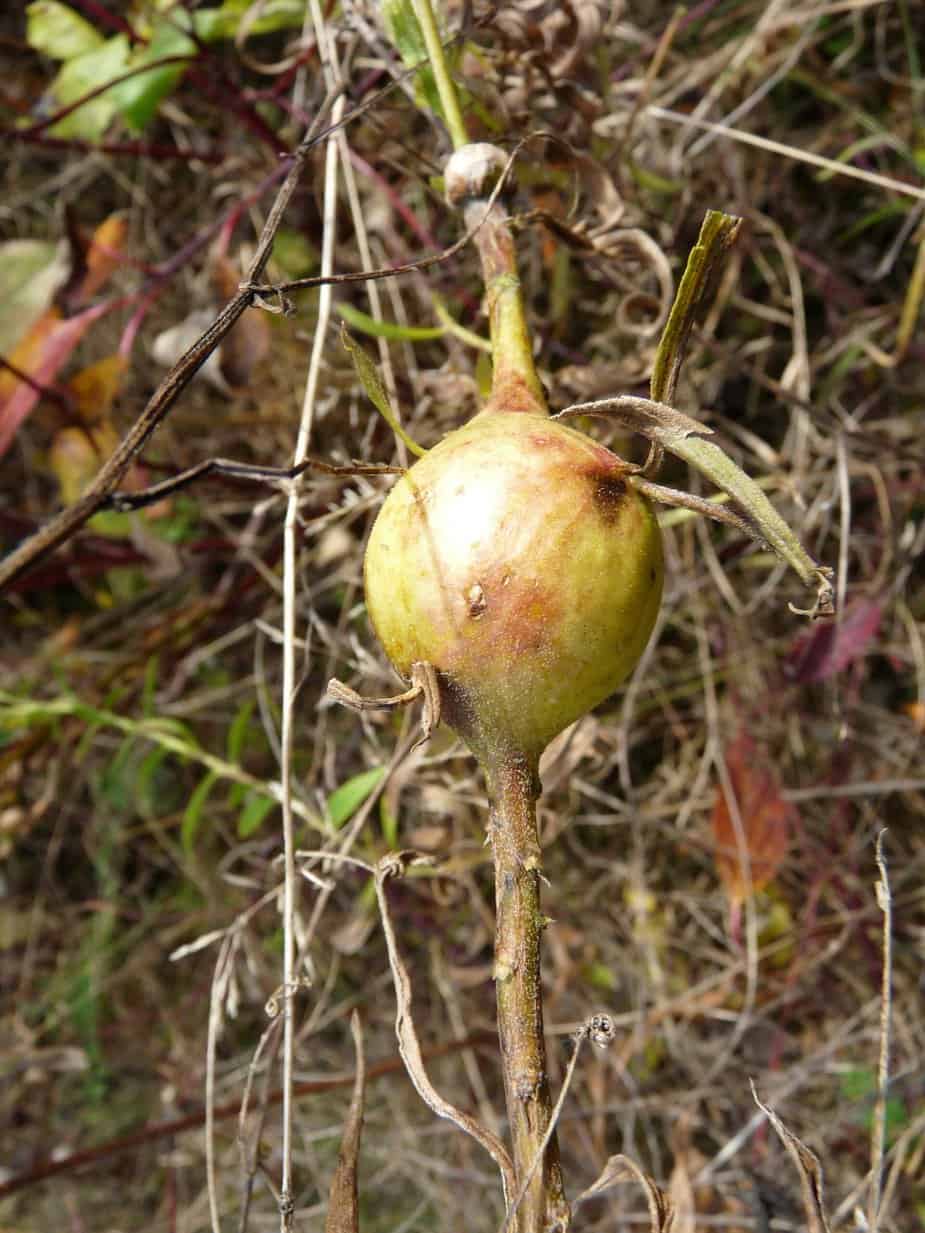

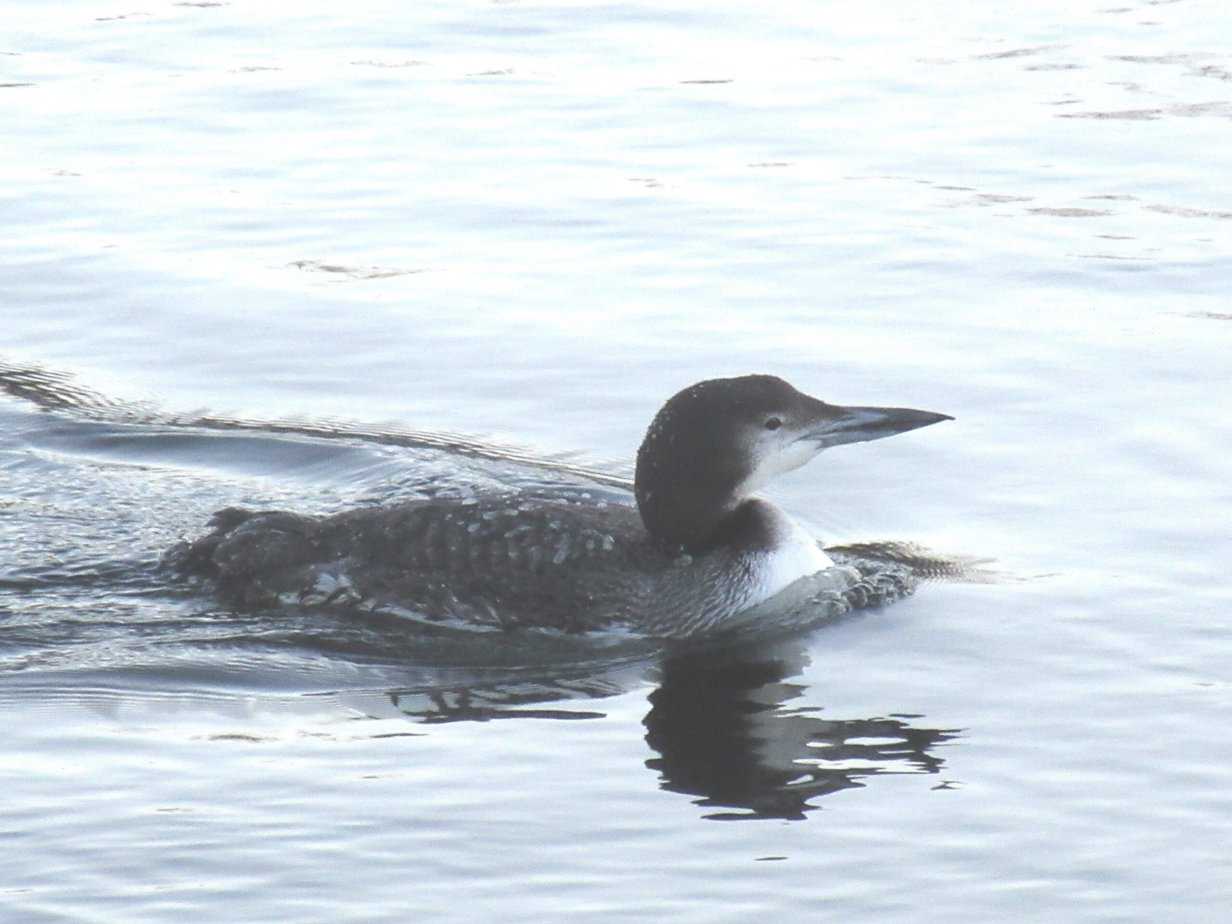
December – The Sun Stands Still
“So the shortest day came, and the year died,
And everywhere down the centuries of the snow-white world
Came people signing, dancing,
To drive the dark away,
They lighted candles in the winter trees;
They hung their homes with evergreen;
They burned beseeching fires all night long
To keep the year alive…
– Susan Cooper, The Shortest Day
With the fall’s first snow now upon us, much of the natural world seems to slip into a gentle slumber. This is certainly not the case for humankind, however, caught up as we are in the frenzy of the holiday season. Not surprisingly, we often forget that a mystic celestial event takes place this month. Just when the sun seems to be on the brink of vanishing completely, it suddenly stops its southward march and essentially “stands still,” hence the word solstice. It will then proceed to move northward once again, to climb higher and higher into the sky and to provide longer and longer days for the next six months. So it was with great joy and relief that ancient cultures on every continent celebrated this life‑affirming event, an event that may even have been a precursor to faith. The Christmas tree, too, proclaims life’s vigour in the face of winter. It fills our homes with the resinous fragrance of the northern forest and is the centrepiece of our holiday decorations.
The natural world provides many other Yuletide adornments, as well: festive winterberry holly fruits, radiant cardinals at our feeders, fluffy chickadee baubles, hoar‑frosted windows, and shimmering icicles. Nature also supplies its own array of sounds for the festive season ‑ the cracking and rumbling of ice forming on the lakes, the shrill scolding of red squirrels, the croaking of ravens patrolling Shield country and the roar of the north wind as it ushers in winter. Although December sees the year come full circle, it is neither an end nor a beginning. Like every other month, it is simply part of an indivisible whole.
__1. Almost all migratory birds that breed in the Kawarthas are now on their wintering grounds. Most hummingbirds choose the Yucatan Peninsula, Baltimore orioles fly all the way to Costa Rica and large numbers of robins spend the winter in South Carolina. Some robins also overwinter in the Kawarthas each year.
__2. Throughout the late fall and winter, gray squirrels are often seen high up in maple trees feeding on the keys.
__3. You may still see farmers harvesting hard corn this month. Even though the plants are dry, withered and often frozen, they still have excellent food value.
__4. A December moon rises about 30 degrees north of due east and sets 30 degrees north of due west.
__5. Ducks lingering until freeze‑up usually include common goldeneyes, common mergansers, hooded mergansers, mallards, and American black ducks. A small number of common loons, too, often remain quite late.
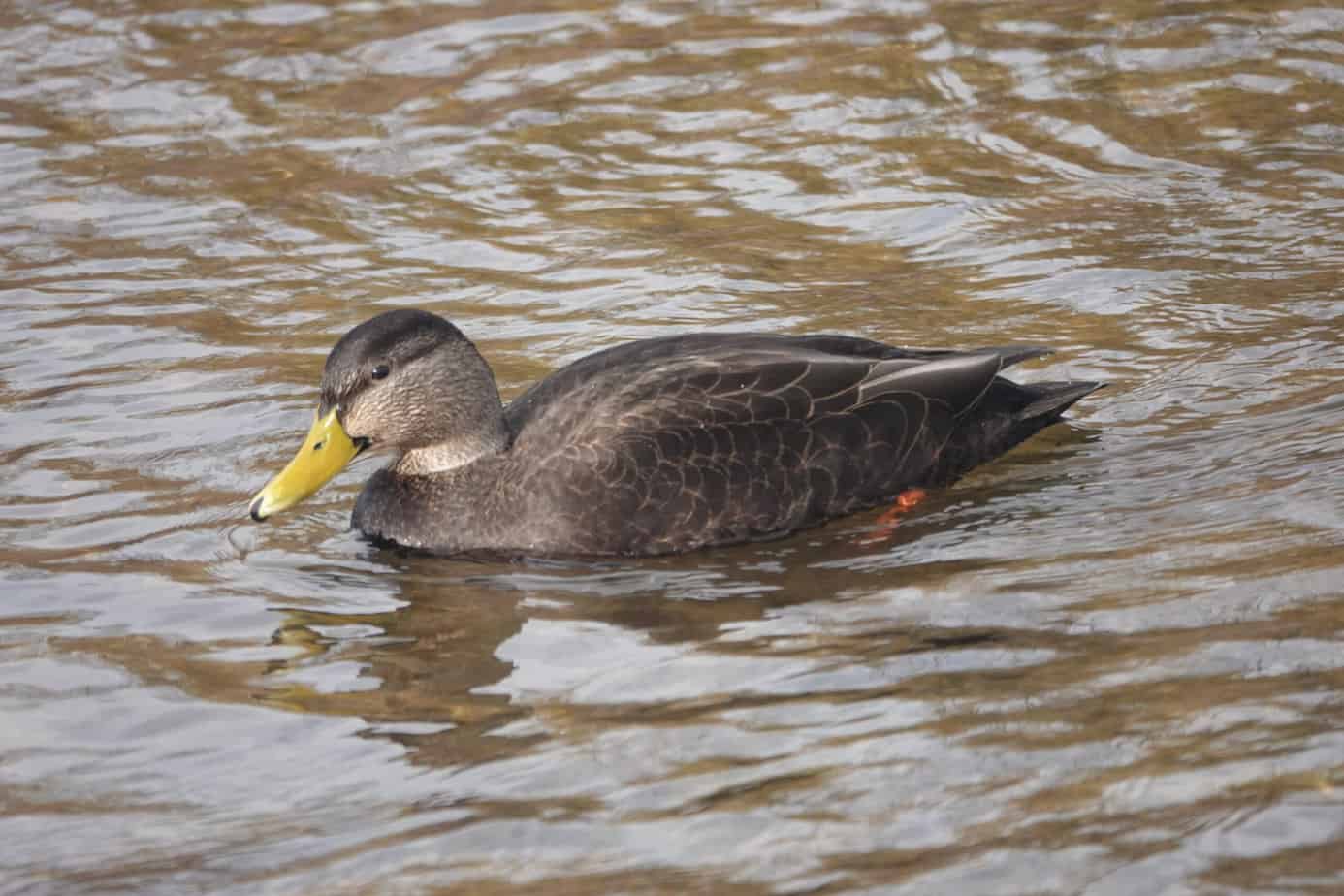
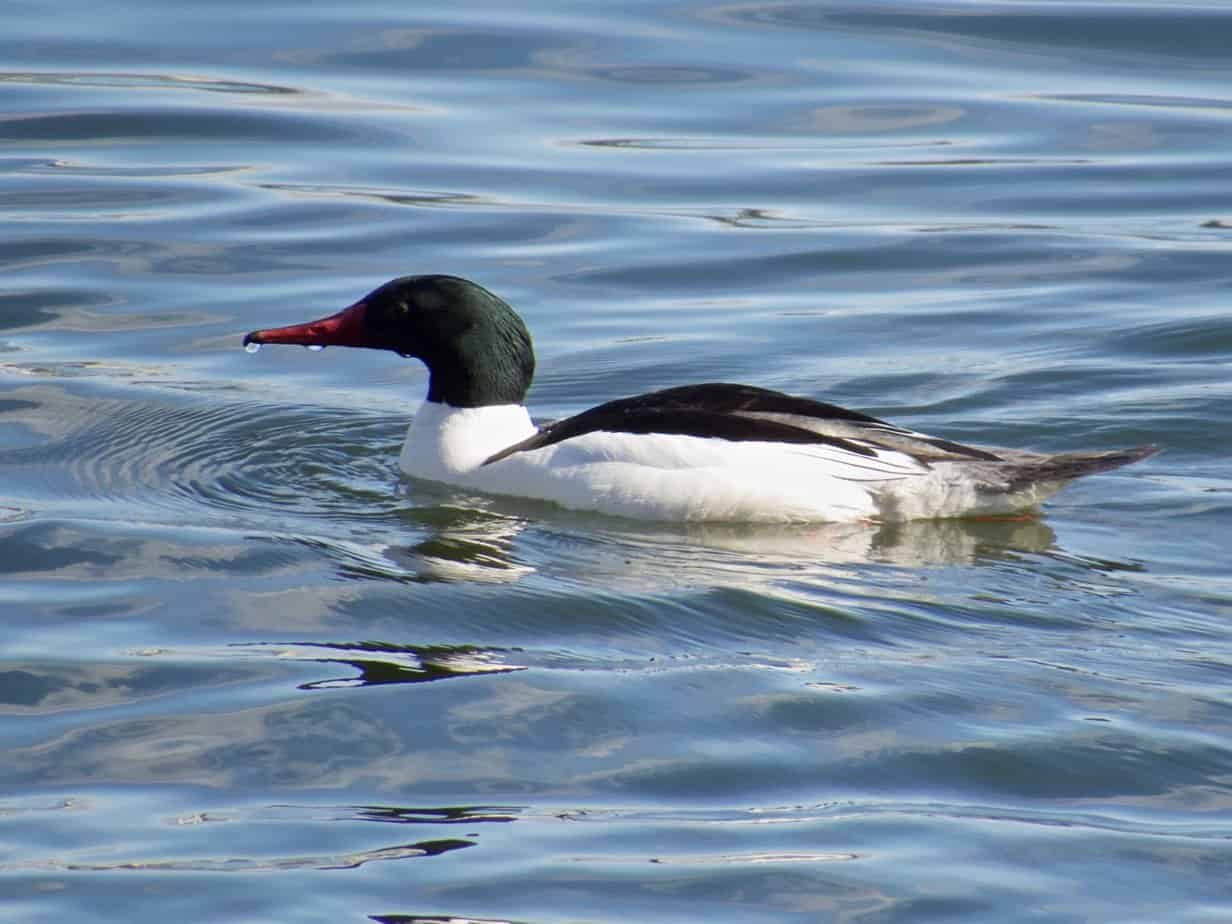
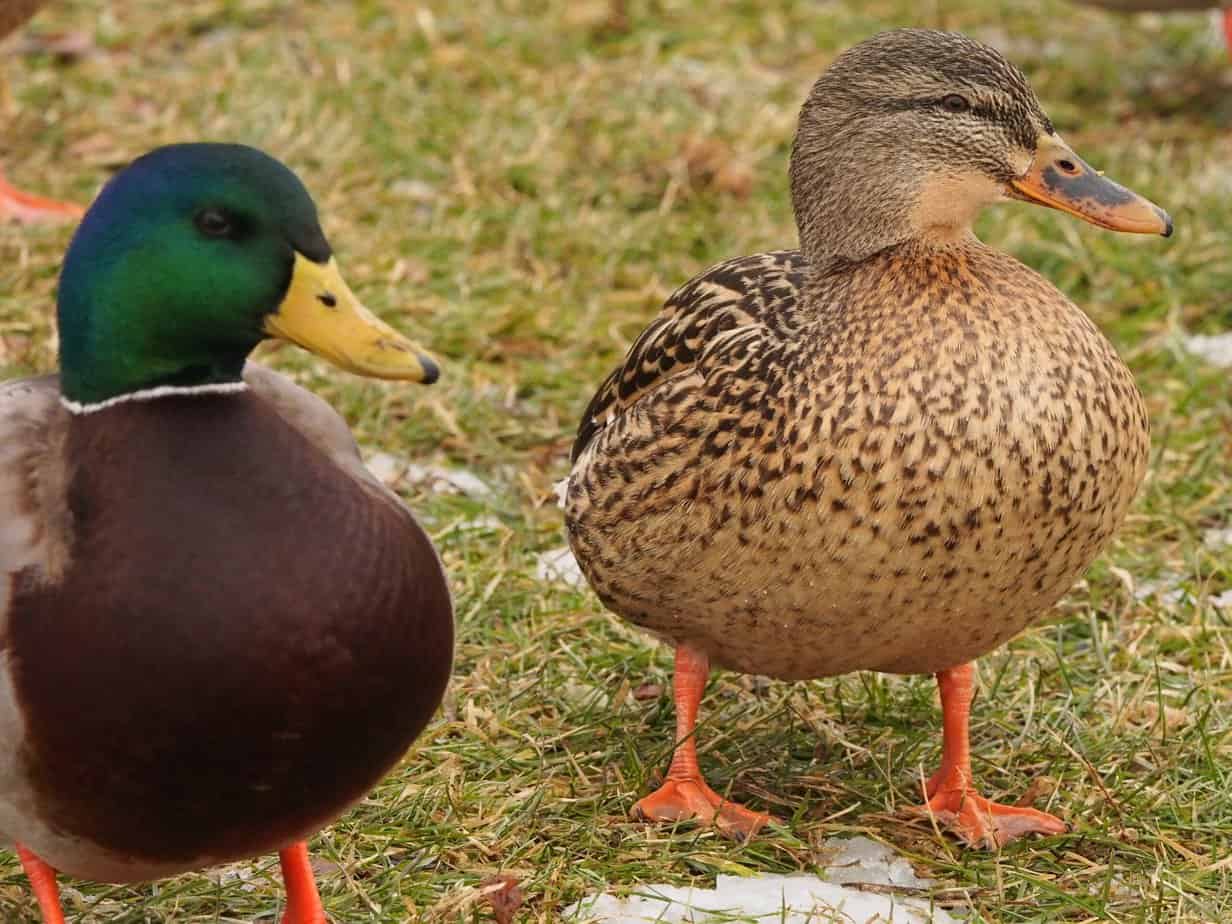
__6. In early December, the easily‑identifiable constellation Cassiopeia looms like a big letter “M” in the north sky in the evening. The Inuit imagined the shape as a pattern of stairs sculpted in the snow.
__7. Balsam fir makes the perfect Christmas tree – a symmetrical shape, long-lasting needles, and a wonderful fragrance. Buy a real tree is a better environmental choice than purchasing an artificial tree.
__8. Great black‑backed, lesser black-backed, glaucous, and Iceland gulls often turn up on Little Lake where they can sometimes be seen sitting on the T-wharf.
__9. Most years, a small number of snowy owls arrive in the Kawarthas this month. The concessions east and west of Lindsay are often the best place to see them.
__10. Loons sometimes become trapped in the ice when an expanse of open water freezes overnight. Iced‑in birds can fall prey to bald eagles.
__11. On local lakes such as Jack, Katchewanooka, Buckhorn, and Stoney, eagles are sometimes seen sitting on the ice near open water or perched in nearby trees.
__12. In past decades, all of the Kawartha Lakes were usualy frozen by December 12th. However, freeze-up is often much later now as a result of climate change.
__13. The Geminid meteor shower usually peaks around the 12th to 14th of the month. It is thought to be intensifying every year. Recent showers have seen 120‑160 meteors per hour under optimal conditions.
__14. Skunks may emerge from their winter slumber to search for food during mild spells.
__15. The red squirrel’s coat is now a brilliant russet. It is also much thicker than the summer coat.
__16. White spruce and eastern hemlock release their seeds during late fall and winter. It is not uncommon to find the snow beneath these species powdered with seeds. The cone crop on spruce trees this year is the heaviest in recent memory.
__17. Between mid‑December and early January, Christmas Bird Counts take place across North and Central America. There are two local counts: the Peterborough Christmas Bird Count and the Petroglyphs Christmas Bird Count.
__18. “Nip twigs” on the ground below conifers are a sure sign of red squirrel activity. Squirrels nip off the tips of conifer branches allowing the twig to fall to the ground. They then scurry down the tree, remove the cones and buds, and leave the rest of the twig there. The buds are usually consumed immediately.
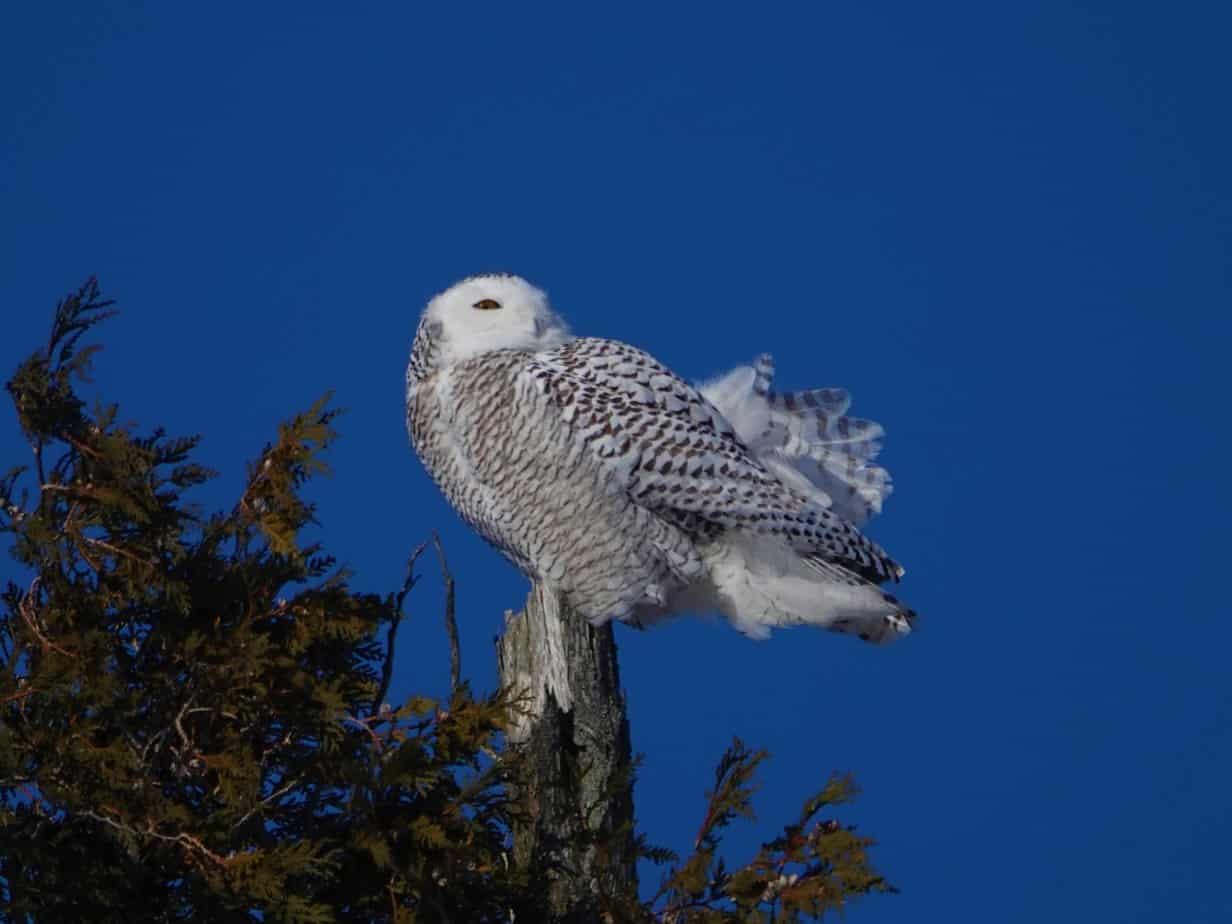
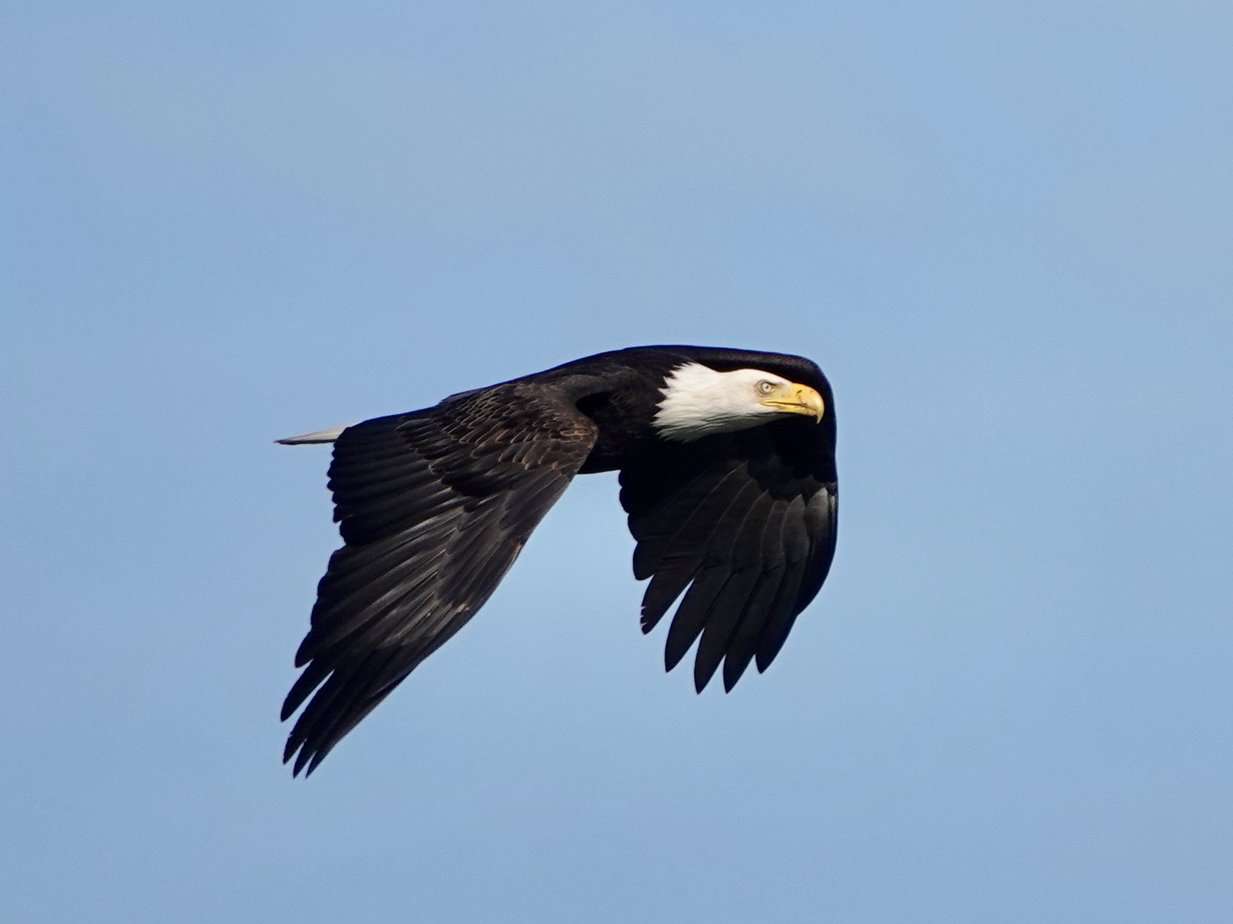
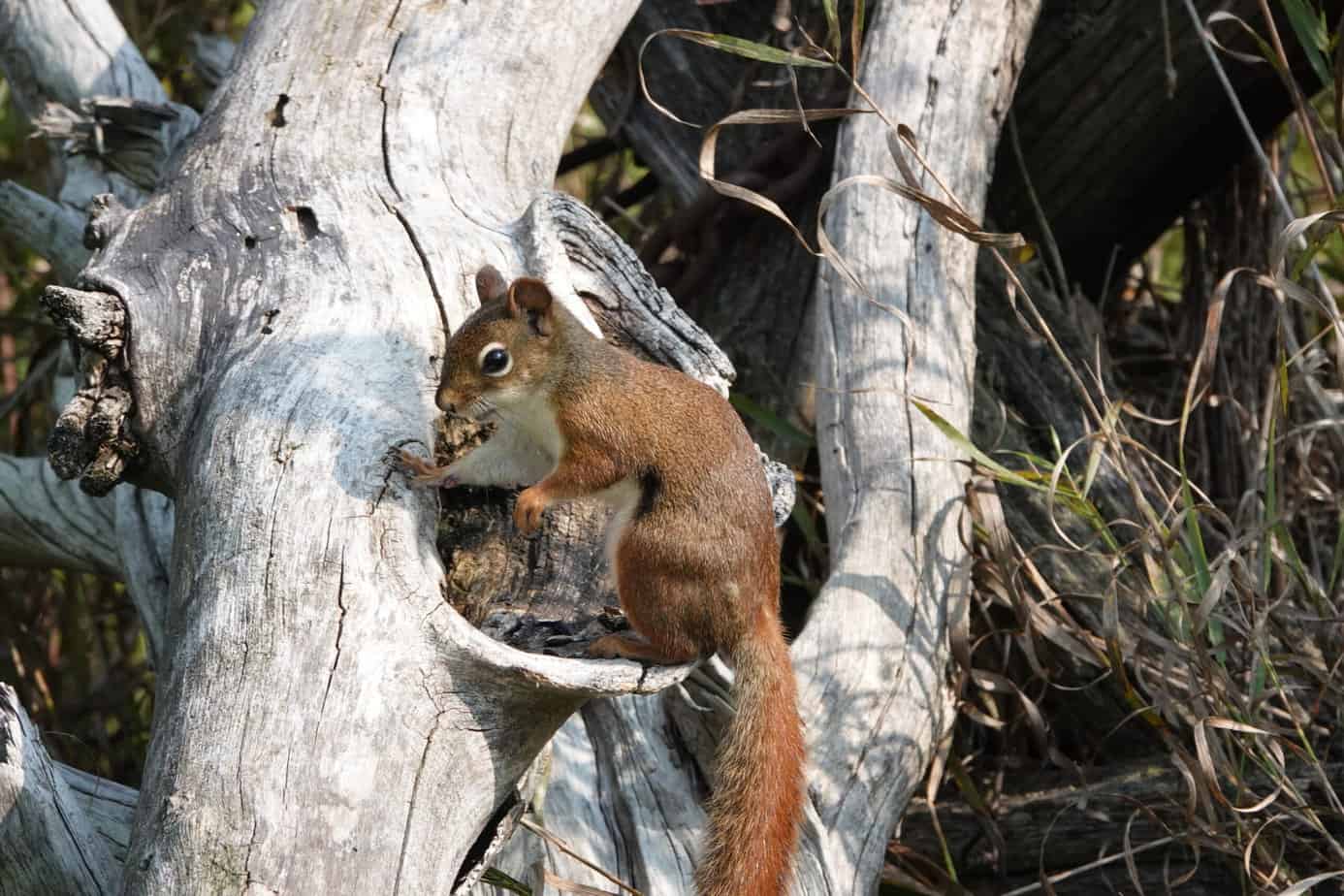
__19. By 8 p.m., the Andromeda galaxy is nearly directly overhead. At 2.2 million light years away, it is the farthest celestial object detectable with the naked eye.
__20. December is the peak calling month for both the eastern screech-owl and the great horned owl.
__21. December 21 or 22 (depending on the year) marks the winter solstice, the shortest day of the year and the first official day of winter. The sun rises at its southernmost point on the eastern horizon, and sets at its southernmost point in the west. Sunrise is not until about 7:45 am, while sunset is upon us by about 4:35 pm! This means that it traces its lowest and shortest trajectory of the year through the southern sky. With nights as long as June days, it’s no wonder that the ancients prayed that the sun would not disappear altogether.
__22. Moose shed their antlers between now and February.
__23. The last of our local “giant” Canada geese usually depart in late December. Most go no further south than Pennsylvania.
__24. When viewed from a distance, the upper branches of white birch create a beautiful purple haze in the forest canopy.
__25. The chance of having a white Christmas in the Kawarthas is over 80%.
__26. In the southeast night sky, look for the Winter Six: Orion, Taurus, Auriga, Canis Major and Canis Minor. The winter constellations shine brightly and are easy to pick out.
__27. A huge bank of clouds along the horizon is a common winter sight when you look south from Peterborough on a clear day. These clouds form over Lake Ontario as a result of water vapour rising from the relatively warm lake and condensing in the colder air above.
__28. Cooper’s hawks are quite common in the city during the winter months. They are probably attracted by the large number of prey species such as starlings and mourning doves to be found in built up areas. These hawks fly with a characteristic flap‑flap‑glide style and can be easily identified at considerable distances. Most years, a small number of merlins can also be seen.
__29. Watch for overwintering birds such as robins feeding on clusters of mountain‑ash berries, wild grape, sumac, and European buckthorn.
__30. If you live outside of the city near a forest or woodlot, you may have flying squirrels providing nightly entertainment at your bird feeder. They are quite tame.
__31. Even though the days grow longer after the winter solstice, the increase in daylight is in the afternoon, not in the morning.
